White House Adviser: US Must Prepare for Asteroid
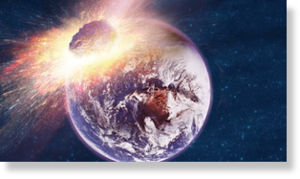
The
White House has asked Congress to consider how to best deal with the
potential threat to Earth of an impact with an asteroid from space.
If
an asteroid were on a collision course with Earth, would we be ready to
defend against its destructive impact or would we be helpless and
defenseless?
NASA, America's space agency, is being charged with leading the way to
protect not only the U.S. but the entire world in the event of such a
horrifying scenario. And a top White House science adviser says we have
to be prepared.
In separate 10-page letters
to the House Committee on Science and Technology and the Senate
Committee on Commerce, Science and Transportation, John Holdren,
director of the White House Office of Science and Technology Policy, or
OSTP, outlines plans
for "(A) protecting the United States from a near-Earth object that is
expected to collide with Earth; and (B) implementing a deflection
campaign, in consultation with international bodies, should one be
necessary."
The White House has asked Congress to consider how to best deal
with the potential threat to Earth of an impact with an asteroid from
space.
While Holdren indicates that no large asteroid or comet presents an
immediate hazard to our planet, the fact that devastating impacts have
occurred on Earth in the distant past is enough to warrant safety
precautions for the future.
"Indeed, a steady stream of these objects enters the Earth's atmosphere
on a daily basis, consisting mostly of dust-sized particles and
estimated to total some 50 to 150 tons each day," Holdren wrote.
As remote as it may seem that Earth could be the target of a giant rock
from space, nevertheless, Holdren insists that "the possibility of a
future collision involving a more hazardous object should not be
ignored."
Asteroids are rocky bodies found within the inner solar system,
originating in an area known as the asteroid belt, located between the
planets Mars and Jupiter.
If a large asteroid were to strike Earth, it could cause a global
climate change, which many scientists believe is what caused the
extinction of the dinosaurs more than 60 million years ago -- not a good
prospect for life on Earth in the present day if a similar event
occurred.
NASA's Near Earth Object program, or NEO, looks for and monitors asteroids that are at least a kilometer in diameter.
But, as Holdren points out, one problem in the search is that "the
orbits of known objects can be changed by gravitational or solar
radiation perturbations, or even collisions with other objects, meaning
that periodic monitoring of known NEOs must also be conducted."
Numerous movies have depicted the devastation caused by an asteroid
collision with Earth, including "Meteor" (1979), "Deep Impact" (1998)
and "Armageddon" (1998).
After 12 years of cosmic hunting, NASA search teams have determined that
149 NEOs larger than a kilometer in size are in orbits that might pose a
problem for Earth, but none is considered an impact threat in the next
100 years.
The White House OSTP office is working to establish plans and procedures in the event of a possible NEO threat to America.
One of those plans involves using the Federal Emergency Management
Agency, in the Department of Homeland Security, to handle
responsibilities on the ground regarding an NEO threat.
After an asteroid-to-Earth trajectory is determined to impact an area of
the U.S., FEMA would notify the population through the National Warning
System and it would begin emergency response activities.
Holdren's letter also indicates the importance of notifying other
countries of an impending asteroid strike "in an effort to minimize the
potential loss of life and property."
And there's the hope that, if an asteroid becomes an actual threat to
our planet, a plan would be implemented to try to somehow either destroy
the rock or deflect it off course.
Holdren suggests to Congress that NASA and the Department of Defense
should work together to devise any strategy that would involve the
military.
So the good news is that high-level discussions are on the plate as to
how Earth can defend itself against the onslaught of a potential
disaster from space.
The bad news: There's no plan set up yet. For the time being, we're staying out of harm's way.
Here is the entire text of Holdren's letter to Congress.
Flashback:
The Science Cartel vs. Immanuel Velikovsky
In 1950, Immanuel Velikovsky culminated decades of research with a book titled Worlds in Collision
that "proposes that many myths and traditions of ancient peoples and
cultures are based on actual events." His approach was
interdisciplinary, a rarity in the 20th century, taking into account
astronomy, physics, chemistry, psychology, ancient history, and
comparative mythology.
He noted, for example, that Venus,
the second brightest object in the night sky, was not mentioned by the
earliest astronomers. He proposed that the planet was a newcomer to our
solar system, a comet, appearing in historical times with an irregular
orbit that caused catastrophic events on our own planet.
Coming in close contact with the Earth, the latter's rotation altered, making it appear that The Sun had stood still, a phenomenon reported on in the Book of Josue. What has come to be known as Joshua's Long Day
is corroborated by the texts of the ancient Chinese, Japanese,
Egyptians, Babylonians, and Mayans; the East Asians reporting a
extremely long sunset, the Mexicans reporting an extremely long sunrise.
Immanuel Velikovsky was too eminent a scholar to be dismissed outright as a kook, and he counted some respected people among his friends. (See The Einstein-Velikovsky Correspondence). Nevertheless, his Catastrophism was rejected outright by a scientific establishment that couldn't stomach an interdisciplinary challenge to its dogmatic Uniformitarianism, even after Velikovsky's predictions about the temperature of Venus and radio activity from Jupiter were proven true.
Stephen Jay Gould
summed up mainstream scientific opinion, saying, "Velikovsky is neither
crank nor charlatan - although to state my opinion and to quote one
of my colleagues, he is at least gloriously wrong ... Velikovsky would
rebuild the science of celestial mechanics to save the literal accuracy
of ancient legends." Velikovsky would counter that "the ancient
traditions are our best guide to the appearance and arrangement of the
earliest remembered solar system, not some fancy computer's
retrocalculations based upon current understanding of astronomical
principles."
While recognized as "neither crank nor charlatan," Velikovsky and his
ideas were denied a hearing in what same to be known as the "Velikovsky
Affair."
Australian philosopher David Stove, took up the Velikovskian cause in a 1972 essay - "The Velikovsky story: the scientific mafia."
He begins, "The story of Velikovsky's theory, its reception, and its
subsequent confirmations, constitutes one of the most fascinating
chapters in the entire history of thought; and it is one which is still
unfolding."
While acknowledging the book's "enormous appeal to what I call the
'anti-fluoride belt' in modern societies," he says "the books convinced
me of two things: that a thesis of extraterrestrial catastrophes in
historical times is at least a distinctly live option; and that in
historical times Venus has done- something peculiar, at any rate."
Prof. Stove notes the book "became the target of nearly universal abuse
and derision" and "[t]he professional scientists' campaign against Worlds in Collision
began well before the book appeared" and resulted in, among other
things, its author being "rigorously excluded from access to learned
journals for his replies," "the sacking of the Senior Editor of
Macmillan responsible for accepting the Velikovsky manuscript," "the
sacking of the director of the famous Hayden Planetarium in New York,
because he proposed to take Velikovsky seriously enough to mount a
display about the theory," and "Macmillan finally cav[ing] in, and
prevailed on Velikovsky to let them transfer their best-selling property
to a competitor, Doubleday, which, as it has no textbook division, is
not susceptible to professorial blackmail."
Prof. Stove also "mention[s] some of the more startling pieces of
evidence that have come to light since Velikovsky published." It was he
who gave "altogether novel importance to electrical and magnetic forces
in the solar system" and who "said that the earth must have a
magnetosphere much stronger, and extending much further into space, than
anyone else believed possible." He also "predict[ed] that Jupiter would
be found to be a radio source, long before the astonished
radio-astronomers found it so." Most interesting was what he said about
the second planet:
According to Velikovsky, there were all over the world, as folklore
alleges, rains of burning pitch. This, among other things, led him to
assert in 1950 that the clouds of Venus must be very rich in petroleum
gas. All contemporary knowledge of the chemistry of the planet's
clouds was flatly against it. Yet it has turned out to be so. If you
think this is a bit creepy, you have heard nothing yet.
According to Velikovsky in 1950, Venus must still be very hot, because
of the circumstances of its recent birth and subsequent career. The
astronomers had long "known" that it was cool, and as late as 1959
accepted estimates of its temperature, such as 59 degrees centigrade,
were still being revised slightly downward. Yet it has turned out that
the planet has a surface temperature around 800 degrees Fahrenheit.
This would be hard enough to reconcile with any "uniformitarian" theory
which requires a common origin for all the planets. But worse was to
come. For Mariner II put it beyond doubt that the rotation of Venus is
retrograde - that is, while it revolves in the same direction as
that in which all the other planets both revolve and rotate, it
rotates in the contrary sense! No doubt ad hoc amendments will be
tried, to fit this fact into conventional theories of the origin of
the planets (just as desperate ad hoc amendments to a "greenhouse"
theory are still being made to account for the temperature); but this
one will test their ingenuity, that is certain.
Prof. Stove offers an observation "quite independent of the question
whether Velikovsky's theory is true," suggesting that "it is on
professional science itself that the case throws the most revealing
light." He says, "The great Italian probability-theorist, de Finetti,
speaking in 1964 about Velikovsky's case, compared the scientific
complex to a 'despotic and irresponsible Mafia.'"
Say what you will of Velikovskian cosmology, more scientists themselves
are questioning whether it is right to dismiss outright celestial events
as described in ancient texts, as this article suggests - The Odyssey astronomically accurate?
And exciting news just today that the largest planet of our solar
system "snared a passing comet in the middle of the last century,
eventually releasing it 12 years later," rings a Velikovskian bell - Jupiter had temporary moon for 12 years.
Whatever conclusions one may come to on this matter, it raises
interesting questions about the tyrannical conformity of thought that
plagues not only the scientific but also the economic and political
spheres as well. Are not proponents of the Austrian School of Economics similarly marginalized by the academic cartel, as are advocates the traditional United States non-interventionism by the political cartel? Alternative medicine's long history of suppression by the American Medical Association is also a parallel.
The thoughts of Frank Furedi,
who recently suggested that "deference to traditional authority has
given way to the reverence of expertise," come to mind - Specialist pleading.
The author noted, "Unlike traditional authority, which touched on every
dimension of the human experience, the authority of the expert was
confined to that which could be exercised through reason."
Like Velikovskianism, both Austrianism and Non-interventionism
touch on more dimensions of the human experience than do the
"mainstream" approaches to economics and foreign policy they oppose. Velikovskianism appeals to the traditional authority of ancient texts; Austrianism appeals to the traditional authority of the discoveries of the School of Salamanca, and Non-interventionism to the traditional authority of the Founders.
Also, just as many insights of Velikovskian Catastrophism were confirmed and are still being confirmed, as the search for Moon Water attests, the many insights of the "anti-war, anti-state, pro-market" philosophies that gird LewRockwell.com have been confirmed and are being confirmed, especially within the past year.
Fascinating as the cosmological speculations detailed above are, they
are far less convincing than the economic and political ideas mentioned
in the last paragraphs. It is nothing less than scandalous that these
are denied a hearing.
---
An American Catholic son-in-law of Korea, Joshua Snyder [send him mail] lives with his wife and two children in Pohang, where he lectures English at a science and technology university. He blogs at The Western Confucian.
US: A Fireball in the Sky
Tonight
I was out at the jetty at Westport taking pictures of the sunset. I
caught a 'fireball' in the sky out of the corner of my eye. This is what
I saw and took these pictures. It appeared from nowhere, fell for about
2 minutes then disappeared. Is it a meteor?
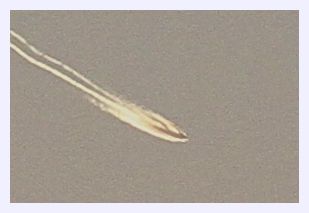
© Komo News
The 10 Leading Theories For Dead Birds And Fish
As the mainstream media attempts to downplay the latest die-off
event, which has now gone global, it is worthwhile to keep track of the
story lines. Feel free to add your own to the comments section, and we
will update accordingly.
Mainstream Explanations: Lightning, hail,
mid-air collision, power lines, and New Year fireworks for the birds . .
. but disease for the fish. This is even rolling eyes in the
mainstream media. Birds are incredibly sensitive to their environment
(think canary in the coal mine), and the thought that they were caught
by surprise, or that they "fowled" up their flight pattern is patently
ridiculous. And where are the roasted birds from this lightning strike?
And what about fish dying in the same region? Just a "disease"
coincidence. One mainstream headline has to be enshrined as the saddest
attempt at sensationalism, while revealing an obvious natural
conclusion Falling Birds Likely Died From Massive Trauma. Really?
Meteor showers: We are in a period of intense seasonal meteor showers, and several perennial YouTubers reported hearing sonic booms in the area that could have indicated a local shock wave.
This would be one non-conspiratorial, natural cause that actually
makes sense, but it is hard to connect to both birds and fish, unless it
produced a disabling frequency. There were indeed other sound
anomalies according to the report highlighted above.
New Madrid Fault Line: An excellent article by The American Dream collated data about the recent earthquake activity along this fault line that runs along the mid-eastern section of the U.S. Combined with gas fracking,
the immense geological activity in the region, and the BP oil drilling
disaster, which off-gassed the dispersant, Corexit, into the
atmosphere, and we should be wondering about any mass deaths in the
region. Nevertheless, this has turned into a global event, so the above
could be a side effect of something larger, or a direct contributing
factor.
Government testing: The long history of government testing has been exposed by many researchers.
The strange component to this die-off is that only certain species
have been affected, but within the entire region. And some reports have
indicated that the organs of these birds were liquefied, which could
indicate a possible virus. Could this implicate species-specific
bio-weapons? It is on record that discussions have taken place about race-specific bio-weapons; perhaps this is a test of delivery capability?
GMO mutation: Mike Adams of Natural News sets forth an interesting theory:
this latest event is local, but the die-offs are happening across
species as bee populations and bats are also declining. Adams points
out that Monsanto has a corporate office in Arkansas. Just wondering.
Geoengineering: Could spraying in the area
have caused this type of fallout? Perhaps something new added to the
mixture? Chemtrails have quickly moved from conspiracy theory to documented fact.
So much so, that the powers-that-be have had to admit to the program,
but a beneficial one in their view. Between cloud seeding and possible
connections to HAARP, chemtrail fallout must be considered, especially
as it is being conducted nearly worldwide. Rosalind Peterson has been
at the forefront of connecting geoengineering to GMOs
as a combined source for oxygen-depleting algae blooms that very well
could affect a wide spectrum of natural systems. Furthermore, some
believe that the delivery system for chemtrails can also disperse
pathogens. If there is a flu or disease outbreak in the coming days or
weeks among the human population in areas where the birds have fallen,
the chemtrail connection could be made. If this happens, the contagion
could be blamed on a new, deadly bird flu. A last possibility connected
to chemtrails would be nanoparticles.
HAARP: Birds and fish can be susceptible
to subtle frequency alteration. An interesting YouTube post from a
long-time fisherman mentioned the "pearl" plate
behind the eye of the affected type of drum fish in this event. He
made a plea for anyone in the area to look for signs of damage to this
plate. Both birds and fish navigate in highly coordinated ways that
indicate that they move and communicate via frequencies. Could the HAARP array in Alaska
have short-circuited their navigation systems? Or, perhaps this is the
beginning of a cascading effect from decades of electromagnetic
pollution emanating from EMF and ELF waves shot around the planet via a
wide range of modern communications.
Scalar Weapons: These directed energy beam weapons can be deployed via satellite and create a wide range of "natural disasters" that can be tuned to certain frequencies.
Their radius is reported to be several miles. Even crazier is that we
have been told that the dead birds encountered massive trauma. One of
the reported abilities of scalar weapons is to create a Tesla shield
of plasma, like a bubble, that could explode anything that enters its
airspace. Some have speculated that this technology is in full
operation. But what if it truly is still at the testing phase?
Remember, this is happening in South America, too.
Project Blue Beam: Were they testing a
sound generator for the global theater of alien invasion? This one is
"out there" for sure, but NASA itself has announced its preparation for
such a scenario. Project Blue Beam,
like its counterpart HAARP, uses the natural energy present in the
ionosphere as both a visual and acoustical device. Again, perhaps they
are not at the ready stage yet, but, like Tesla, have made an unintentional misstep.
Geomagnetic and other Earth changes: As
anyone can see from the above range of possibilities, we are facing an
array of human tampering. However, the backdrop to this are the
anomalies beginning to take form with the apparent wandering of our
magnetic pole, as even National Geographic reported that the north magnetic pole is racing toward Russia. Add to this a dwindling magnetosphere and falling oxygen levels, and the deaths among more delicate species might portend a larger problem. Finally, an increase in sun activity and magnetic storms might be weakening our overall natural habitat.
The widespread die-off of nature should lead us to look more intently at
the world around us, and to question our relationship to it, and our
effect upon it. Perhaps this is what we should have been doing all
along.
The 10 Leading Theories For Dead Birds And Fish
As the mainstream media attempts to downplay the latest die-off
event, which has now gone global, it is worthwhile to keep track of the
story lines. Feel free to add your own to the comments section, and we
will update accordingly.
Mainstream Explanations: Lightning, hail,
mid-air collision, power lines, and New Year fireworks for the birds . .
. but disease for the fish. This is even rolling eyes in the
mainstream media. Birds are incredibly sensitive to their environment
(think canary in the coal mine), and the thought that they were caught
by surprise, or that they "fowled" up their flight pattern is patently
ridiculous. And where are the roasted birds from this lightning strike?
And what about fish dying in the same region? Just a "disease"
coincidence. One mainstream headline has to be enshrined as the saddest
attempt at sensationalism, while revealing an obvious natural
conclusion Falling Birds Likely Died From Massive Trauma. Really?
Meteor showers: We are in a period of intense seasonal meteor showers, and several perennial YouTubers reported hearing sonic booms in the area that could have indicated a local shock wave.
This would be one non-conspiratorial, natural cause that actually
makes sense, but it is hard to connect to both birds and fish, unless it
produced a disabling frequency. There were indeed other sound
anomalies according to the report highlighted above.
New Madrid Fault Line: An excellent article by The American Dream collated data about the recent earthquake activity along this fault line that runs along the mid-eastern section of the U.S. Combined with gas fracking,
the immense geological activity in the region, and the BP oil drilling
disaster, which off-gassed the dispersant, Corexit, into the
atmosphere, and we should be wondering about any mass deaths in the
region. Nevertheless, this has turned into a global event, so the above
could be a side effect of something larger, or a direct contributing
factor.
Government testing: The long history of government testing has been exposed by many researchers.
The strange component to this die-off is that only certain species
have been affected, but within the entire region. And some reports have
indicated that the organs of these birds were liquefied, which could
indicate a possible virus. Could this implicate species-specific
bio-weapons? It is on record that discussions have taken place about race-specific bio-weapons; perhaps this is a test of delivery capability?
GMO mutation: Mike Adams of Natural News sets forth an interesting theory:
this latest event is local, but the die-offs are happening across
species as bee populations and bats are also declining. Adams points
out that Monsanto has a corporate office in Arkansas. Just wondering.
Geoengineering: Could spraying in the area
have caused this type of fallout? Perhaps something new added to the
mixture? Chemtrails have quickly moved from conspiracy theory to documented fact.
So much so, that the powers-that-be have had to admit to the program,
but a beneficial one in their view. Between cloud seeding and possible
connections to HAARP, chemtrail fallout must be considered, especially
as it is being conducted nearly worldwide. Rosalind Peterson has been
at the forefront of connecting geoengineering to GMOs
as a combined source for oxygen-depleting algae blooms that very well
could affect a wide spectrum of natural systems. Furthermore, some
believe that the delivery system for chemtrails can also disperse
pathogens. If there is a flu or disease outbreak in the coming days or
weeks among the human population in areas where the birds have fallen,
the chemtrail connection could be made. If this happens, the contagion
could be blamed on a new, deadly bird flu. A last possibility connected
to chemtrails would be nanoparticles.
HAARP: Birds and fish can be susceptible
to subtle frequency alteration. An interesting YouTube post from a
long-time fisherman mentioned the "pearl" plate
behind the eye of the affected type of drum fish in this event. He
made a plea for anyone in the area to look for signs of damage to this
plate. Both birds and fish navigate in highly coordinated ways that
indicate that they move and communicate via frequencies. Could the HAARP array in Alaska
have short-circuited their navigation systems? Or, perhaps this is the
beginning of a cascading effect from decades of electromagnetic
pollution emanating from EMF and ELF waves shot around the planet via a
wide range of modern communications.
Scalar Weapons: These directed energy beam weapons can be deployed via satellite and create a wide range of "natural disasters" that can be tuned to certain frequencies.
Their radius is reported to be several miles. Even crazier is that we
have been told that the dead birds encountered massive trauma. One of
the reported abilities of scalar weapons is to create a Tesla shield
of plasma, like a bubble, that could explode anything that enters its
airspace. Some have speculated that this technology is in full
operation. But what if it truly is still at the testing phase?
Remember, this is happening in South America, too.
Project Blue Beam: Were they testing a
sound generator for the global theater of alien invasion? This one is
"out there" for sure, but NASA itself has announced its preparation for
such a scenario. Project Blue Beam,
like its counterpart HAARP, uses the natural energy present in the
ionosphere as both a visual and acoustical device. Again, perhaps they
are not at the ready stage yet, but, like Tesla, have made an unintentional misstep.
Geomagnetic and other Earth changes: As
anyone can see from the above range of possibilities, we are facing an
array of human tampering. However, the backdrop to this are the
anomalies beginning to take form with the apparent wandering of our
magnetic pole, as even National Geographic reported that the north magnetic pole is racing toward Russia. Add to this a dwindling magnetosphere and falling oxygen levels, and the deaths among more delicate species might portend a larger problem. Finally, an increase in sun activity and magnetic storms might be weakening our overall natural habitat.
The widespread die-off of nature should lead us to look more intently at
the world around us, and to question our relationship to it, and our
effect upon it. Perhaps this is what we should have been doing all
along.
3rd of January, Isle of Man: Meteor shower tonight and partial solar eclipse, including New Moon
Tonight's
meteor shower and tomorrow morning's partial solar eclipse are under
threat from poor visibility, but Isle of Man stargazers are keeping
their fingers crossed for a a break in the clouds.
Weather forecasters at the Ronaldsway Met office say we should expect a
cold night (3C) and the possibility of some heavy rain showers with snow
on hills but that visibility at sea level will be "good occasionally
moderate". The cloud cover is more difficult to predict, but it appears
that there will be broken cloud overnight and in the morning.
Tonight sees a significant meteor shower and tomorrow sees a partial
solar eclipse which happens at dawn. The Quadrantids meteor shower hits
its peak between 11pm and midnight tonight and the partial solar eclipse
can be visible low on the horizon at dawn tomorrow. Sunrise is 8.38am.
The partial eclipse is already visible in Britain. It is best
seen from London at the moment, with the upper left of the sun's disc
hidden from the moon at sunrise, while in Manchester, Edinburgh (and the
Isle of Man) it can also be seen, but not covering so much of the sun.
The eclipse ends each day when the moon passes through around 9.30am.
The
partial eclipse will be at its peak at dawn tomorrow and can be seen
across Europe and parts of Asia and Africa. From the Isle of Man around
one third of the sun will be covered by the moon. The event also
coincides with a new moon, promising the possibility of a spectacular
sight for stargazers. Points along the east coast of the Isle of Man
will be the best places to view the eclipse and local astronomy
enthusiasts will be out in force.
Howard Parkin, chairman of the Isle of Man Astronomical Society, said,
"I'm hoping that we will get a good view of the 'twin horns' of the sun
during the eclipse."
Visibility is best away from street lights and in the countryside as
viewing from towns will be impaired by street lighting. There is no need
for telescopes or binoculars to see the meteor shower but it is not
advised to use telescopes or binoculars to see the partial eclipse of
the sun because of the risk to eye damage. For the best eye protection,
it is also advised not to look directly at the sun with the naked eye,
but to use projection instead.
Meteors
(shooting stars) will stream from their radiant point which is below
and to the left of the handle of The Plough through the north east and
east. It is expected to produce a high rate of up to 60 meteors per
hour.
The two events will be featured in a special series of programmes on BBC
television starting this evening, hosted by Professor Brian Cox and
Dara O'Briain entitled Stargazing Live. The first goes out this evening at 8pm on BBC2.
Share your photos: We would like to publish your photographs of the
skies around the Isle of Man which can be spectacular at this time of
the year, as well as any images of tomorrow morning's partial solar
eclipse. Send to newsroom@isleofman.com
- Howard Parkin, chairman of the Isle of Man Astronomical Society,
will give a free lecture at the Manx Museum on January 27th, entitled
"The Manx Night Sky" giving an insight into the history of astronomical
events visible from the Isle of Man and current and future events. The
lecture will also include a review of the Isle of Man's role in the
space industry.
- The Isle of Man Astronomical Society meets on the first Thursday of
every month at 8pm at its observatory off the Lhoobs Road in Foxdale.
Members of the public are warmly invited to attend with no obligation to
join. If anyone wishes to become a member after attending a few
meetings the annual subscription is £27.50.
US: Maryland Astrophotographer Captures Quadrantid Meteor
Mike Hankey,
an amateur astrophotographer in Freeland, in north-central Maryland,
set up his camera Tuesday morning to capture images of some of the
Quadrantid meteors.
He only managed to snag one, but it was good one. He stitched a series of stills into an animation that includes the meteor and the glowing trail that he said persisted for more than 10 minutes.
Mike also captured the fireball at the top edge of the field of view on his security camera.
UFO or Meteor Live on BBC Newscast
Tue, 04 Jan 2011 12:47 CST
Youtube
During Stargazing Live, on the BBC; a white light was seen appearing
from a cloud and disappearing behind another. It's path did not look as
though it was falling to earth! What do you think?
Comet or Asteroid? Big Space Rock Has Identity Crisis
Sat, 08 Jan 2011 01:51 CST
Yahoo News / Space.com
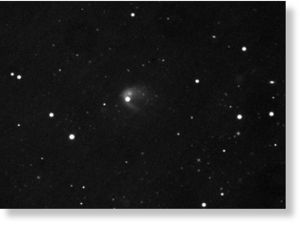
© Kevin Heider
A
picture showing the faint tail of the celestial body 596 Scheila, which
was once thought to be an asteroid. Researchers now think it may be a
dormant comet coming back to life
A
picture showing the faint tail of the celestial body 596 Scheila, which
was once thought to be an asteroid. Researchers now think it may be a
dormant comet coming back to life
A huge asteroid discovered more than 100 years ago may not be an
asteroid at all, but a dormant comet that is just now coming back to
life, according to new observations.
The object, known as 596 Scheila, is about 70 miles (113 kilometers)
wide and has a faint, wispy tail that suggests it may actually be a
comet, researchers said. If that's the case, then 596 Scheila would be
only the sixth known comet to reside in the main asteroid belt, a vast
region of space rocks that lies between the orbits of Mars and Jupiter.
The asteroid-turned-comet discovery was somewhat serendipitous. On the
night of Dec. 11, astronomer Steve Larson, a scientist with the Catalina
Sky Survey in Tucson, Ariz., was searching for potentially hazardous asteroids when he came across an object with a bright core and a faint tail.
Four images taken in a span of 30 minutes revealed the object
was moving relative to the background stars, researchers said.
"Its brightness of a total magnitude of 13.4 visual, which is about 900
times fainter than the faintest star you can see in a clear, dark sky,
led me to suspect that it was a known comet, but I checked the comet database and got nothing," Larson said in a statement.
Further investigation revealed that the object was actually 596 Scheila,
which astronomers first discovered in 1906. Scheila tumbles through
space alongside thousands of similar objects in the main asteroid belt,
but orbits slightly out of the ecliptic plane in which most planets and
asteroids travel, researchers said.
Previous studies of 596 Scheila's color have suggested that it is
composed of primitive carbonaceous material left over from the formation
of the solar system and might be an extinct or dormant comet. These
bodies have already ejected most of their volatile ices and therefore
have lost their cometary tails. Dormant comets retain some subsurface
volatiles and may start outgassing once again as they near the sun.
"Scheila, along with several other bodies in the past few years, have
created a new class of solar system objects: main-belt comets," Bill
Cooke, of NASA's Meteoroid Environment Office at Marshall Space Flight
Center, wrote in a blog post after Larson's find. "These bodies are an
anomaly and a mystery since an object this close to the sun should have
had its ices vaporized away."
After Larson reported his discovery, many other astronomers pointed
their telescopes at 596 Scheila to determine if its tail consists of ice
and gases - as would be expected for a comet - or if it is merely
dust left behind from a collision with another asteroid.
Preliminary findings of the outburst show that 596 Scheila's tail is
composed of dust, but more observations will be needed to understand
just what is happening with the object, researchers said.
Moon Hit by Meteor Caught on Tape
Tue, 11 Jan 2011 00:23 CST
eBaum's World
China lunar probe caught this impact on the moon.
Greece: Meteorite Streaks Past Moon
Tue, 11 Jan 2011 12:47 CST
Greek News
A meteor streaks by the moon in this video from a Greek News Channel on Jan 1st 2011.
US: Ball of Fire Turns Out to Be Meteor Near Oklahoma
Poteau -- Quite a stir across the state tonight, lots of folks saw a big ball of fire streaking across the sky.
The Sebastian County Sheriff's Office says it was a meteor and likely hit near Poteau Mountain, Oklahoma.
We contacted amateur astronomer Steven Meeks who writes an astronomy
blog on todaysthv.com, he says it was likely a meteor and since some
people saw it burn a bit greenish -- it probably contained copper.
He also says it was probably no bigger than a pebble. According to
affiliate KFSM, the meteor was also sighted in Greenwood, Jonesboro,
Jackson, Miss., Biloxi, Miss., and the Florida Panhandle.
Huge Fireball Spotted Over Southeast US
At roughly 8:50pm local time an apparent meteor was spotted by
observers in Acadiana including KATC's Hoyt Harris. Hoyt and Acadiana
were not alone in the observation with twitter reports (#flashoflight) from Oklahoma, Arkansas, Louisiana, Mississippi, Alabama and Florida of a bright object in the sky at the same time.
A sonic boom was heard as far north as Western North Carolina where
cloudy skies prohibited the viewing of the fireball. None of the reports
in Acadiana mentioned a sonic boom.
The possible meteor was described as a large green ball (copper composition) with a trailing orange and yellow tail.
While there were no major meteor showers in progress there could still be a random object striking the Earth's atmosphere.
Meteors as small as the size of a pea striking the Earth can put on
quite a show, but many believe that this object was a lot larger.
As of press time there was no credible indication if the meteor
reached the ground or just burned up in the Earth's atmosphere.
Apparently NASA's Jet Propulsion Laboratory Near Earth Object did
indicate a relatively "close" flyby of an asteroid this evening passing
roughly 850,000 miles (more than 3 times the distance to the moon) from
the Earth. This particular asteroid was estimated to be 25-60 feet in
diameter, but it remains unclear if the possible meteor was debris
associated with this asteroid or not.
There will likely be additional reports and more clarifying information Wednesday.
US: Mysterious Boom Rocks Region
Tue, 11 Jan 2011 11:39 CST
East County Magazine
San Diego's East County - More than 167 people have reported
feeling a possible sonic boom at 10:28 a.m., the U.S. Geological Survey
reports. The majority of reports came from San Diego and San Diego's
East County, though the incident was felt was far away as Los Angeles
County and Tijuana, Mexico.
A loud boom was followed by shaking that rattled windows for 30 seconds
or so at East County Magazine's office in La Mesa. The USGS siet lists
the mysterious noise/shaking as a possible sonic boom, but confirms that no earthquake occurred.
Did you feel it? You can report your experience to the USGS here.
Sonic booms have been felt before in San Diego, notably in 2009 and 2006. The 2006 incident was traced to naval training flights 120 miles offshore.
For some exceptional photos of planes visibly "breaking the sound barrier" and causing sonic booms, see here.
Apocalypse then: How a comet ended the Roman Empire
A
close shave with a comet nearly 1,500 years ago caused a catastrophic
change in the global climate, leading to famine, plague, the end of the
Roman Empire, the birth of the Dark Ages and even the legend of King
Arthur, a leading British scientist said at the British Association
meeting in London yesterday.
Debris from the near miss bombarded the Earth with meteors, which threw
enough dust and water vapour into the atmosphere to cut out sunlight and
cool the planet to cause crop failure across the northern hemisphere.
The cataclysmic famines weakened people's resistance to disease and led
to the great plague of the emperor Justinian. It could also be
responsible for the Arthurian stories about gods appearing in the sky
followed by a fertile kingdom becoming a wasteland.
Mike Baillie, professor of palaeoecology at Queen's University in
Belfast, said the central piece of evidence for a sudden global climate
change about AD540 comes from the study of tree rings, which highlight
the years when plant growth was poor or non-existent. "Oaks live for a
long period and in order for a lot of them to show narrow rings at the
same time it must have been a profoundly unpleasant event as far as the
tree is concerned," Professor Baillie said.
"The event of AD540 is in or at the start of the Dark Ages and
in my view probably caused the Dark Ages. It was a catastrophic
environmental downturn which shows up in trees from Siberia,
Scandinavia, northern Europe, north America and South America," he said.
"The idea is that the Earth was hit by a 'cosmic swarm', a whole stack
of cometary debris in a short period of time and that loaded the
atmosphere with dust and debris and caused some sort of environmental
downturn," Professor Baillie explained.
Tree rings round the world clearly indicate a major climate change
unprecedented in the past two millenniums. This could have cooled the
Earth by a few degrees, enough to cause crops to fail for several years
in succession.
"It only requires a few degrees cooler conditions across the year for a
few years, wiping out several consecutive harvests, and you've got a
serious problem for any agricultural society," Professor Baillie said.
"If you weaken a population through starvation and lack of
sunlight, they are going to be susceptible to disease. It's a very
unpleasant package of an environmental event, famines and plague all
happening inside less than a decade. It's nearly impossible to get
historians to take this seriously. When confronted with this event,
which is clear in the tree records, their immediate reaction is that if
something like this had happened, it would be written down. Hence they
don't go and look in any real detail to see what is there," he said.
"I am calling for a debate by scientists and historians on how to
approach the evidence for catastrophic events of this kind which were
previously not known to have taken place. Hints of it appear in
mythology, a subject normally taboo for scientists and historians."
Historians believe that King Arthur was a reference to the Irish sky
god, Cuchulain. Professor Baillie told the BA meeting: "Clearly, there
is some association between the death of Arthur, just around AD540, and a
bright Celtic sky god who is described in terms reminiscent of a
comet."
He said some authors suggested the AD540 event might be the eruption of a
supervolcano. "I don't subscribe to that. I think if there had been one
in the 6th century we'd know about it geologically," he said. "In my
view we had some sort of interaction with a comet, a cometary
bombardment, not a full-blown comet because we wouldn't be here if we'd
had that."
Professor John Lowe, a climate scientist at Royal Holloway College,
London, said: "It's entirely plausible. In the older geological records
we have evidence of such tremendous climatic variability over short
timescales and not all of it can be explained by the sort of cyclical
phenomena that we know about."
About four seconds warning: When heaven and earth collide
Sat, 08 Nov 2008 14:02 CST
Herald Scotland
Scientists
have discovered evidence of a catastrophic meteorite strike in
Scotland's distant past. Stephen Phelan visited the scene of our
armageddon to find out how likely it is to recur - and how little
warning we would have.
Long before Scotland was Scotland, when the population consisted only of
green algae and the Highlands were as dry as Death Valley, a large
natural object fell out of space and struck the Earth near where the
village of Stoer now stands, in Sutherland. This incident occurred 1.2
billion years ago, but it has only been confirmed in the last few
months. "If the same thing happened today," says planetary geologist
Scott Thackrey, "all the trees in Aberdeen would be felled. The trees in
Inverness would actually ignite. Most man-made structures would
collapse. Everything made of paper would burn. You wouldn't be safe in
Glasgow. But sitting here, we would be vapourised."
As it happens, we are sitting out a rainstorm in a rented car beside the
Stoer church graveyard. And if tombstones are monuments to life's
impermanence, then geologists serve to remind us that even the mountains
and seas are not nearly as eternal as we tell ourselves.
Like most in his profession, and possibly more so, given his
self-confessed addiction to energy drinks, Thackrey perceives time in
such a way that eons seem to whizz back and forth before his eyes. Even
as we speak, he is forming a mental picture of the impact made by the
meteorite in question. ("Meteorite" is the generic name given to any
space-rock that hits the ground at least partly intact. The same object
is referred to as a "meteoroid" before it enters Earth's atmosphere, and
a "meteor" when it appears in our sky, bursting into flames and
becoming what we also call a "shooting star".) "I can see the crater
now," says Thackrey. "Smoking, somewhere to the east of us."
Several of his colleagues see it differently. "They think the crater
would be to the west," he says. "We're all still arguing about it at
this point. But they're wrong." This argument is literally academic, not
least because the crater may never be found. After more than a billion
years, it is either buried deep beneath the Minch Basin or the Moine
Thrust, both defining features of the local topography, or it has been
eroded out of existence.
So, this particular discovery was made not in the field, but under the
microscope. The "eureka moment", according to Thackrey, came when two
collaborating teams at Aberdeen University and Oxford's Department of
Earth Sciences found "shocked minerals" inside "melt fragments" within
rock samples from Stoer. "That's when we twigged," he says. "F***ing
hell, this is impact-related. We were dancing around in the lab."
Even if a layman could get equally excited about the composition of
Scottish stones, the ones that he shows me today are far too slippy to
dance on safely. Thackrey leads the way out of the car park, along a
coastal path, and down to the sea, where the rocks are still warped from
the ground-surge that must have followed seconds after the initial
impact, when extreme heat and pressure briefly turned the land into a
rolling semi-liquid.
It has previously, and wrongly, been assumed that this misshapen corner
of the country was once part of a volcanic horizon. "Oops," says
Thackrey, having helped to prove otherwise. At 25, and still a PhD
student at Aberdeen University, he is the youngest contributor to the
research paper, published earlier this year, which effectively rewrote
geological history, although the title didn't exactly set the world on
fire: A Precambrian Proximal Ejecta Blanket From Scotland.
Even so, I wouldn't know what I was looking at or standing on -
irrefutable physical evidence of the first known meteorite strike on
what we now call British soil - unless Thackrey told me. He seems
concerned that I won't find the site sufficiently dramatic, beyond the
obvious Earthly beauty. To illustrate, he produces space probe
photographs of a "directly analogous" site on Mars, where meteorite
craters are vastly better and longer preserved.
"There is so much interest in impacts at the moment," he says. "From
exobiology the search for life, or the remains of it, on Mars and
elsewhere, to cratering as a process." His own interest is both cosmic
and domestic. Thackrey is a local boy, born in Inverness and raised in
Aberdeen. Having spent most of his recent summers in the Canadian High
Arctic, conducting research at the Haughton Crater (which NASA uses as a
base to test equipment for its ongoing Mars project), he says he is
"amazed" to be working so close to home.
He is also a recent applicant to the European Space Agency's astronaut
programme, although he has no plans to travel any further than the moon,
after hearing too much gruesome medical conjecture about the possible
skin and bone damage that might result from more prolonged journeys. In
the meantime, Thackrey has become a hot-shot within a school of
scientific thought that allows him to contemplate "the whole wonder of
massive explosions".
"What would a big impact look like?" he asks. "The only thing we can
compare it to is a nuclear detonation, but even that doesn't really come
close. I'd love to see one ..." The biggest impact of the recent past
is not, in fact, very far removed from living memory.
This year marks the centenary of the so-called Tunguska Event, when
something like an atom bomb went off deep in the Siberian forest before
atom bombs had even been invented, knocking millions of trees down for
hundreds of miles. The only humans around to witness it were a few
Russian settlers and Shanyagir tribespeople, and when scientists
belatedly reached them for comment more than 20 years later, they
testified that the sky had "split in two" and "it was as if there was a
second sun". Peasants from the isolated village of Korelina had assumed
that the world was ending, and sent a delegation to ask the nearest
archpriest how they should prepare. "As the minutes passed," wrote the
wry astronomer Kevin Zahnle, with the benefit of another few decades'
hindsight, "this theory was dropped in favour of other, less final
theories, until today one is hard-pressed to find anyone who truly
believes that the world ended on the morning of June 30, 1908."
In the conspicuous absence of a crater, however, it took the best part
of a century, and many wild guesses (some wilder than others, with
certain physicists proposing that a black hole had passed through the
Earth), before the only adequate explanation was confirmed on another
planet.
When the comet Shoemaker-Levy 9 (SL9) collided with Jupiter in 1994, it
was seen to disintegrate under "impact pressure" in mid-air, bursting
high in the atmosphere to cause shockwaves and firestorms on the ground,
without so much as touching the surface. Something similar must have
happened at Tunguska.
And according to the renowned Scottish research astronomer Bill
Napier, "the fact that this happened within the last 100 years has to be
a matter of concern". "Even a relatively small air-burst like that
could flatten London," Napier tells me. "From the city centre all the
way out past the M25. And we would expect to see a couple of hundred of
these impacts in quite a short timeframe."
Napier and his frequent collaborator Victor Clube are the leading
proponents of a theory known as "coherent catastrophism", which suggests
that the Earth is pelted at regular intervals by asteroid and comet
fragments dislodged from distant, ancient rubble fields strewn across
the known universe.
The mechanics of this are barely fathomable and currently
unquantifiable, involving galactic rotation, orbital deviation, and
fantastical outer space place-names such as The Oort Cloud, The Kuiper
Belt and The Taurid Complex. "Astronomy," admits Napier, "is too
uncertain a subject to make any definite statements." But the core of
his idea is grounded, if you like, in our geological record, and
supported with first and second-hand accounts from our ancestors.
"From peak to loftiest peak, the Earth takes fire," wrote the Roman poet Ovid in his masterwork Metamorphoses,
which was published circa 8AD but quoted much older Greek legends - in
this case the story of Phaethon, son of the Sun, who tried to ride his
father's chariot across the sky but lost control and crash-landed it.
"Walled cities melt away," continued Ovid, "whole tribes and peoples
turn to ashes gray ... The mountain masses with their forests burn."
"There is a long tradition of describing strange meteoristic events," says Napier. "The Book of Revelations
seems to borrow from Hellenic, Persian and even early Sanskrit myths
for its details of celestial conflicts which have catastrophic effects
on Earth."
This sounds like the stuff of popular fiction, and Napier has published several novels - Nemesis, The Lure, Shattered Icon - that take his research to speculative extremes. The Cosmic Serpent,
however, which he co-wrote with Clube in the early 1980s, was an
entirely non-fictional and highly influential attempt to revive the
study of meteorite impacts as a deciding factor in the past and future
existence of life on this planet.
That kind of thinking had not been taken seriously since Charles Darwin
and Charles Lyell published their respective theories of evolution and
"uniformitarianism" over 100 years earlier. At that time, the only known
impact site in the world was the famous Barrington Crater in Arizona,
which allowed Darwin, the legendary naturalist, and Lyell, the elder
geologist, to assert that such strikes were so rare as to have no real
bearing on the long, slow and steady processes of terrestrial change.
Science and technology have since advanced to prove them both wrong in
this respect, tracing craters all over, and under, the Earth's surface.
It may, indeed, have been minerals from iron-rich asteroids and ice from
vaporous comets that "seeded" this planet with the ingredients for life
in the first place. And in the late 1970s, while Napier was formulating
his own theory, an oil survey worker found a vast ring of destruction
deep beneath the Mexican village of Chicxulub - 65 million years old,
180 kilometres wide, and subsequently linked by Dr Luis Alvarez to the
extinction of the dinosaurs.
Others in the field have recently gone further, to associate possible
strikes and airbursts with the sudden death of almost all known marine
animals 200 million years earlier, and the killing off of North American
mammoths and mastodons around 11,000 BC. The original Flood myth,
disseminated through ancient literature from the Epic Of Gilgamesh to the Book Of Genesis, has been reconsidered in terms of a meteorite landing in the Indian Ocean, and the resulting tsunami.
Several potential impacts have been dated to the mid-sixth century AD,
when the Byzantine historian Procopius wrote that "a most dread portent
took place ... the sun gave forth its light without brightness".
Northern Europe appears to have suffered something like a nuclear winter
in this period, with forest fires, airborne debris and corrosive rains
leading to climate change and crop failures that may in turn have
weakened the population to their first encounter with the Black Death.
All of which seems to bear out Napier and Clube's follow-up book, The Cosmic Winter.
And if they're right about meteorites behaving like bad weather, then
we can reasonably expect another turn for the worst. "I wouldn't
necessarily be looking out for a single, one-off Hollywood spectacular,"
says Napier. "More of a widespread battering of the environment over a
sustained period."
The experts are not remotely agreed on how worried we should be.
Telescopes and satellites are now in a position to detect potential
"planet-killers" - asteroids or comets over one kilometre in diameter -
many years or even decades before they might collide with the Earth.
The problem, according to Jay Tate, director of the public information
resource Spaceguard UK, is that no measures are in place to avert them,
and smaller objects could still "whistle through" to strike us at any
time. "Do you want to know how much warning we
would have of a country or city-killing asteroid?" asks Tate. "About
four seconds. A major impact is just as likely to happen before the end
of this conversation as 10,000 years from now."
A retired British Army officer and guided-weapons specialist, Tate
became curious about government plans to defend against meteorites after
the SL9 comet bombarded Jupiter in 1994, and was furious to find that
they didn't have a single one. He and several eminent scientists formed a
task force on Near Earth Objects (NEOs), presenting parliament with a
series of recommendations for action in 2000.
"Very little has been done since," says Tate, from the
Spaceguard Centre at the former Powys Observatory in Wales. "The
official British line seems to be that we don't need to bother, because
the Americans are taking care of it. But if that's the rationale, then
what the bloody hell are we doing in Iraq?"
He goes on to explain that even the US is not particularly invested.
NASA is now spending the vast bulk of its federal budget on the
long-term goal of a manned mission to Mars, as opposed to the supposedly
simple probes and rockets, known as "gravitational tractors", which
would nudge a killer comet off-course. "NEOs represent a proven science
and a definite problem," says Tate. "Unlike the dinosaurs, we could do
something about it. I think the biggest obstruction might actually be
the human psyche, which only stretches one or two generations in each
direction. If something happened to mum or dad, or directly threatened
our kids, then it might seem real to us. Beyond that, who gives a damn?"
Standing on the northwest shore of Scotland, it does not seem likely
that the world will end in the next four seconds. But the world has
already ended here at least once, if only for the simplest, earliest
organisms who happened to be living near Stoer 1.2 billion years ago, on
the day of the impact.
"A lot of algae would have been killed, yeah," says Scott Thackrey,
pointing out traces of long-dead lifeforms preserved in the rock.
"Blasted. Obviously, they weren't made extinct, because eventually they
evolved into us. But it would have been one hell of a show."
US: Meteor Over the Southern States
Wed, 12 Jan 2011 14:55 CST
CNN
CNN takes a look at images of what could have been a meteor over the Southern states.
Sundiving Comet Storm
The sun has just experienced a storm - not of explosive flares and hot plasma, but of icy comets.
"The storm began on Dec 13th and ended on the 22nd," says Karl Battams
of the Naval Research Lab in Washington, DC. "During that time, the
Solar and Heliospheric Observatory (SOHO) detected 25 comets diving into
the sun. It was crazy!"
Sundiving comets - a.k.a. "sungrazers" - are nothing new. SOHO typically
sees one every few days, plunging inward and disintegrating as solar
heat sublimes its volatile ices. "But 25 comets in just ten days, that's unprecedented," says Battams.
"The comets were 10-meter class objects, about the size of a room or a
house," notes Matthew Knight of the Lowell Observatory in Flagstaff,
Arizona. "As comets go, these are considered small."
SOHO excels at this kind of work. The spacecraft's coronagraph
uses an opaque disk to block the glare of the sun like an artificial
eclipse, revealing faint objects that no Earth-bound telescope could
possibly see. Every day, amateur astronomers from around the world
scrutinize the images in search of new comets. Since SOHO was launched
in 1996, more than 2000 comets have been found in this way, an all-time
record for any astronomer or space mission.
Battams and Knight think the comet-storm of Dec. 2010 might herald a
much bigger sungrazer to come, something people could see with the naked
eye, perhaps even during the day.
"It's just a matter of time," says Battams. "We know there are some big ones out there."

© NASA
Comet Ikeya-Seki, photographed by Roger Lynds at Kitt Peak, Arizona, on the morning of 1965 October 29.
Comet Ikeya-Seki, photographed by Roger Lynds at Kitt Peak, Arizona, on the morning of 1965 October 29.
Comet
Ikeya-Seki is a good example. In 1965 it appeared out of nowhere, dove
toward the sun and swooped over the stellar surface only 450,000 km
away. Because Ikeya-Seki's nucleus was large, about 5 km wide, it
survived the encounter and emerged as one of the brightest comets of the
past thousand years. Japanese observers saw it in broad daylight right
beside the morning sun. People watched in amazement as Ikeya-Seki fell
into at least three pieces before receding back into the solar system.
Similar but lesser sungrazing comets were observed in 1843, 1882, 1963
and 1970.
These sungrazers are all related to one another. Astronomers call them
the "Kreutz family" after the 19th century astronomer Heinrich Kreutz
who first studied them as a group. Modern thinking about the family is
attributed to Brian Marsden (1937-2010) of the Harvard Minor Planet
Center. He analyzed the orbits of Kreutz comets and saw that they
probably came from the breakup of a single giant comet in the 12th
century, probably the Great Comet of 1106. According to Marsden's work,
Ikeya-Seki-class comets and the smaller SOHO sungrazers are just
different-sized fragments of that one progenitor.
Researchers Zdenek Sekanina and Paul Chodas of JPL modeled the
fragmentation of the Kreutz progenitor, and in a 2007 issue of the
Astrophysical Journal suggested that more big chunks were on the way.
Knight's own counting of SOHO sungrazers supports their idea.
"Since SOHO was launched there has been a trend of increasing numbers of Kreutz sungrazers," he points out. A table in Knight's 2008 PhD thesis shows SOHO detecting 69 sungrazers in 1997 compared to 200 sungrazers in 2010. "The increase is significant and cannot be accounted for by improvements in SOHO or the increasing skill of comet hunters."
Was Comet Ikeya-Seki preceded by a storm like that of Dec. 2010?
No one knows.
"We have not seen a really big Kreutz comet in the era of space-based
coronagraphs," notes Knight. "SOHO wasn't around in 1965 to record how
many little comets dove into the sun before Ikeya-Seki. It might be 200
comets per year--or it could be 1000. Without more information, we can't
know for sure how soon we might be privileged to see one of the real
monsters."
Battams offers this advice: "Stay tuned to SOHO."
US: Big Boom Remains a Mystery
Galveston - Some island residents, firefighters, police and city
hall officials heard a loud boom Wednesday, but the source of the noise
remains a mystery.
Galveston Fire Chief Jeff Smith heard the explosion shortly before noon as he traveled on 12th Street.
City spokeswoman Alicia Cahill was at city hall, and police spokesman
Lt. Jeff Heyse was at the police station when they heard the noise.
"We had several calls come into dispatch, and we sent an engine company out to investigate," Smith said.
One person called from 42nd Street, and the noise was heard as far west as 61st Street, Smith said.
"I was actually coming up on 12th street, and it was clearly a very loud noise," Smith said.
Firefighters found no fire and documented no sign of an explosion.
"At this point, it's possibly going to be an aviation aircraft or possibly a large transformer bank," Smith said.
The noise wasn't related to any transformer failure, and CenterPoint
Energy had no reports of electrical problems, Keith Gray, a spokesman
for CenterPoint Energy, said.
No one reported hearing the noise in Texas City, just north across the
bay from Galveston. The noise wasn't related to any of the Texas City
plants or refineries, Bruce Clawson, the city's Homeland Security
director, said.
The noise could have come from an aircraft breaking the sound barrier.
The tower at Scholes International Airport in Galveston, however, had no
jets in the area at the time of the boom, airport Director Hud Hopkins
said.
F-16 pilots that fly from Ellington would normally make contact with
flight controllers at the tower if they were in the area, Hopkins said.
There were no reports of aircraft leaving Ellington Field or William P.
Hobby Airport in Houston that would have created a sonic boom, Marlene
McClinton, a spokeswoman with the Houston Airport System, said.
The Federal Aviation Administration also took no reports of a sonic
boom, Lynn Lunsford, a spokesman for the administration, said.
Attempts to reach a NASA spokeswoman for comment were unsuccessful.
US: Possible Meteor Sighting in Arkansas
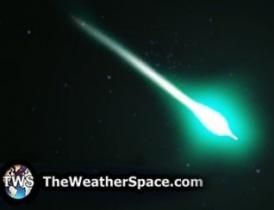
© theweatherspace.com
Licensed to TheWeatherSpace.com, image of 1-11-11 Meteor from viewer in Little Rock, AR looking Southwest
Licensed to TheWeatherSpace.com, image of 1-11-11 Meteor from viewer in Little Rock, AR looking Southwest
There
have been several reports, from Florida to Oklahoma, of people seeing a
meteor streaking across the southern sky Tuesday night.
The sighting took place around 9 p.m. It is being described as a
fireball that resulted in a bright flash. In pictures it looks like a
greenish-blue streak, almost like lighting. It only lasted a second.
However, many pictures have also been identified as fakes so no one is 100 percent sure what the occurrence is.
According to astronomers, if it was a meteor it most likely contained
copper which is why it gave off a greenish glow. It was also reported
traveling southeast to northwest.
"Based on everyone's description instead of coming down it sounds like
it came more across which gives it more time to burn up so more than
likely it burned up in the atmosphere," said Stephen Meeks, amateur
astronomer.
If it was a meteor it was a pretty rare sight, those types of meteors
only occur five or six times a year in the United States, according to
meteor expert Steve Arnold.
Source: KSFM-TV
Abnormal Sunbound comets may mean larger one to come
Thu, 13 Jan 2011 20:30 CST
TheWeatherSpace.com
In the last 10 days astronomers have counted at least 25 comets on
the NASA SOHO Spacecraft, plunging into the Sun. It could mean a larger
one ahead.
These comets could be part of a larger comet, according to astronomers.
The comet may come without notice, much like the cosmic visitor named
Comet Ikeya-Seki in 1965, which was seen in broad daylight and came
without warning.
One candidate would be the newly discovered Comet 2010 X1 Elenin, which
comes very close to our planet in the Fall of 2011. The comet will be so
bright you can see it with the unaided eye even in a small city.
Some Comets Like it Hot - Comet Ikeya-Seki October 29, 1965

© Roger Lynds
This
4-minute exposure of comet Ikeya-Seki was captured by Roger Lynds at
Kitt Peak, Arizona, on the morning of 1965 October 29.
This
4-minute exposure of comet Ikeya-Seki was captured by Roger Lynds at
Kitt Peak, Arizona, on the morning of 1965 October 29.
July
7, 2000 -- In October 1965 comet Ikeya-Seki swooped past the Sun barely
450 thousand kilometers above our star's bubbling, fiery surface. Gas
and dust exploded away from the comet's core as fierce solar radiation
vaporized the icy nucleus. Most comets wouldn't survive passing as close
to the Sun as the Moon is to the Earth, but Ikeya-Seki literally came
through with flying colors. When the comet emerged from perihelion
(closest approach to the Sun) it was so bright that observers on the
street with very clear skies could see it during broad daylight if the
Sun was hidden behind a house or even an outstretched hand.
"In Japan (where observers spied the comet 1/2 degree from the Sun) it was described as 10 times brighter than the Full Moon," recounted Brian Marsden of the Harvard Center for Astrophysics in the December 1965 issue of Sky & Telescope.
"At Kitt Peak National Observatory in Arizona, Stephen Maran observed
the comet with binoculars from within the shadow of a black disk erected
to hide the Sun. '[It was] the most splendid thing I have ever seen,'
he noted."
Ikeya-Seki, a.k.a. "The Great Comet of 1965", is a member of the family
of comets called Kreutz sungrazers (after the nineteenth-century German
astronomer who studied them in some detail). These ill-fated visitors to
the inner solar system have been seen to pass less than 50,000 km above
the Sun's photosphere. Most never make it past perihelion -- they are
completely obliterated. But the few that do, like Ikeya-Seki, can be
very bright.
"There are 2 or 3 really bright ones like Ikeya-Seki every
century," says Brian Marsden. "Most of these sungrazers are fragments
from the breakup of a giant comet at least 2000 years ago, perhaps the
one that the Greek astronomer Ephorus saw in 372 BC. Ephorus reported
that the comet split in two. This can be made to fit with my calculation
that Ikeya-Seki and an even better Kreutz sungrazer observed in 1882
split off from each other when their parent revisited the Sun around AD
1100. Splits have occurred again and again, producing the sungrazer
family, all still coming from the same direction."
The nucleus of Ikeya-Seki was probably some kilometers across. Tinier
pieces of Ephorus's comet streak past the Sun every day. Measuring
perhaps only ten meters in diameter, they brighten briefly as they
approach the Sun and disappear forever when they vaporize above the
photosphere. Most of the faint fragments must have escaped detection
entirely..
Now, thanks to coronagraphs on board the orbiting ESA/NASA Solar and
Heliospheric Observatory (SOHO), amateur and professional astronomers
can easily monitor the sky around the Sun for the telltale streaks of
faint sungrazers. All that's needed is a computer and a connection to
the internet.
"In late1998 we put SOHO's realtime coronagraph movies online
so that anyone with an internet connection could access the data" says
Doug Biesecker, a solar physicist at the Goddard Space Flight Center and
SOHO's champion comet hunter with 47 finds. "Over a three year period
before that time we had found 58 comets near the Sun in SOHO images. Now
the total is up to nearly 170. Amateur astronomers watching coronagraph
movies on the web are responsible for nearly all of the new finds this
year. They're keeping me very busy!"
Editor's note: The pace of SOHO comet
discoveries has accelerated to such an extent that during the author's
45 minute interview with Biesecker, two new comets were found!
A coronagraph is a device that blocks the glare of the Sun so that the
faint corona, as well as surrounding stars and planets, are visible.
It's a sophisticated version of the black disk Stephen Maran used to see
Ikeya-Seki in 1965. The SOHO spacecraft carries two coronagraphs, one
with a 3-degree field of view (the "C2" coronagraph) and another with a
16-degree field of view (the "C3" coronagraph). SOHO is located at the
L1 point 1.5 million kilometers from the Earth in the direction of the
Sun. It enjoys an uninterrupted view of our star.
The
SOHO C2 coronagraph captured this image of a sungrazing comet 0.75
degrees from the Sun on April 29, 2000. The solid brick-colored disk in
the middle is the coronagraph's occulting disk; the white circle shows
the true size of the Sun. The comet was noticed by four different
amateur astronomers who were monitoring images from SOHO's realtime data
page. All four (M. Boschat, T. Lovejoy, M. Oates, R. Gorelli) are
credited with the discovery. The same comet was visible a day earlier in
wider-angle C3 images, but it was much fainter. This 4-frame animation
of the comet illustrates why it is easier to find sungrazers when they
are very close to the Sun.
One of the most successful amateur comet hunters is Michael Boschat.
He's credited (or shares credit) with a dozen discoveries since March
2000.
"I use the C3 512 x 512 pixel images," explains Boschat. "They appear on
the SOHO site every 30 minutes and I download them as soon as they do.
After I have four images I begin to loop them using GIF animation
software that can be found on the Internet. I usually loop them at four
frames per second looking for an object that is moving towards the Sun
in a steady manner. I also use a magnifying glass to watch the possible
comet move. After I feel it is a comet I put my mouse arrow as near as
possible to the object to get the X and Y coordinates then send all that
information off via email to Douglas Biesecker at Goddard."
View a sample 4-frame animation featuring a faint sungrazing comet.
All of the comets identified in images from SOHO are called "comet SOHO"
followed by a number denoting the order of discovery. This differs from
the traditional convention of naming a comet after the person who finds
it. The most recent confirmed sungrazer, as of July 4, 2000, was comet
SOHO-143. The International Astronomical Union's official designation
for SOHO-143 is C/1998 K15, because the actual images were obtained in
1998, with the K15 indicating that this was the fifteenth comet (of any
description) found during the second half of May.
"It started in the early 1980s with the SOLWIND mission, which also
carried a coronagraph," explains Biesecker. "SOLWIND detected 6
sungrazers and they were all named after the satellite. The tradition
continued for the Solar Maximum Mission (10 comets) and now for SOHO
(143 confirmed comets and counting). It's reasonable because all of the
comet finds have to be confirmed by mission scientists who are familiar
with the hardware. Cosmic rays, noise in the detectors and other factors
can mimic comets and we have to carefully examine each one. It's really
a team effort."
"In the early 1980s there were also the 'IRAS' comets, found by the
Infrared Astronomical Satellite," added Marsden. "Most of the comets
found nowadays from the ground--and far from the sun--are named
'LINEAR', acronym for the Lincoln Near Earth Asteroid Research team,
which scans the sky intensely with a U.S. Air Force telescope." (One of these is about to become a naked eye object in late July, 2000.)
Comet Shoemaker-Levy 9 was broken into many pieces during a close
encounter with the planet Jupiter in 1992. Two years later it came so
close to the planet that the fragments actually plunged into Jupiter's
atmosphere. Like the pieces of SL-9, most sungrazing comets are debris
from a single comet that broke apart when it passed by the Sun perhaps
2000 years ago. [more information]

© NASA
Comet Shoemaker-Levy 9 was broken into many pieces during a close encounter with the planet Jupiter in 1992
Comet Shoemaker-Levy 9 was broken into many pieces during a close encounter with the planet Jupiter in 1992
Biesecker says he hopes the recent spate of amateur discoveries will continue unabated.
"The amateur discoveries are important because they can help us
understand the fragmentation history of Kreutz sungrazers by monitoring
the numbers and brightness of the smallest ones that we can see with the
SOHO coronagraphs. The amateurs are also finding a few unrelated
'near-Sun' comets [this is not an official name] that pass within 10 to
20 solar radii of the Sun. This is an under-sampled population of
comets."
SOHO (the Solar and Heliospheric Observatory) is a mission of
international cooperation between NASA and the European Space Agency. It
is managed by the Goddard Space Flight Center for the NASA HQ office of
Space Science.
25 Sun-Diving Comets in 10 days?
The sun has just experienced a storm - not of explosive flares and hot plasma, but of icy comets.
"The storm began on Dec 13th and ended on the 22nd," says Karl Battams
of the Naval Research Lab in Washington, DC. "During that time, the
Solar and Heliospheric Observatory (SOHO) detected 25 comets diving into
the sun. It was crazy!"
Sundiving comets - a.k.a. "sungrazers" - are nothing new. SOHO typically
sees one every few days, plunging inward and disintegrating as solar
heat sublimes its volatile ices. "But 25 comets in just ten days, that's unprecedented," says Battams.
"The comets were 10-meter class objects, about the size of a room or a
house," notes Matthew Knight of the Lowell Observatory in Flagstaff,
Arizona. "As comets go, these are considered small."
SOHO excels at this kind of work. The spacecraft's coronagraph uses an
opaque disk to block the glare of the sun like an artificial eclipse,
revealing faint objects that no Earth-bound telescope could possibly
see. Every day, amateur astronomers from around the world scrutinize the
images in search of new comets. Since SOHO was launched in 1996, more
than 2000 comets have been found in this way, an all-time record for any
astronomer or space mission.
Battams and Knight think the comet-storm of Dec. 2010 might herald a
much bigger sungrazer to come, something people could see with the naked
eye, perhaps even during the day.
"It's just a matter of time," says Battams. "We know there are some big ones out there."

© Roger Lynds
This
4-minute exposure of comet Ikeya-Seki was captured by Roger Lynds at
Kitt Peak, Arizona, on the morning of 1965 October 29.
This
4-minute exposure of comet Ikeya-Seki was captured by Roger Lynds at
Kitt Peak, Arizona, on the morning of 1965 October 29.
Comet
Ikeya-Seki is a good example. In 1965 it appeared out of nowhere, dove
toward the sun and swooped over the stellar surface only 450,000 km
away. Because Ikeya-Seki's nucleus was large, about 5 km wide, it
survived the encounter and emerged as one of the brightest comets of the
past thousand years. Japanese observers saw it in broad daylight right
beside the morning sun. People watched in amazement as Ikeya-Seki fell
into at least three pieces before receding back into the solar system.
Similar but lesser sungrazing comets were observed in 1843, 1882, 1963
and 1970.
These sungrazers are all related to one another. Astronomers call them
the "Kreutz family" after the 19th century astronomer Heinrich Kreutz
who first studied them as a group. Modern thinking about the family is
attributed to Brian Marsden (1937-2010) of the Harvard Minor Planet
Center. He analyzed the orbits of Kreutz comets and saw that they
probably came from the breakup of a single giant comet in the 12th
century, probably the Great Comet of 1106. According to Marsden's work,
Ikeya-Seki-class comets and the smaller SOHO sungrazers are just
different-sized fragments of that one progenitor.
Researchers Zdenek Sekanina and Paul Chodas of JPL modeled the
fragmentation of the Kreutz progenitor, and in a 2007 issue of the Astrophysical Journal suggested that more big chunks were on the way. Knight's own counting of SOHO sungrazers supports their idea.
"Since SOHO was launched there has been a trend of increasing numbers of
Kreutz sungrazers," he points out. A table in Knight's 2008 PhD thesis
shows SOHO detecting 69 sungrazers in 1997 compared to 200 sungrazers in
2010. "The increase is significant and cannot be accounted for by
improvements in SOHO or the increasing skill of comet hunters."
Was Comet Ikeya-Seki preceded by a storm like that of Dec. 2010?
No one knows.
"We have not seen a really big Kreutz comet in the era of space-based
coronagraphs," notes Knight. "SOHO wasn't around in 1965 to record how
many little comets dove into the sun before Ikeya-Seki. It might be 200
comets per year--or it could be 1000. Without more information, we can't
know for sure how soon we might be privileged to see one of the real
monsters."
Battams offers this advice: "Stay tuned to SOHO."
Move Over Global Warming, Let's Talk About Global Catastrophes
The Global Catastrophic Risks
conference started yesterday morning and death by asteroids, comets and
gamma ray bursts was on the agenda as experts discussed the statistical
likelihood of these types of global catastrophes.
First up at the conference on Global Catastrophic Risks
was the topic of asteroids, with David Morrison who is a NASA senior
scientist. He spoke about the threat of a catastrophic asteroid strike
and the Spaceguard Survey.
It is NASA's responsibility since 1998, to monitor the skies and detect
near Earth asteroids that are larger than 1 kilometer in size, which is
the size that, if it hit Earth, could end civilization.
Morrison stated that 80 percent of the near Earth asteroids that are 1
kilometer or larger have been identified and that he could assure those
gathered at the conference that "We are not going the way of the
dinosaurs." He also says the Spaceguard Survey has not turned up any
near Earth asteroids as large as the one that is believed to have wiped
out the dinosaurs.
Morrison pointed out that asteroid strikes are the only natural hazard
that in principle can be completely eliminated. Thanks to the Spaceguard
Survey, humanity will likely have decades of warning before an impending collision. Once alerted, missiles could be used to nudge a threatening asteroid so that it misses the earth.
Comment: Hmm...interesting to notice NASA senior
scientist's (clearly unwarranted) optimism, when director of the public
information resource Spaceguard UK says the following:
The experts are not remotely agreed on how worried we should be.
Telescopes and satellites are now in a position to detect potential
"planet-killers" - asteroids or comets over one kilometre in diameter -
many years or even decades before they might collide with the Earth.
The problem, according to Jay Tate, director of the public information resource Spaceguard UK, is that no
measures are in place to avert them, and smaller objects could still
"whistle through" to strike us at any time. "Do you want to know how
much warning we would have of a country or city-killing asteroid?" asks
Tate. "About four seconds. A major impact is just as likely to happen
before the end of this conversation as 10,000 years from now."
Then again, they are keeping their eye on the 210-330 meter asteroid Apophis,
to which they say there is a 1 in 45,000 chance that it could hit the
earth on April 13, 2036 and the next three or four years will allow them
to specify the likelihood a little better.
Next up was Arnon Dar who is a Technion physicist, discussing Gamma Ray Bursts (GRBs).
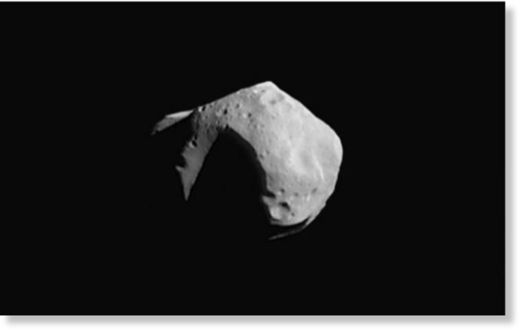
© Wikimedia Commons
Asteroid (253) Mathilde taken up by the space probe NEAR on 27 June 1997 from a distance of 2400 km.
Asteroid (253) Mathilde taken up by the space probe NEAR on 27 June 1997 from a distance of 2400 km.
Gamma-ray bursts (GRB) are sudden, intense
flashes of gamma-rays which, for a few blinding seconds, light up in an
otherwise fairly dark gamma-ray sky. They are detected at the rate of
about once a day, and while they are on, they outshine every other
gamma-ray source in the sky, including the sun. GRBs are produced when a
gigantic star goes supernova.
Dar highlights the Eta Carinae,
which is 7,500 light years away and points out that it has been
unstable, it is 100 times more massive than the sun and 5 million times
brighter and then he gives the good news that it's axis is pointed away
from the earth.
Lest everyone let their concern dwindle though, Anders Sandberg from the
Future of Humanity Institute, states that "some astronomers are worried
that we may be looking down the barrel of gamma ray gun when the WR 104 binary located 8,000 light years away goes supernova."
Next on the agenda for the conference was the topic of comets.
William Napier from the Center for Astrobiology at Cardiff University in
Wales spoke on the topic of comets and he states that long-period
comets, which are
those coming from the Oort cloud and the Kuiper belt have very
different properties and behave differently, and are thought to
"constitute around 1 percent of the risk of catastrophic collision."
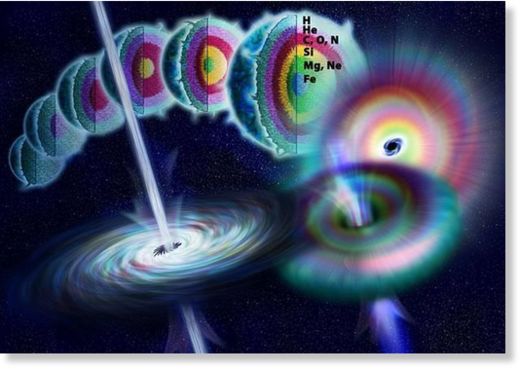
© Wikimedia Commons
Drawing of a massive star collapsing to form a black hole. Energy
released as jets along the axis of rotation forms a gamma ray burst that
lasts from a few milliseconds to minutes. Such an event within several
thousand light years of Earth could disrupt the biosphere by wiping out
half of the ozone layer, creating nitrogen dioxide and potentially cause
a mass extinction.
Drawing of a massive star collapsing to form a black hole. Energy
released as jets along the axis of rotation forms a gamma ray burst that
lasts from a few milliseconds to minutes. Such an event within several
thousand light years of Earth could disrupt the biosphere by wiping out
half of the ozone layer, creating nitrogen dioxide and potentially cause
a mass extinction.
Napier believes that is
underestimating the threat because of Dark Comets, which are comets that
do not have bright tails and therefore are harder to detect and he uses
the IRAS-Araki-Alcock comet as an example, stating that it was detected
"only two weeks before it came within 0.03 astronomical units of the
earth (about 230 earth diameters) back in 1983-the closest of any known
comet since 1770."
Napier argues that the record of large impact craters suggests that the earth experiences periods of cometary bombardment
every 36 million years or so. He attributes the episodes to the sun's
periodic passage through galactic plane where contact with molecular
clouds dislodges comets from the Oort cloud surrounding the solar
system. He believes that the earth is currently in a bombardment
episode. "We have comet problem because they are hard to detect
which means that we would have months or weeks of warning at most," said
Napier.
The topics to be discussed next at the Global Catastrophic Risks conference in Oxford will be pandemics and nuclear war.
From all accounts it seems that for now, human beings are not in imminent danger from outer space.
Then again, outer space is not the only thing these scientists and experts are looking into.
On the last day of the conference, they are expected
to discuss the unintended consequences of new technology, with one
example being superintelligent machines that, if handled wrong, might
cause the demise of Homo sapiens.
According the director of Oxford's Future of Humanity Institute, which is hosting
the conference, Dr. Nick Bostrom, "Any entity which is radically
smarter than human beings would also be very powerful. If we get
something wrong, you could imagine the consequences would involve the
extinction of the human species."
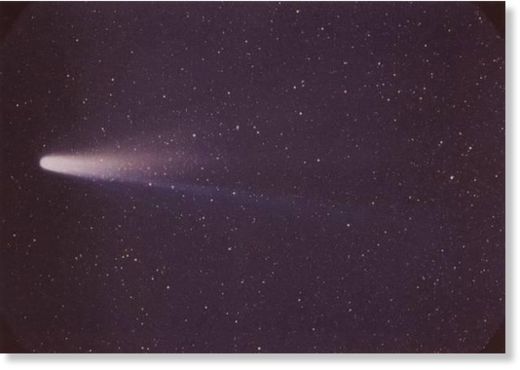
© NASA
Comet P/Halley as taken March 8, 1986 by W. Liller, Easter Island,
part of the International Halley Watch (IHW) Large Scale Phenomena
Network.
Comet P/Halley as taken March 8, 1986 by W. Liller, Easter Island,
part of the International Halley Watch (IHW) Large Scale Phenomena
Network.
Another topic being discussed by the CNN
article linked above is how some experts believe that in as little as
two decades "humans will become more non-biological than biological,
capable of uploading our minds onto the Internet, living in various
virtual worlds and even avoiding aging and evading death," according to
Dr. Ray Kurzweil, who is an inventor and futurist who calculates
technology trends using what he calls the law of accelerating returns, a
mathematical concept that measures the exponential growth of
technological evolution.
Sound like a science fiction movie?
In the 1980s, Kurzweil predicted that a tiny handheld device would be
invented early in the 21st century, allowing blind people to read
documents from anywhere at anytime; this year, such a device was
publicly unveiled. He also anticipated the explosive growth of the
Internet in the 1990s.
Other experts agree that humans will merge with machines before the end of this century, according to the CNN article.
Comment: No need to wait till the end of this
century, as "one of man's important mistakes, one which must be
remembered, is his illusion in regard to his I. Man such as we know him,
the 'man-machine,' the man who cannot 'do,' and with whom and through
whom everything 'happens,' cannot have a permanent and single I. His I
changes as quickly as his thoughts, feelings and moods, and he makes a
profound mistake in considering himself always one and the same person;
in reality he is always a different person, not the one he was a moment
ago. " ~ G I Gurdjieff
There is danger in the sky: Sodom and Gomorrah 'destroyed by a comet', say astronomers
Sodom
and Gomorrah may have been destroyed by debris from a comet, startling
new archaeological and astronomical research suggests. Another
bombardment from space may have brought on the Dark Ages.
The research, to be presented to a conference at Cambridge University
this summer, provides dramatic evidence for an extraterrestrial cause
for the wholesale collapse of several civilisations around 2200BC.
The conference, on natural catastrophes during Bronze Age civilisations,
will bring together astronomers, archaeologists, geologists and other
scientists to try to find an explanation for the near-simultaneous fall
of the Old Kingdom of ancient Egypt, the Sumerian civilisation in
Mesopotamia and the Harrapin Civilisation of the Indus Valley. In all,
some 40 cities are thought to have disappeared, in a series of
catastrophes.
Astronomers calculate that the Earth is bombarded by a particular dense
storm of meteorites over a couple of centuries every 2,500 years - the
last two blitzes would have occurred around 2200-2000BC and 400-600AD.
French archaeologist Marie-Agnes Courty will provide powerful
corroborative evidence: samples dating from 2200BC from three Middle
Eastern regions all containing a calcite material found only in
meteorites.
Tradition ascribed the destruction of the Cities of the Plain to the
same period. Genesis describes how "the Lord rained upon Sodom and upon
Gomorrah brimstone and fire from the Lord out of Heaven" - a fair
description of a meteorite storm.
Dr Benny Peiser, of Liverpool's John Moores University who is organising
the conference, says the destruction is clear from the archaeological
record and that cometary debris could explain it. Previous explanations,
like earthquake or volcanic eruption, could not account for destruction
over such a vast area, covering most of the then known world.
While sceptical about Biblical chronologies he thinks the story could be
a description of the impact of the debris, "a record of a real natural
event that ended up as a Biblical tradition".
Dr Victor Clube, senior research fellow in astrophysics at Oxford, says
the Biblical account accords well with similar events in Babylonian
records. He has calculated that the Earth would have passed through a
particularly dense cloud of debris - the Taurid meteorite stream,
thought to have resulted from the break-up of a comet 40,000 years ago -
between 2200 and 2000BC.
This happened again between 400 and 600AD and may have led to the fall
of Rome and the Dark Ages, when contemporaries report "fires of
righteous vengeance" falling from the sky.
The Taurid Stream is not due to return until the end of the next
millennium but Dr Clube says that similar bombardments from other
debris could occur in the meantime. "There is danger in the sky," he
warns, "and people would be right to be afraid."
Catastrophist Theories of Life Gaining Ground: It Came From Outer Space
They're called catastrophists, a group of British scientists who
question many of the aspects of Darwinian evolution and argue that life
on Earth and the geology of the planet have been constantly reshaped by
asteroid strikes and other external shocks.
The latest sally from the catastrophist camp comes from the astronomer
and mathematician Chandra Wickramasinghe, who told a scientific congress
in California in July that he had found microbes in air samples scooped
up by a balloon flying 25 miles (about 40 kilometers) above the Earth's
surface.
Mr. Wickramasinghe, director of the department of Astrobiology at
Cardiff University in Wales, said it was the first positive
identification of extraterrestrial microbial life outside the
atmosphere. The fact that a major British university has set up a
department dedicated to a theory still regarded with much skepticism and
hostility in the academic community is one indication of how accepted
catastrophist ideas have become in British science.
There is no school of catastrophists as such in Britain. They
are a loosely linked community of scientists drawn together by the
gravitational pull of common interests, and who occasionally work
together on joint projects or books. "There is no sense in which we come
together to push a common view," said Mark Bailey, an astronomer who is
director of the Observatory at Armagh in Northern Ireland, now a center
for catastrophist thinking. "We are really individuals," he continued,
"although most of us have worked together in different combinations, so
in that sense we get on well with one another."
Catastrophism has never had much of a following in the United States,
partly because of the debate between creationists and evolutionists, and
partly because of the cultish influence of Immanuel Velikovsky, a
pseudo-scientist who believed ancient myths could be explained by a near
collision between Venus and Earth.
Comment: Interesting how in many cases in our
society, person who cultivates deep and original (interdisciplinary)
thinking in others is immediately labeled as having cultist influence
with all the implied, negative and distorted, connotations. Read The Science Cartel vs. Immanuel Velikovsky to learn more about the man who became the target of nearly universal abuse and derision.
Because of the impact of the Velikovsky affair in America, "it is
very hard for practicing scientists there to embrace the concept that
catastrophism is really an ongoing process," Mr. Bailey said. On the
other hand, the Society for Interdisciplinary Studies in Britain, which
Mr. Bailey described as "a broad church," includes some Velikovskians.
Mr. Wickramasinghe and his mentor, the astronomer Fred Hoyle, have long
argued that diseases like influenza that strike suddenly and
simultaneously at many places around the Earth arrive here from space.
They say that bombardment by external viruses or bacteria is a more
logical explanation of life on Earth than the Darwinian view that
micro-organisms evolved into higher life forms by constant replication
and evolution.
While the Venus theory has been dismissed, two other British
astronomers, Victor Clube and Bill Napier, developed the theory that the
Earth is orbiting in the tail of a giant destroyed comet, and is under
constant bombardment by bits of cometary debris, ranging from dust to
sizable rocks. Occasionally, they say, it is hit by a particularly large
chunk of rock, like the asteroid that fell in Siberia in 1908, or
possibly a huge body that resulted in the extinction of the dinosaurs.
A leading astronomer of the last century, Ernst Opik of Estonia, who was
the first scientist to compute the collision probabilities of comets
and asteroids against planets, worked at Armagh from the 1940s to the
1980s. His grandson, Lembit Opik, a member of Parliament, successfully
helped lead the scientific campaign that led the British government to
set up the official Task Force on Potentially Hazardous Near Earth
Objects.
Another leading catastrophist is Mike Baillie, an expert in early
climate change, at Queen's University in Belfast. Mr. Baillie starts
from scientific grounds, such as the measurement of tree rings and the
examination of ice core samples, and then delves into mythology to find
out if legends can throw light on the extraordinary, perhaps
catastrophic climatic events revealed by the records. In a book, Exodus to Arthur,
Mr. Baillie asks whether the simultaneous emergence of legends about
dragons in China and angels in Western mythology were common reactions
to the appearance of a comet.
Mr. Baillie points out that contemporary accounts at the time of the
Black Death, which killed one third of Europe's population in the 14th
century, mentioned droughts, floods, masses of dead fish, earthquakes,
sheets of fire, stinking smoke, huge hailstones and blasts of hot wind -
all possible descriptions, he said, of a close encounter with an
asteroid or comet.
One record spoke of a large bright star over Paris, and another said
that the sky looked yellow and the air red because of burning vapors.
Tree ring studies reveal evidence of massive climate disturbance at the
same time, Mr. Baillie added.
Catastrophism began receiving a fairer hearing in the 1980s after Walter and Luis Alvarez published an article in Science proposing that the extinction of the dinosaurs had been caused by the impact of an asteroid about six miles in diameter.
This was later linked to the crater, about 110 miles in diameter,
identified in 1990 at Chicxulub in the Yucatan Peninsula of Mexico.
About 130 such craters have now been identified on Earth. In 1994,
scientists watched at least 21 large fragments from the Shoemaker-Levy 9
comet plunge into the surface of Jupiter, throwing up fireballs as big
as the Earth. That, and a mass of research culled from space
observation, lends some credence to the catastrophist view that a future
disastrous impact on Earth is not a question of if, but when.
Cometary Impact on Neptune: Herschel Data Point to Collision About Two Centuries Ago
Wed, 21 Jul 2010 00:00 CDT
ScienceDaily
A
comet may have hit the planet Neptune about two centuries ago. This is
indicated by the distribution of carbon monoxide in the atmosphere of
the gas giant that researchers -- among them scientists from the French
obser-vatory LESIA in Paris, from the Max Planck Institute for Solar
System Re-search (MPS) in Katlenburg-Lindau (Germany) and from the Max
Planck Insti-tute for Extraterrestrial Physics in Garching (Germany) --
have now studied. The scientists analyzed data taken by the research
satellite Herschel, that has been orbiting the Sun in a distance of
approximately 1.5 million kilometers since May 2009. The research is
published in Astronomy & Astrophysics (July 16, 2010).
When the comet Shoemaker-Levy 9 hit Jupiter sixteen years ago,
scientists all over the world were prepared: instruments on board the
space probes Voyager 2, Galileo and Ulysses documented every detail of
this rare incident. Today, this data helps scientists detect cometary
impacts that happened many, many years ago. The "dusty snowballs" leave
traces in the atmosphere of the gas giants: water, carbon dioxide,
carbon monoxide, hydrocyanic acid, and carbon sulfide. These molecules
can be detected in the radiation the planet radiates into space.
In February 2010 scientists from Max Planck Institute for Solar System
Research discovered strong evidence for a cometary impact on Saturn
about 230 years ago (see Astronomy and Astrophysics, Volume
510, February 2010). Now new measurements performed by the instrument
PACS (Photodetector Array Camera and Spectrometer) on board the Herschel
space observatory indicate that Neptune experienced a similar event.
For the first time, PACS allows researchers to analyze the long-wave
infrared radiation of Neptune.
The atmosphere of the outer-most planet of our solar system
mainly consists of hydrogen and helium with traces of water, carbon
dioxide and carbon monoxide. Now, the scientists detected an unusual
distribution of carbon monoxide: In the upper layer of the atmosphere,
the so-called stratosphere, they found a higher concentration than in
the layer beneath, the troposphere. "The higher concentration of carbon
monoxide in the stratosphere can only be explained by an external
origin," says MPS-scientist Paul Hartogh, principle investigator of the
Herschel science program "Water and related chemistry in the solar
system." "Normally, the concentrations of carbon monoxide in troposphere
and stratosphere should be the same or decrease with increasing
height," he adds.
The only explanation for these results is a cometary impact. Such a
collision forces the comet to fall apart while the carbon monoxide
trapped in the comet's ice is released and over the years distributed
throughout the stratosphere. "From the distribution of carbon monoxide
we can therefore derive the approximate time, when the impact took
place," explains Thibault Cavalié from MPS. The earlier assumption that a
comet hit Neptune two hundred years ago could thus be confirmed. A
different theory according to which a constant flux of tiny dust
particles from space introduces carbon monoxide into Neptune's
atmosphere, however, does not agree with the measurements.
In Neptune's stratosphere the scientists also found a higher
concentration of methane than expected. On Neptune, methane plays the
same role as water vapor on Earth: the temperature of the so-called
tropopause -- a barrier of colder air separating troposphere and
stratosphere -- determines how much water vapor can rise into the
stratosphere. If this barrier is a little bit warmer, more gas can pass
through. But while on Earth the temperature of the tropopause never
falls beneath minus 80 degrees Celsius, on Neptune the tropopause's mean
temperature is minus 219 degrees.
Therefore, a gap in the barrier of the tropopause seems to be
responsible for the elevated concentration of methane on Neptune. With
minus 213 degrees Celsius, at Neptune's southern Pole this air layer is
six degrees warmer than everywhere else allowing gas to pass more easily
from troposphere to stratosphere. The methane, which scientists believe
originates from the planet itself, can therefore spread throughout the
stratosphere.
The instrument PACS was developed at the Max Planck Institute for
Extraterrestrial Physics. It analyzes the long-wave infrared radiation,
also known as heat radiation, that the cold bodies in space such as
Neptune emit. In addition, the research satellite Herschel carries the
largest telescope ever to have been operated in space.
Journal References:
- E. Lelouch et al. "First results of Herschel/PACS observations of Neptune." Astronomy & Astrophysics, 2010; Vol. 518, L152 DOI: 10.1051/0004-6361/201014600
- T. Cavalié, P. Hartogh, F. Billebaud, M. Dobrijevic, T. Fouchet,
E. Lellouch, T. Encrenaz, J. Brillet, G. H. Moriarty-Schieven. "A
cometary origin for CO in the stratosphere of Saturn?" Astronomy and Astrophysics, 2010; 510: A88 DOI: 10.1051/0004-6361/200912909
Asteroid Flyby: Newly Discovered 2011 AN52 Passes Inside Moon's Orbit
Mon, 17 Jan 2011 00:00 CST
SpaceWeather.com
Newly-discovered asteroid 2011 AN52 is flying past Earth today just inside the orbit of the Moon (0.8 LD).
The space rock is only 8 meters wide, about the size of
a small room, so even experienced amateur astronomers will have trouble
photographing it as it zips through the northern constellations Draco
and Cygnus glowing like an 18th magnitude star. But it is there: 3D orbit, ephemeris.
The Reality of Near Earth Objects
From 'The End', written by Jim Morrison of The Doors
"Of our elaborate plans, the end
Of everything that stands, the end
No safety or surprise, the end
I'll never look into your eyes...again"
The Earth has been a stage where countless scenes have played out from a
script that was written by fate. Every form of life will have its time
in the sun, until changing conditions allow new species to reign.
When dinosaurs roamed unchallenged, ancestral mammals were insignificant
creatures that scurried about in the shadows, biding their time. Then a
meteor impact 65 million years ago brought the curtain down on the age
of dinosaurs, and opened the door for mammals to thrive and evolve into
beings that could reach out for the stars. Scientists have had to accept
the fact that such catastrophic impacts have been a regular occurrence
in our history.
In our Human world we have created knowledge of chemistry, biology,
history, and art. We have dedicated our lives to solving philosophical
challenges and attempted to separate right from wrong. But we have
perhaps mislead ourselves into believing that these things have enduring
substance that will protect us from the realities of the universe.
Another player will one day move onto the horizon of humankind,
something so deceptively powerful that we can scarcely believe that in
the span of a day, everything that we hold so dear could be gone, to
disappear like the Gardens of Babylon under the sands of time.
As
you read this, a piece of rock hurtles through the boundless realm of
space. Pulled by the gravity of planets and pushed by collisions with
other objects, it is one among millions. Only science can save us now,
but will we unite to realize the threat, and can we react in time?
It's not a matter of if, but when the next major meteor impact will
occur. Approximately once per year, objects 5-10 meters wide enter the
upper atmosphere, usually vaporizing there, unleashing the power of the
atomic bomb that was dropped on Hiroshima. Within the limited sphere of
recorded history there have been indications of much greater power that
lurks in the void of space.
The Arizona Meteor Crater is not far from Winslow. It is a mile across
and over 550 feet deep. An asteroid traveling approximately 28,000 miles
an hour formed this, the world's best preserved meteor crater, about
50,000 years ago. The object that formed it is known as the Canyon
Diablo Meteorite, and is estimated to have been 54 yards in diameter.
The fact that most of the impactor was vaporized, and very little of the
material was buried in the crater, led to an initial conclusion that it
was volcanic in origin.
The Tunguska Event is believed to have been caused by the explosion of a
meteor or comet fragment 3 to 6 miles in the air near the Middle
Tunguska River in Russia in June of 1908.
The mysterious event flattened trees over an area of 1000 square miles.
The meteoric origin of the event is supported by eyewitness accounts of a
bluish light moving across the sky from east to north.
The
shock wave knocked people off their feet hundreds of kilometers away.
The blast created no crater, but rather a butterfly-shaped pattern of
destruction with a central area where trees were scorched, but remained
standing.
This pattern has been verified with subsequent small-scale recreations
of an aerial explosion. Also consistent with the meteor explosion theory
is the discovery of microscopic spheres in the blast zone containing
nickel, iron, and other metals assumed to be of extraterrestrial origin.
Evidence also suggests that Lake Cheko in the Tunguska region was
created by a fragment of the incoming meteorite. Interestingly, another
theory holds that the Tunguska explosion was the result of an experiment
by Nikola Tesla using the Wardenclyffe Tower.
It is also 17 years since fragments of the Shoemaker-Levy 9 comet smashed into Jupiter, in July 1994, giving astronomers a first-hand look at the devastation that follows such cosmic collisions.
A similar impact event seems to have happened again. On July 19, 2009,
an amateur astronomer named Anthony Wesley observed a strange black blob
the size of the Earth on the surface of Jupiter. When he alerted NASA
professionals, they confirmed that it appears to have been caused by
another impact event.
In
1996, an asteroid about a third of a mile wide passed within 280,000
miles of Earth. That may seem like a huge distance, but in the world of
astronomy it is minimal. This Near Earth Object was the largest ever
observed to pass that close. It would have caused an explosion in the
5,000 to 12,000 megaton range if it had struck. The asteroid was
detected ONLY FOUR DAYS before it passed the Earth. Could the human race
have responded in time to save itself? Sadly, no.
The Apollo asteroid 2007 TU24 approached Earth on January 29, 2008 with a
distance of 1.4 LD (lunar distance), or 450,000 km, with an estimated
size between 300-600 meters. It may be the closest asteroid to pass
Earth until 2027. A program known as Spaceguard is underway in Europe
and the United States to track NEOs, and NASA has been mandated by
congress to catalog all NEOs at least 1 kilometer wide.
Spaceguard encompasses several affiliated efforts. Calculations indicate
an incoming object over 1 kilometer in diameter would likely cause the
extinction of the human race. Unfortunately, the NASA goal is a 90%
detection rate, which leaves future catastrophic impacts a distinct
possibility.
Over 7000 NEOs have been detected as of May, 2010. Of those, 1,125 are
classified as Potentially Hazardous Asteroids, and hundreds are at least
1 kilometer in size. 84 near-Earth comets have also been discovered.
Collision avoidance strategies are varied depending on the type and
make-up of particular NEOs.
Some NEOs consist of loosely associated groups of debris, and as such
deflection is difficult, but not impossible. Strategies include
deflection or fragmentation, various energy sources such as nuclear or
electromagnetic, and different approaches such as interception or
rendezvous.
In general, NEOs may be fragmented or delayed to avoid an Earth-bound trajectory, or nudged slightly into a different path.
The words of U.S. Representative George E. Brown Jr. (D-CA) are well
worth repeating. "If some day in the future we discover well in advance
that an asteroid that is big enough to cause a mass extinction is going
to hit the Earth, and then we alter the course of that asteroid so that
it does not hit us, it will be one of the most important accomplishments
in all of human history."
Even if something was detected that was an urgent threat, there is no
effective plan that could respond in an immediate time frame. Theories
abound as to what might work, but what is needed is a tested plan that
could be launched within hours.
We need something on the launch pad right now. Nothing less would save
humankind from potential extinction. While we fuss about smartphone apps
and the latest political gaffs, the clock of destiny is ticking. Let me
repeat, it's not if, but WHEN.
Sources:
http://en.wikipedia.org/wiki/Meteor_Crater
http://www.meteorcrater.com/
http://en.wikipedia.org/wiki/Tunguska_event
http://jupiter.samba.org/jupiter-impact.html
http://www.timesonline.co.uk/tol/news/science/article6721504.ece
http://www.jpl.nasa.gov/news/news.cfm?release=2009-112
http://en.wikipedia.org/wiki/Asteroid_deflection_strategies
http://en.wikipedia.org/wiki/2007_TU24
http://impact.arc.nasa.gov/news_detail.cfm?ID=39
http://en.wikipedia.org/wiki/Near-Earth_object
http://neo.jpl.nasa.gov/
http://www.sing365.com/music/lyric.nsf/the-end-lyrics-the-doors/84f23926d0b3b1414825689700344491
J. D. Adams was born in Salem, Oregon, a descendant of Oregon Trail
pioneer William Lysander Adams. As a wilderness explorer, photographer,
and writer, he sustains a kinship with the spirit of the Oregon country.
JD inhabits Oregon's Silicon Forest as an electronics professional with
degrees in Electronics Engineering Technology and Microelectronics.
He maintains a Web presence with a signature presentation in genres including travel, history, and technology.
You can write to Jim Adams at this email address: j1mcm0s@earthlink.net
Also, visit Jim's Website
UK: Meteorite May Have Caused Earth to Move in 'Big Bang'
A ground-trembling incident has left residents in a market town asking whether a meteorite had landed nearby.
Hundreds of residents in Saffron Walden and surrounding villages
reported incidents of houses shaking, windows rattling and furniture
moving at about 8pm on Sunday when two loud bangs were heard.
Suggestions have been made that it could have been an earthquake, a
meteorite or a plane crash - but the mystery still remains
unexplained.
A full-scale operation was launched by the emergency services after
residents in Saffron Walden, Thaxted, Ashdon and Newport reported
hearing the bang and experiencing a trembling - but nothing was
found.
Residents as far away as Haverhill, Castle Camps and Great Sampford
contacted the News, reporting their beds moving, houses shaking and loud
thuds.
Police from Stansted and Dunmow were drafted in to search the area along with firefighters.
Caroline Mifsud, 37, from Saffron Walden, said: "My son heard an
explosion and felt a shake and about 10 minutes later there were police
and fire engines everywhere. Everyone is talking about it on Facebook."
Andrew Green, 25, of The Wayback, was in the garden at the time.
He said: "I just felt the ground tremble and there was a bang - it was really weird."
Freshwell Street resident Jack Mervin, 52, said he felt his windows shake and "the floor shudder".
He said: "I thought it was an earthquake."
Yesterday at Saffron Walden police station, Inspector Kevin Wakefield
said: "We had a lot of calls from residents who heard and felt something
but no one has actually seen anything.
"At the moment it is currently unexplained and unaccounted for and we
are actively encouraging anyone who saw anything that might us help
solve the mystery to contact us."
A spokesman for the British Geological Survey, which records and
measures earthquakes in the UK, said it had not recorded an earthquake
in the area.
He said: "It could be a meteorite or just an unexplained natural phenomenon."
UK Power Networks also said it had no incidents recorded.
Paul Curtis, station officer at Saffron Walden fire station, said: "It's a bit of a mystery.
"The power companies said there have been no reports of power loss and we investigated and could not find anything.
"We also checked with the military to see if they had conducted any training exercises."
:: Did you see anything? If so, email newsdesk@cambridge-news.co.uk or call (01799) 522218.
Ireland: Search on for 'Huge' Meteorite
Wed, 19 Jan 2011 12:58 CST
Raidió Teilifís Éireann (RTÉ)
The search is on for fragments of a meteorite which blazed across Irish skies yesterday evening.
The meteor - described as 'huge' by Astronomy Ireland - is known as a fireball.
Astronomy Ireland says it is likely to be a piece of a comet or asteroid that passed near Earth's orbit sometime in the past.
It appeared in the moonlit sky at approximately 6pm, or shortly after.
If it survived the fall to Irish soil, keen treasure hunters may fetch hundreds of Euro per gram of meteorite if found.
Astronomy Ireland says people all over the country are reporting sightings.
The club's chairman, David Moore, is appealing for anyone who operates
CCTV cameras to check footage which may have recorded the event.
Astronomy Ireland says there were three major fireball events recorded
in Ireland last year - in February, September and November.
No fragments of any of these meteorites have been found.
Database of Near Earth Objects Grew Astronomically in 2010
This is a view of the solar system showing the locations of all the
asteroids starting in 1980, as asteroids are discovered they are added
to the map and highlighted white so you can pick out the new ones.
The final colour of an asteroids indicates how closely it comes to the inner solar system.
Earth Crossers are Red
Earth Approachers (Perihelion less than 1.3AU) are Yellow
All Others are Green
Notice now the pattern of discovery follows the Earth around its orbit,
most discoveries are made in the region directly opposite the Sun.
You'll also notice some clusters of discoveries on the line between
Earth and Jupiter, these are the result of surveys looking for Jovian
moons. Similar clusters of discoveries can be tied to the other outer
planets, but those are not visible in this video.
As the video moves into the mid 1990's we see much higher discovery
rates as automated sky scanning systems come online. Most of the surveys
are imaging the sky directly opposite the sun and you'll see a region
of high discovery rates aligned in this manner.
At the beginning of 2010 a new discovery pattern becomes
evident, with discovery zones in a line perpendicular to the Sun-Earth
vector. These new observations are the result of the WISE
(Widefield Infrared Survey Explorer) which is a space mission that's
tasked with imaging the entire sky in infrared wavelengths.
The scale of the video at 1080P resolution is roughly 1million
kilometers per pixel, and each second of video corresponds to 60 days.
Currently we have observed over half a million minor planets, and the
discovery rates show no sign that we're running out of undiscovered
objects, scientific estimates suggest that there are about a billion
asteroids larger than 100metres (about the size of a football field)
Google, Dreaming lead to ancient crater
Mon, 28 Dec 2009 08:49 CST
The Sydney Morning Herald
An aboriginal dreaming story about a star crashing to earth with a
noise like thunder has led to the discovery of an ancient meteorite
crater in central Australia.
A Sydney astronomer, Duane Hamacher, found the bowl-shaped crater in
Palm Valley, about 130 kilometres south-west of Alice Springs, by
searching on Google Earth.
He was inspired to look there after learning of traditional stories told
by the local Arrernte people about a star that had fallen into a
waterhole called Puka in the valley.
Mr
Hamacher, a PhD candidate at Macquarie University, said that reality
matching the Dreaming story could be a case of pure chance. ''But if so,
it's an incredible coincidence,'' he said.
He is part of a team led by CSIRO astronomer Ray Norris that is
exploring the possibility that Aborigines were the world's first
astronomers.
Traditional Aboriginal wisdom about the heavens was impressive, Mr Hamacher said.
''It is impossible to survive on a continent like this for 50,000 years
and not have an intimate knowledge of the natural world around you,
including the night sky,'' he said.
He searched historical records for Aboriginal stories with references to
comets, meteors and cosmic impacts, and looked for matching
astronomical events.
The Palm Valley crater, which the team proposes to name Puka,
was probably formed millions of years ago, so people could not have
witnessed the impact.
''But perhaps the Arrernte knew rocks fell out of the sky and maybe they
deduced that a large rock caused the big bowl-shaped crater,'' he said.
Another Arrernte Dreaming story about a large impact crater called
Gosses Bluff, which formed about 142 million years ago, ''closely
parallels the scientific explanation'', he said.

© Duane Hamacher
Astrophysicist Tui Britton in a meteorite impact crater discovered in Palm Valley in Northern Territory.
Astrophysicist Tui Britton in a meteorite impact crater discovered in Palm Valley in Northern Territory.
The
crater, about 175 kilometres west of Alice Springs, is known as Tnorala
and considered a sacred place by the Western Arrernte people. After
spotting the Palm Valley crater on the internet, Mr Hamacher visited the
site with two Macquarie University geophysicists and an astrophysicist.
''We found evidence of shocked quartz, which is only produced when there is a substantial impact,'' Mr Hamacher said.
They also determined that the structure was bowl shaped under the surface, which could not be explained by erosion.
Probe to Survey Comet Dented by Deep Impact Mission
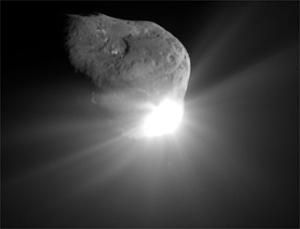
© NASA/JPL-Caltech/UMD
Deep Impact's impactor hit Comet Tempel 1, spewing debris, but the mission was not able to see the resulting crater
Deep Impact's impactor hit Comet Tempel 1, spewing debris, but the mission was not able to see the resulting crater
NASA's
Deep Impact mission pounded a comet in 2005, but failed to see the
resulting crater. Now, scientists will get a second chance to glimpse
the damage when a second spacecraft flies by the comet on 15 February.
In an unprecedented experiment, NASA smashed a 372-kilogram impactor into Comet Tempel 1 on 4 July 2005 as part of its Deep Impact mission.
A flyby spacecraft recorded images of the impact from a safe distance,
but the cloud of impact debris and a flawed camera made it impossible to
see the crater itself. Studying the crater could have revealed more
about the interior composition and structure of comets.
Now, another spacecraft is about to make its own fly-by of the comet, offering a second chance to image the structure.
Called Stardust, the spacecraft collected material from Comet Wild 2 in 2004 and sent it in a capsule back to Earth, where scientists have been studying it ever since.
Lucky sighting
Since the Stardust spacecraft was still in good health after its mission
to Wild 2, NASA decided in 2007 to send it to Tempel 1 as a follow-up
to the Deep Impact mission.
At 0437 GMT on 15 February (2037 PST on 14 February), the Stardust
spacecraft will complete its long journey to Tempel 1, flying within 200
kilometres of the comet's solid core, or nucleus.
In a press briefing on Wednesday, the mission team sought to dampen
expectations for imaging the crater itself, which might be
inconveniently located on the wrong side of the comet during the
spacecraft's brief encounter.
The comet is slowly rotating once every 41 hours and scientists do not
have enough information to guarantee that the side with the Deep Impact
crater will be in view at the time of the fly-by.
"I hope we get to see the impact crater, but that's going to be a
bonus," said Pete Schultz of Brown University in Providence, Rhode
Island.
Then and Now
Team members said much would be learned from the fly-by even if the crater remains elusive.
For example, scientists will look for changes since the Deep Impact
spacecraft's visit in 2005 that may be unrelated to the collision. Comets are constantly shedding gas and dust, which may have caused noticeable changes to Tempel 1's nucleus.
"We know that comets lose material, but the question is, how much does
the surface change and where does the surface change?" said Joe Veverka
of Cornell University in Ithaca, New York, the chief scientist for
Stardust's mission to Tempel 1. "We'll be able to answer that question
by comparing our images with those taken by Deep Impact in 2005."
Like the Stardust spacecraft, the Deep Impact spacecraft was also sent to visit a second comet. It flew by Comet Hartley 2 on 4 November, where it saw basketball-sized snowballs shed by the comet.
Unusually bright shooting star prompts sighting reports from Chicago to Indiana
An unusually bright shooting star shot across the sky Wednesday
night, prompting sighting reports from the Chicago area to Indiana, a
local astronomer said.
A green-tinted burst was reported by amateur astronomers in LaPorte,
Ind., just after 8 p.m.., said Adler Planetarium Astronomer Chris
Lintott.
The shooting star, which was a meteor probably about the size of 10
grains of salt, likely won't hit the ground and won't become a
meteorite, he said. Meteoroids are pieces of material traveling through
space that become meteors when they streak through the Earth's
atmosphere and meteorites if they strike the ground.
At least two motorists on Chicago-area expressways also reported seeing the flash.
It's "Good luck for those who saw it," Lintott said. "And very beautiful."
UK: 'Fireball' Soars Across Penarth
Sat, 22 Jan 2011 11:20 CST
Penarth Times, UK
Was it a bird? Was it a plane? No: it was a fireball over Penarth - according to one town resident anyway.
Translator Elisabeth Griffin was left with hot flushes recently after
seeing what she described as a 'fireball' soaring overhead.
The Cornerswell Road resident had gone for a relaxing stroll when she saw the sizzling sight above Victoria playing fields.
"I was taken aback by this unusual but fantastic object in the sky," she said.
"I knew it wasn't a plane immediately because it was too big and too bright.
"It literally stopped me in my tracks as I saw it pass me overhead - it must have taken about a minute."
But Elisabeth, originally from Germany, said she had no idea where it could have come from.
"I have never seen anything like it before in my life, although I have
heard similar reports of strange lights in the sky around here
recently," she added.
"Unfortunately I didn't have my camera - but I won't leave it behind again."
Big, green and glowing: Was it a meteor seen in mid-Michigan and other states?
Whatever it was, it was green.
When Alma College Geologist Murray Borrello was driving south on Wright
Avenue in Alma Wednesday evening and a big green light flashed across
the sky in front of him, other motorists traveling south put on their
brakes.
"You couldn't not see it," he said. "It would have caught your attention. It was a good sized object.
"Is it space junk? Something that fell from an airplane? I don't know. I
had a kind of sick feeling. It was big, green and glowing. I've seen
shooting stars. I've never seen green ones, but others have. It was
weird."
No calls came into Gratiot County's 911 central dispatch, but that wasn't the case in the metropolitan Detroit area.
Several Oakland and Macomb county police departments received calls from people saying they saw something weird around 9 p.m.
In the mid-Michigan area, Borrello wasn't the only one to see it.
Michigan State Police Sgt. Terry Guernsey and his wife Susan
were watching television about that time in their home near Maple
Rapids. With their big southern windows, they had front row seats for
the light show.
"I said, "Look at that, look at that," Susan Guernsey said. "It was
flourescent green and oblong. I saw it for several seconds. Looking
toward Fowler."
Susan said it did not drop like a stone and Terry Guernsey, who said he
has seen shooting stars and meteorites, hadn't seen anything like this.
"It did not come straight down. It was sort of diagonal," she said. "It
was oblong shape and somewhat dark in the middle. It was big."
Her husband agreed.
"It was big. It appeared too low, over Fowler."
For his part Borrello said it appeared round, but not perfectly so. It left very little trail.
He said it appeared to be white around the edges and it could have been dark in the center.
"You had a sense of distance," he said. "It would have fallen miles away."
Some reports from the metropolitan area said callers saw "an illuminated
object" fall from the sky, although there was no elaboration.
Reports of sightings have come from Indiana, Maryland, Louisiana and Illinois. The consensus is that it was a meteor.
David Batch, director of the Abrams Planetarium at Michigan State
University did not see the green light in the sky and so he can only
speculate what it was. But he has seen shooting stars and meteors of
every color.
The fact that it was seen to come down diagonally is typical of them, he said.
"It often appears horizontal unless you are right in line of its path," he said. "There is a sideways velocity."
"Bigness" he said, doesn't count. Brightness does.
The average shooting star seen in the night sky is likely the size of a
grain of sand. The light comes from the air surrounding it and its
speed, Batch said. Although most meteors are whitish or faintly yellow,
colors of green, red, or orange aren't unheard of.
Green however, is somewhat rare.
Something that can light up the whole sky is likely the size of a fist, he said..
"For the color to have been seen so vibrant, it had to have been quite
bright," he said. "Stars are colored but color can be detected only in
the bright ones."
Meteor or not, it was eerie.
"I saw this, swear to God," Rachel Fussman McClintic of Mt. Pleasant,
wrote in an e-mail. "I was driving home from a meeting last night at
this time. It WAS green...and I was driving down Mission, southbound,
toward campus.
"It scared me at first," she continued. "I thought, "Is a plane crashing
the ground? It weirded me out but then I just told myself it was a very
bright shooting star. And then I kind of forgot about it."
Two Major Fireballs Over North America on January 19
The American Meteor Society has received 39 reports of seven separate fireball events over North America on January 19th.
Two of these were widely seen events. Both of these events occurred near
21:00 EST. The first occurred over the northern Midwest and southern
Canada. There is some wide scattered timing of this event and the
possibility exists that this may be more than one fireball.
The second occurred over the southeastern states and was seen from
Florida north to North Carolina. There is good agreement for the timing
plus it seems to been a bit brighter with a majority of those reporting
that the peak brightness exceeded that of the full moon.
For more details please visit the AMS website.
Western Australia Meteorite Excites Scientists
A unique meteorite that smashed into the West Australian outback last year is exciting the scientific world.
The ancient rock has an unusual composition and is being studied by scientists around the globe.
Now in the Natural History Museum in London, the meteorite is undergoing
preliminary analysis and will be returned to the WA Museum when those
tests are complete.
Curtin University department of applied geology Adjunct Professor Phil
Bland said the meteorite, which is roughly the size of a tennis ball,
could reveal vital clues to the origins of the universe.
Not only is its chemistry proving intriguing but scientists were able to
track its fall to earth to determine where in the solar system it came
from.
There have been more than 50,000 documented meteorite falls over the
past 200 years but scientists know the origins of just 10, highlighting
the importance of the latest find.
Meteorites are the oldest rocks in existence and contain a 4.56 billion-year record of solar system's formation and evolution.
The latest meteorite's orbit was tracked using a series of stargazing
cameras set up in remote areas of WA under a special international
project involving Curtin University, the Imperial College London,
Ondrejov Observatory in the Czech Republic and the WA Museum.
The cameras capture the meteorites on their orbit to earth and,
using a complex series of calculations, are able to pinpoint their
crash sites within 100m.
"Because every rock has a precise orbit, our meteorites will be a unique
sample set: researchers worldwide will be requesting this material for
decades. So as the collection grows, in addition to the science that
we're doing with it, I think that'll be good for the long term profile
of Australian planetary science, and for all those institutions
involved," Professor Bland said.
"Meteorites are like ancient jigsaw puzzle pieces. When we find out
where one comes from, it is like putting in another tiny piece of the
puzzle, providing insights into the workings of our solar system and how
it began billions of years ago.
He said meteorites were a geological record of the formation of the
solar system, providing important information about early conditions.
"Locating where they come from is important, because it enables
scientists to link geological information to the correct location in
space," he said.
"We've only really just started analysing (this latest meteorite). We've
got a very precise orbit for it, so we're currently looking through the
asteroid database to see if there's anything out there that matches it -
that could have been the source for our rock. But in terms of
composition, it does look kind of interesting."
Professor Bland said the meteorite tracking project could provide some
fundamental insights into how the solar system and rocky terrestrial
planets formed.
"This is a great time for planetary science. But we are kind of where
geology was in the 1950s. We've still not had our 'plate tectonics
moment' - a general theory that pulls all those pieces together. Thanks
to plate tectonics we know how our planet works. We just don't know how
it was made.
"Meteorites offer perhaps our most direct route to an answer."
US, Indiana: Meteorite Reported This Morning.....Historical Viewing-Area Meteorites
Meteorite Over Carroll County This Morning:
Kelly Britton reported a meteorite just south of Delphi this morning at 5:20 a.m. Here is her account from her email:
Didn't know if anybody saw what I saw this morning, 5:20am just south of
Delphi. I saw a low flying light streak with a red glow around it and
it was moving fast. First, I thought it was a plane going down at the
Delphi airport, I thought no it was going way to fast for that. I've
looked around on the local net and haven't saw anything yet. As low as
it was you would of thought you could see something on the ground?
I have not had other reports, but it sure sounds like a meteorite that
burned up in the lower atmosphere. She stated in a second email, it
looked like it had to have been 100′ from the ground. Most of the time
they burn up much higher than that, but the distortions caused by the
curvature of the earth make them appear much closer to the ground. That
is not to say a meteorite could end up in someone's field..........it
has happened before.
This map & data courtesy of Indiana University:
f they explode very low in the atmosphere, they can produce a sonic boom.
Account of a Meteorite in Jasper County in 1870:
Here is a copy of his weather record sheet from February 1870 in the
first image & the account of the meteorite in the second. I have
deciphered the paragraph concerning the meteorite in the third graphic:
(I am truly indebted to NOAA & the National Climate Data Center for
their help in giving me access to this historical meteorological
document. BIG THANKS to them!)
J.H. Loughmidger, MD, February 25, 1870:
25th - At about 15 minutes after 2 o'clock a.m., I observed a very
bright meteor almost as bright as the full moon, passing from south west
to n'east. When about 40* N.D. of the zenith it exploded into five or
six fragments, which like balls of white light was projected forwards
and to either side of a couple of 15 or 20 degrees and gradually
disappeared. In from one to two minutes afterward (the time not noted
with accuracy) a loud and distant noise was heard, resembling thunder,
not very distant, or the discharged heavy (can't read next word on
document), followed that of six pounders, or platoons of musketry. The
first sound was heavy and distinct followed immediately by a rumbling,
rattling and reverberating sound. The light of the meteor seemed almost
or brighter [than] sun light and lasted near one second of time, and so
far as I can learn was not seen by any one but myself, it being my good
fortune to be returning from a professional visit at the time. But,
the sound of the explosion was heard by several persons in their homes
and attributed to other causes until informed of the phenomenon.
Did You See That Fireball?
Sun, 23 Jan 2011 13:36 CST
Space Weather
Spaceweather.com
is seeking reports of a possible fireball or other bright lights in the
sky over North America on Jan. 18th around 4 am EST.
The area of particular interest extends from Lake Michigan to southern
parts of Ontario and upper New York state. Did you see anything? Submit
your reports here.
Comet Hartley 2 Pumps Out the Cyanide
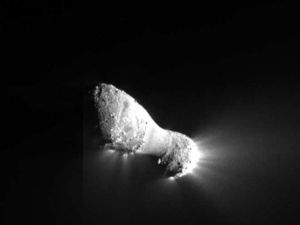
© NASA/JPL-Caltech/UMD
Close-up
photo of Comet Hartley 2 from the Nov. 4, 2010 flyby performed by
NASA's Deep Impact spacecraft. Image captured by the spacecraft's
Medium-Resolution Instrument.
Close-up
photo of Comet Hartley 2 from the Nov. 4, 2010 flyby performed by
NASA's Deep Impact spacecraft. Image captured by the spacecraft's
Medium-Resolution Instrument.
Comet Hartley 2 has
graced our night skies for several weeks, reaching its closest approach
(unfortunately timed near the full moon) on October 18th. NASA is taking
advantage of this near approach to visit the comet with the Deep
Impact/EPOXI mission, and they are already making surprising
discoveries.
Deep Impact
put on a spectacular show for scientists and space-geeks alike when it
rendezvoused with Comet Tempel 1 in 2005, smashing a projectile into the
dirty snowball in order to see what lies just beneath the surface. The
mission, now renamed EPOXI, has taken the spacecraft past Earth several times on its way to a new cometary target, Hartley 2.
The craft's closest approach to the comet will be on November 4th, when
it will pass just 435 miles from the comet nucleus just as it is
starting to warm up and become active in its approach of the Sun.
However, science observations are already underway, as data taken in early September indicates that Hartley 2 increased its cyanide output five-fold over a period of just eight days.
Cyanide is a deadly gas to we humans, however, it is a common
carbon-based molecule found on comets. In fact, comets are thought to
have brought many life-building organic molecules to the newly formed
Earth 4.5 billion years ago. (You can represent that in a model comet by adding soda or corn syrup!)
Usually, however, an increase in such outgassing is accompanied by dust
emissions as well, and this was not seen. So, the comet is behaving
strangely, and astronomers are excited to get an even closer look of
this very active comet in the coming days.
In addition, Earth-bound skywatchers may be treated to an extra surprise from Hartley 2. Fireballs
seen in Canada and the southeastern United States just five hours apart
seemed to have the same trajectory as each other and the comet.
Though this may be coincidence, there is some small chance that they
are all related and that a new meteor shower will be discovered from the
debris of Comet Hartley 2.
Even if you don't see any fireballs, be sure to check out what promises to be stunning images from the close encounter on November 4th!
The sky is falling: Odds for a potentially devastating space rock to hit Earth are 1 in 10
The
odds that a potentially devastating space rock will hit Earth this
century may be as high as one in 10. So why isn't NASA trying harder to
prevent catastrophe?
Breakthrough ideas have a way of seeming obvious in retrospect, and
about a decade ago, a Columbia University geophysicist named Dallas
Abbott had a breakthrough idea. She had been pondering the craters left
by comets and asteroids that smashed into Earth. Geologists had counted
them and concluded that space strikes are rare events and had occurred
mainly during the era of primordial mists. But, Abbott realized, this
deduction was based on the number of craters found on land - and because
70 percent of Earth's surface is water, wouldn't most space objects hit
the sea? So she began searching for underwater craters caused by
impacts rather than by other forces, such as volcanoes. What she
has found is spine-chilling: evidence that several enormous asteroids
or comets have slammed into our planet quite recently, in geologic
terms. If Abbott is right, then you may be here today, reading this
magazine, only because by sheer chance those objects struck the ocean
rather than land.
Abbott believes that a space object about 300 meters in
diameter hit the Gulf of Carpentaria, north of Australia, in 536 A.D. An
object that size, striking at up to 50,000 miles per hour, could
release as much energy as 1,000 nuclear bombs. Debris, dust, and gases
thrown into the atmosphere by the impact would have blocked sunlight,
temporarily cooling the planet - and indeed, contemporaneous accounts
describe dim skies, cold summers, and poor harvests in 536 and 537. "A
most dread portent took place," the Byzantine historian Procopius wrote
of 536; the sun "gave forth its light without brightness." Frost
reportedly covered China in the summertime. Still, the harm was
mitigated by the ocean impact. When a space object strikes land, it
kicks up more dust and debris, increasing the global-cooling effect; at
the same time, the combination of shock waves and extreme heating at the
point of impact generates nitric and nitrous acids, producing rain as
corrosive as battery acid. If the Gulf of Carpentaria object
were to strike Miami today, most of the city would be leveled, and the
atmospheric effects could trigger crop failures around the world.
What's more, the Gulf of Carpentaria object was a skipping stone
compared with an object that Abbott thinks whammed into the Indian Ocean
near Madagascar some 4,800 years ago, or about 2,800 B.C. Researchers
generally assume that a space object a kilometer or more across would
cause significant global harm: widespread destruction, severe acid rain,
and dust storms that would darken the world's skies for decades. The
object that hit the Indian Ocean was three to five kilometers across,
Abbott believes, and caused a tsunami in the Pacific 600 feet high -
many times higher than the 2004 tsunami that struck Southeast Asia.
Ancient texts such as Genesis and the Epic of Gilgamesh support her
conjecture, describing an unspeakable planetary flood in roughly the
same time period. If the Indian Ocean object were to hit the sea now,
many of the world's coastal cities could be flattened. If it were to hit
land, much of a continent would be leveled; years of winter and mass
starvation would ensue.
At the start of her research, which has sparked much debate among
specialists, Abbott reasoned that if colossal asteroids or comets strike
the sea with about the same frequency as they strike land, then given
the number of known land craters, perhaps 100 large impact craters might
lie beneath the oceans. In less than a decade of searching, she
and a few colleagues have already found what appear to be 14 large
underwater impact sites. That they've found so many so rapidly is hardly
reassuring.
Other scientists are making equally unsettling discoveries. Only in the
past few decades have astronomers begun to search the nearby skies for
objects such as asteroids and comets (for convenience, let's call them
"space rocks"). What they are finding suggests that near-Earth space
rocks are more numerous than was once thought, and that their orbits may
not be as stable as has been assumed. There is also reason to
think that space rocks may not even need to reach Earth's surface to
cause cataclysmic damage. Our solar system appears to be a far more
dangerous place than was previously believed.
The received wisdom about the origins of the solar system goes something
like this: the sun and planets formed about 4.5 billion years ago from a
swirling nebula containing huge amounts of gas and dust, as well as
relatively small amounts of metals and other dense substances released
by ancient supernova explosions. The sun is at the center; the denser
planets, including Earth, formed in the middle region, along with many
asteroids - the small rocky bodies made of material that failed to
incorporate into a planet. Farther out are the gas-giant planets, such
as Jupiter, plus vast amounts of light elements, which formed comets on
the boundary of the solar system. Early on, asteroids existed by the
millions; the planets and their satellites were bombarded by constant,
furious strikes. The heat and shock waves generated by these impacts
regularly sterilized the young Earth. Only after the rain of space
objects ceased could life begin; by then, most asteroids had already
either hit something or found stable orbits that do not lead toward
planets or moons. Asteroids still exist, but most were assumed to be in
the asteroid belt, which lies between Mars and Jupiter, far from our
blue world.
As for comets, conventional wisdom held that they also bombarded the
planets during the early eons. Comets are mostly frozen water mixed with
dirt. An ancient deluge of comets may have helped create our oceans;
lots of comets hit the moon, too, but there the light elements they were
composed of evaporated. As with asteroids, most comets were thought to
have smashed into something long ago; and, because the solar system is
largely void, researchers deemed it statistically improbable that those
remaining would cross the paths of planets.
These standard assumptions - that remaining space rocks are few, and
that encounters with planets were mainly confined to the past - are
being upended. On March 18, 2004, for instance, a 30-meter asteroid
designated 2004 FH - a hunk potentially large enough to obliterate a
city - shot past Earth, not far above the orbit occupied by
telecommunications satellites. (Enter "2004 FH" in the search box at
Wikipedia and you can watch film of that asteroid passing through the
night sky.) Looking at the broader picture, in 1992 the astronomers
David Jewitt, of the University of Hawaii, and Jane Luu, of the
Massachusetts Institute of Technology, discovered the Kuiper Belt, a
region of asteroids and comets that starts near the orbit of Neptune and
extends for immense distances outward. At least 1,000 objects big
enough to be seen from Earth have already been located there. These
objects are 100 kilometers across or larger, much bigger than whatever
dispatched the dinosaurs; space rocks this size are referred to as
"planet killers" because their impact would likely end life on Earth.
Investigation of the Kuiper Belt has just begun, but there appear to be
substantially more asteroids in this region than in the asteroid belt,
which may need a new name.
Beyond the Kuiper Belt may lie the hypothesized Oort Cloud, thought to
contain as many as trillions of comets. If the Oort Cloud does exist,
the number of extant comets is far greater than was once believed. Some
astronomers now think that short-period comets, which swing past the sun
frequently, hail from the relatively nearby Kuiper Belt, whereas comets
whose return periods are longer originate in the Oort Cloud.
But if large numbers of comets and asteroids are still around, several
billion years after the formation of the solar system, wouldn't they by
now be in stable orbits - ones that rarely intersect those of the
planets? Maybe not. During the past few decades, some astronomers have
theorized that the movement of the solar system within the Milky Way
varies the gravitational stresses to which the sun, and everything that
revolves around it, is exposed. The solar system may periodically pass
close to stars or groups of stars whose gravitational pull affects the
Oort Cloud, shaking comets and asteroids loose from their orbital
moorings and sending them downward, toward the inner planets.
Consider objects that are already near Earth, and the picture gets even
bleaker. Astronomers traditionally spent little time looking for
asteroids, regarding them as a lesser class of celestial bodies, lacking
the beauty of comets or the significance of planets and stars. Plus,
asteroids are hard to spot - they move rapidly, compared with the rest
of the heavens, and even the nearby ones are fainter than other objects
in space. Not until the 1980s did scientists begin systematically
searching for asteroids near Earth. They have been finding them in
disconcerting abundance.
In 1980, only 86 near-Earth asteroids and comets were known to exist. By
1990, the figure had risen to 170; by 2000, it was 921; as of this
writing, it is 5,388. The Jet Propulsion Laboratory, part of NASA, keeps
a running tally at www.neo.jpl.nasa.gov/stats. Ten years ago, 244
near-Earth space rocks one kilometer across or more - the size that
would cause global calamity - were known to exist; now 741 are. Of the
recently discovered nearby space objects, NASA has classified 186 as
"impact risks" (details about these rocks are here).
And because most space-rock searches to date have been low-budget
affairs, conducted with equipment designed to look deep into the
heavens, not at nearby space, the actual number of impact risks is
undoubtedly much higher. Extrapolating from recent discoveries, NASA
estimates that there are perhaps 20,000 potentially hazardous asteroids
and comets in the general vicinity of Earth.
There's still more bad news. Earth has experienced several mass
extinctions - the dinosaurs died about 65 million years ago, and
something killed off some 96 percent of the world's marine species about
250 million years ago. Scientists have generally assumed that whatever
caused those long-ago mass extinctions - comet impacts, extreme volcanic
activity - arose from conditions that have changed and no longer pose
much threat. It's a comforting notion - but what about the mass
extinction that occurred close to our era?
About 12,000 years ago, many large animals of North America started
disappearing - woolly mammoths, saber-toothed cats, mastodons, and
others. Some scientists have speculated that Paleo-Indians may have
hunted some of the creatures to extinction. A millennia-long mini - Ice
Age also may have been a factor. But if that's the case, what explains
the disappearance of the Clovis People, the best-documented Paleo-Indian
culture, at about the same time? Their population stretched as far
south as Mexico, so the mini - Ice Age probably was not solely
responsible for their extinction.
A team of researchers led by Richard Firestone, of the Lawrence Berkeley
National Laboratory, in California, recently announced the discovery of
evidence that one or two huge space rocks, each perhaps several
kilometers across, exploded high above Canada 12,900 years ago. The
detonation, they believe, caused widespread fires and dust clouds, and
disrupted climate patterns so severely that it triggered a prolonged
period of global cooling. Mammoths and other species might have been
killed either by the impact itself or by starvation after their food
supply was disrupted. These conclusions, though hotly disputed by other
researchers, were based on extensive examinations of soil samples from
across the continent; in strata from that era, scientists found widely
distributed soot and also magnetic grains of iridium, an element that is
rare on Earth but common in space. Iridium is the meteor-hunter's
lodestar: the discovery of iridium dating back 65 million years is what
started the geologist Walter Alvarez on his path-breaking theory about
the dinosaurs' demise.
A more recent event gives further cause for concern. As buffs of the television show The X Files
will recall, just a century ago, in 1908, a huge explosion occurred
above Tunguska, Siberia. The cause was not a malfunctioning alien
star-cruiser but a small asteroid or comet that detonated as it
approached the ground. The blast had hundreds of times the force of the
Hiroshima bomb and devastated an area of several hundred square miles.
Had the explosion occurred above London or Paris, the city would no
longer exist. Mark Boslough, a researcher at the Sandia National
Laboratory, in New Mexico, recently concluded that the Tunguska object
was surprisingly small, perhaps only 30 meters across. Right now,
astronomers are nervously tracking 99942 Apophis, an asteroid with a
slight chance of striking Earth in April 2036. Apophis is also small by
asteroid standards, perhaps 300 meters across, but it could hit with
about 60,000 times the force of the Hiroshima bomb - enough to destroy
an area the size of France. In other words, small asteroids may
be more dangerous than we used to think - and may do considerable damage
even if they don't reach Earth's surface.
Until
recently, nearly all the thinking about the risks of space-rock strikes
has focused on counting craters. But what if most impacts don't leave
craters? This is the prospect that troubles Boslough. Exploding
in the air, the Tunguska rock did plenty of damage, but if people had
not seen the flashes, heard the detonation, and traveled to the remote
area to photograph the scorched, flattened wasteland, we'd never know
the Tunguska event had happened. Perhaps a comet or two exploding above
Canada 12,900 years ago spelled the end for saber-toothed cats and
Clovis society. But no obvious crater resulted; clues to the calamity
were subtle and hard to come by.
Comets, asteroids, and the little meteors that form pleasant shooting
stars approach Earth at great speeds - at least 25,000 miles per hour.
As they enter the atmosphere they heat up, from friction, and compress,
because they decelerate rapidly. Many space rocks explode under this
stress, especially small ones; large objects are more likely to reach
Earth's surface. The angle at which objects enter the atmosphere also
matters: an asteroid or comet approaching straight down has a better
chance of hitting the surface than one entering the atmosphere at a
shallow angle, as the latter would have to plow through more air,
heating up and compressing as it descended. The object or objects that
may have detonated above Canada 12,900 years ago would probably have
approached at a shallow angle.
If, as Boslough thinks, most asteroids and comets explode before
reaching the ground, then this is another reason to fear that the
conventional thinking seriously underestimates the frequency of
space-rock strikes - the small number of craters may be lulling us into
complacency. After all, if a space rock were hurtling toward a city,
whether it would leave a crater would not be the issue - the explosion
would be the issue.
A generation ago, the standard assumption was that a dangerous object
would strike Earth perhaps once in a million years. By the mid-1990s,
researchers began to say that the threat was greater: perhaps a strike
every 300,000 years. This winter, I asked William Ailor, an asteroid
specialist at The Aerospace Corporation, a think tank for the Air Force,
what he thought the risk was. Ailor's answer: a one-in-10 chance per
century of a dangerous space-object strike.
Regardless of which estimate is correct, the likelihood of an event is, of course, no predictor. Even if space strikes are likely
only once every million years, that doesn't mean a million years will
pass before the next impact - the sky could suddenly darken tomorrow.
Equally important, improbable but cataclysmic dangers ought to command
attention because of their scope. A tornado is far more likely than an
asteroid strike, but humanity is sure to survive the former. The chances
that any one person will die in an airline crash are minute, but this
does not prevent us from caring about aviation safety. And as Nathan
Myhrvold, the former chief technology officer of Microsoft, put it, "The
odds of a space-object strike during your lifetime may be no more than
the odds you will die in a plane crash - but with space rocks, it's like
the entire human race is riding on the plane."
Given the scientific findings, shouldn't space rocks be one of
NASA's priorities? You'd think so, but Dallas Abbott says NASA has shown
no interest in her group's work: "The NASA people don't want to believe
me. They won't even listen."
NASA supports some astronomy to search for near-Earth objects, but the
agency's efforts have been piecemeal and underfunded, backed by less
than a tenth of a percent of the NASA budget. And though altering the
course of space objects approaching Earth appears technically feasible,
NASA possesses no hardware specifically for this purpose, has nearly
nothing in development, and has resisted calls to begin work on
protection against space strikes. Instead, NASA is enthusiastically
preparing to spend hundreds of billions of taxpayers' dollars on a
manned moon base that has little apparent justification. "What is in the
best interest of the country is never even mentioned in current NASA
planning," says Russell Schweickart, one of the Apollo astronauts who
went into space in 1969, who is leading a campaign to raise awareness of
the threat posed by space rocks. "Are we going to let a space strike
kill millions of people before we get serious about this?" he asks.
In January, I attended an internal NASA conference, held at agency
headquarters, during which NASA's core goals were presented in a
PowerPoint slideshow. Nothing was said about protecting Earth from space
strikes - not even researching what sorts of spacecraft might be used
in an approaching-rock emergency. Goals that were listed included
"sustained human presence on the moon for national preeminence" and
"extend the human presence across the solar system and beyond."
Achieving national preeminence - isn't the United States pretty
well-known already? As for extending our presence, a manned mission to
Mars is at least decades away, and human travel to the outer planets is
not seriously discussed by even the most zealous advocates of space
exploration. Sending people "beyond" the solar system is inconceivable
with any technology that can reasonably be foreseen; an interstellar
spaceship traveling at the fastest speed ever achieved in space flight
would take 60,000 years to reach the next-closest star system.
After the presentation, NASA's administrator, Michael Griffin, came into
the room. I asked him why there had been no discussion of space rocks.
He said, "We don't make up our goals. Congress has not
instructed us to provide Earth defense. I administer the policy set by
Congress and the White House, and that policy calls for a focus on
return to the moon. Congress and the White House do not ask me what I
think." I asked what NASA's priorities would be if he did set the goals.
"The same. Our priorities are correct now," he answered. "We are on the
right path. We need to go back to the moon. We don't need a
near-Earth-objects program." In a public address about a month
later, Griffin said that the moon-base plan was "the finest policy
framework for United States civil space activities that I have seen in
40 years."
Actually, Congress has asked NASA to pay more attention to
space rocks. In 2005, Congress instructed the agency to mount a
sophisticated search of the proximate heavens for asteroids and comets,
specifically requesting that NASA locate all near-Earth objects 140
meters or larger that are less than 1.3 astronomical units from the sun -
roughly out to the orbit of Mars. Last year, NASA gave Congress its
reply: an advanced search of the sort Congress was requesting would cost
about $1 billion, and the agency had no intention of diverting funds
from existing projects, especially the moon-base initiative.
How did the moon-base idea arise? In 2003, after the shuttle Columbia
was lost, manned space operations were temporarily shut down, and the
White House spent a year studying possible new missions for NASA. George
W. Bush wanted to announce a voyage to Mars. Every Oval Office occupant
since John F. Kennedy knows how warmly history has praised him for the
success of his pledge to put men on the moon; it's only natural that
subsequent presidents would dream about securing their own place in
history by sending people to the Red Planet. But the technical barriers
and even the most optimistic cost projections for a manned mission to
Mars are prohibitive. So in 2004, Bush unveiled a compromise plan: a
permanent moon base that would be promoted as a stepping-stone for a
Mars mission at some unspecified future date. As anyone with an
aerospace engineering background well knows, stopping at the moon, as
Bush was suggesting, actually would be an impediment to Mars travel,
because huge amounts of fuel would be wasted landing on the moon and
then blasting off again. Perhaps something useful to a Mars expedition
would be learned in the course of building a moon base; but if the goal
is the Red Planet, then spending vast sums on lunar living would only
divert that money from the research and development needed for Mars
hardware. However, saying that a moon base would one day support a Mars
mission allowed Bush to create the impression that his plan would not
merely be restaging an effort that had already been completed more than
30 years before. For NASA, a decades-long project to build a moon base
would ensure a continuing flow of money to its favorite contractors and
to the congressional districts where manned-space-program centers are
located. So NASA signed on to the proposal, which Congress approved the
following year.
It is instructive, in this context, to consider the agency's rhetoric
about China. The Chinese manned space program has been improving and is
now about where the U.S. program was in the mid-1960s. Stung by
criticism that the moon-base project has no real justification - 37
years ago, President Richard Nixon cancelled the final planned Apollo
moon missions because the program was accomplishing little at great
expense; as early as 1964, the communitarian theorist Amitai Etzioni was
calling lunar obsession a "moondoggle" - NASA is selling the new plan
as a second moon race, this time against Beijing. "I'll be surprised if
the Chinese don't reach the moon before we return," Griffin said. "China
is now a strategic peer competitor to the United States in space. China
is drawing national prestige from achievements in space, and there will
be a tremendous shift in national prestige toward Beijing if the
Chinese are operating on the moon and we are not. Great nations have
always operated on the frontiers of their era. The moon is the frontier
of our era, and we must outperform the Chinese there."
Wouldn't shifting NASA's focus away from wasting money on the moon and
toward something of clear benefit for the entire world - identifying and
deflecting dangerous space objects - be a surer route to enhancing
national prestige? But NASA's institutional instinct is not to ask,
"What can we do in space that makes sense?" Rather, it is to ask, "What
can we do in space that requires lots of astronauts?" That finding and
stopping space rocks would be an expensive mission with little role for
the astronaut corps is, in all likelihood, the principal reason NASA
doesn't want to talk about the asteroid threat.
NASA's lack of interest in defending against space objects leaves a void
the Air Force seems eager to fill. The Air Force has the world's
second-largest space program, with a budget of about $11 billion - $6
billion less than NASA's. The tension between the two entities is
long-standing. Many in the Air Force believe the service could achieve
U.S. space objectives faster and more effectively than NASA. And the Air
Force simply wants flyboys in orbit: several times in the past, it has
asked Congress to fund its own space station, its own space plane, and
its own space-shuttle program. Now, with NASA all but ignoring the
space-object threat, the Air Force appears to be seizing an opportunity.
All known space rocks have been discovered using telescopes designed for
traditional "soda straw" astronomy - that is, focusing on a small patch
of sky. Now the Air Force is funding the first research installation
designed to conduct panoramic scans of the sky, a telescope complex
called Pan-STARRS, being built by the University of Hawaii. By
continuously panning the entire sky, Pan-STARRS should be able to spot
many near-Earth objects that so far have gone undetected. The telescope
also will have substantially better resolving power and sensitivity than
existing survey instruments, enabling it to find small space rocks that
have gone undetected because of their faintness.
The Pan-STARRS project has no military utility, so why is the
Air Force the sponsor? One speculation is that Pan-STARRS is the Air
Force's foot in the door for the Earth-defense mission. If the Air Force
won funding to build high-tech devices to fire at asteroids, this would
be a major milestone in its goal of an expanded space presence.
But space rocks are a natural hazard, not a military threat, and an Air
Force Earth-protection initiative, however gallant, would probably
cause intense international opposition. Imagine how other governments
would react if the Pentagon announced, "Don't worry about those
explosions in space - we're protecting you."
Thus, the task of defending Earth from objects falling from the skies
seems most fitting for NASA, or perhaps for a multinational civilian
agency that might be created. Which raises the question: What could
NASA, or anyone else, actually do to provide a defense?
Russell Schweickart, the former Apollo astronaut, runs the B612
Foundation (B612 is the asteroid home of Saint-Exupéry's Little
Prince). The foundation's goal is to get NASA officials, Congress, and
ultimately the international community to take the space-rock threat
seriously; it advocates testing a means of precise asteroid tracking,
then trying to change the course of a near-Earth object.
Current telescopes cannot track asteroids or comets accurately enough
for researchers to be sure of their courses. When 99942 Apophis was
spotted, for example, some calculations suggested it would strike Earth
in April 2029, but further study indicates it won't - instead, Apophis
should pass between Earth and the moon, during which time it may be
visible to the naked eye. The Pan-STARRS telescope complex will greatly
improve astronomers' ability to find and track space rocks, and it may
be joined by the Large Synoptic Survey Telescope, which would similarly
scan the entire sky. Earlier this year, the software billionaires Bill
Gates and Charles Simonyi pledged $30 million for work on the LSST,
which proponents hope to erect in the mountains of Chile. If it is
built, it will be the first major telescope to broadcast its data live
over the Web, allowing countless professional and amateur astronomers to
look for undiscovered asteroids.
Schweickart thinks, however, that even these instruments will
not be able to plot the courses of space rocks with absolute precision. NASA
has said that an infrared telescope launched into an orbit near Venus
could provide detailed information on the exact courses of space rocks.
Such a telescope would look outward from the inner solar system toward
Earth, detect the slight warmth of asteroids and comets against the cold
background of the cosmos, and track their movements with precision.
Congress would need to fund a near-Venus telescope, though, and NASA
would need to build it - neither of which is happening.
Another means of gathering data about a potentially threatening
near-Earth object would be to launch a space probe toward it and attach a
transponder, similar to the transponders used by civilian airliners to
report their exact locations and speed; this could give researchers
extremely precise information on the object's course. There is no doubt
that a probe can rendezvous with a space rock: in 2005, NASA smashed a
probe called Deep Impact into the nucleus of comet 9P/Tempel in order to
vaporize some of the material on the comet's surface and make a
detailed analysis of it. Schweickart estimates that a mission to attach a
transponder to an impact-risk asteroid could be staged for about $400
million - far less than the $11.7 billion cost to NASA of the 2003
Columbia disaster.
Then what? In the movies, nuclear bombs are used to destroy space rocks.
In NASA's 2007 report to Congress, the agency suggested a similar
approach. But nukes are a brute-force solution, and because an
international treaty bans nuclear warheads in space, any proposal to use
them against an asteroid would require complex diplomatic agreements.
Fortunately, it's likely that just causing a slight change in course
would avert a strike. The reason is the mechanics of orbits. Many people
think of a planet as a vacuum cleaner whose gravity sucks in everything
in its vicinity. It's true that a free-falling body will plummet toward
the nearest source of gravity - but in space, free-falling bodies are
rare. Earth does not plummet into the sun, because the angular momentum
of Earth's orbit is in equilibrium with the sun's gravity. And asteroids
and comets swirl around the sun with tremendous angular momentum, which
prevents them from falling toward most of the bodies they pass,
including Earth.
For any space object approaching a planet, there exists a "keyhole" - a
patch in space where the planet's gravity and the object's momentum
align, causing the asteroid or comet to hurtle toward the planet.
Researchers have calculated the keyholes for a few space objects and
found that they are tiny, only a few hundred meters across - pinpoints
in the immensity of the solar system. You might think of a keyhole as
the win-a-free-game opening on the 18th tee of a cheesy, incredibly
elaborate miniature-golf course. All around the opening are rotating
windmills, giants stomping their feet, dragons walking past, and other
obstacles. If your golf ball hits the opening precisely, it will roll
down a pipe for a hole in one. Miss by even a bit, and the ball caroms
away.
Tiny alterations might be enough to deflect a space rock headed toward a
keyhole. "The reason I am optimistic about stopping near-Earth-object
impacts is that it looks like we won't need to use fantastic levels of
force," Schweickart says. He envisions a "gravitational tractor," a
spacecraft weighing only a few tons - enough to have a slight
gravitational field. If an asteroid's movements were precisely
understood, placing a gravitational tractor in exactly the right place
should, ever so slowly, alter the rock's course, because low levels of
gravity from the tractor would tug at the asteroid. The rock's course
would change only by a minuscule amount, but it would miss the
hole-in-one pipe to Earth.
Will the gravitational-tractor idea work? The B612 Foundation recommends
testing the technology on an asteroid that has no chance of approaching
Earth. If the gravitational tractor should prove impractical or
ineffective, other solutions could be considered. Attaching a rocket
motor to the side of an asteroid might change its course. So might
firing a laser: as materials boiled off the asteroid, the expanding
gases would serve as a natural jet engine, pushing it in the opposite
direction.
But when it comes to killer comets, you'll just have to lose sleep over
the possibility of their approach; there are no proposals for what to do
about them. Comets are easy to see when they are near the sun and
glowing but are difficult to detect at other times. Many have
"eccentric" orbits, spending centuries at tremendous distances from the
sun, then falling toward the inner solar system, then slingshotting away
again. If you were to add comets to one of those classroom models of
the solar system, many would need to come from other floors of the
building, or from another school district, in order to be to scale.
Advanced telescopes will probably do a good job of detecting most
asteroids that pass near Earth, but an unknown comet suddenly headed our
way would be a nasty surprise. And because many comets change course
when the sun heats their sides and causes their frozen gases to expand,
deflecting or destroying them poses technical problems to which there
are no ready solutions. The logical first step, then, seems to be to
determine how to prevent an asteroid from striking Earth and hope that
some future advance, perhaps one building on the asteroid work, proves
useful against comets.
None of this will be easy, of course. Unlike in the movies, where
impossibly good-looking, wisecracking men and women grab space suits and
race to the launchpad immediately after receiving a warning that
something is approaching from space, in real life preparations to defend
against a space object would take many years. First the necessary
hardware must be built - quite possibly a range of space probes and
rockets. An asteroid that appeared to pose a serious risk would require
extensive study, and a transponder mission could take years to reach it.
International debate and consensus would be needed: the possibility of
one nation acting alone against a space threat or of, say, competing
U.S. and Chinese missions to the same object, is more than a little
worrisome. And suppose Asteroid X appeared to threaten Earth. A mission
by, say, the United States to deflect or destroy it might fail, or even
backfire, by nudging the rock toward a gravitational keyhole rather than
away from it. Asteroid X then hits Costa Rica; is the U.S. to blame? In
all likelihood, researchers will be unable to estimate where on Earth a
space rock will hit. Effectively, then, everyone would be threatened,
another reason nations would need to act cooperatively - and achieving
international cooperation could be a greater impediment than designing
the technology.
We will soon have a new president, and thus an opportunity to reassess
NASA's priorities. Whoever takes office will decide whether the nation
commits to spending hundreds of billions of dollars on a motel on the
moon, or invests in space projects of tangible benefit - space science,
environmental studies of Earth, and readying the world for protection
against a space-object strike. Although the moon-base initiative has
been NASA's focus for four years, almost nothing has yet been built for
the project, and comparatively little money has been spent; current
plans don't call for substantial funding until the space-shuttle program
ends, in 2010. This suggests that NASA could back off from the moon
base without having wasted many resources. Further, the new Ares rocket
NASA is designing for moon missions might be just the ticket for an
asteroid-deflection initiative.
Congress, too, ought to look more sensibly at space priorities. Because
it controls federal funding, Congress holds the trump cards. In 2005, it
passively approved the moon-base idea, seemingly just as budgetary
log-rolling to maintain spending in the congressional districts favored
under NASA's current budget hierarchy. The House and Senate ought to
demand that the space program have as its first priority returning
benefits to taxpayers. It's hard to imagine how taxpayers could
benefit from a moon base. It's easy to imagine them benefiting from an
effort to protect our world from the ultimate calamity.
Gregg Easterbrook is a contributing editor of The Atlantic and The
New Republic, a fellow at the Brookings Institution, and the author,
most recently, of The Progress Paradox (2003).
Exploding Comet Could Have Blown Up With Carbon Monoxide
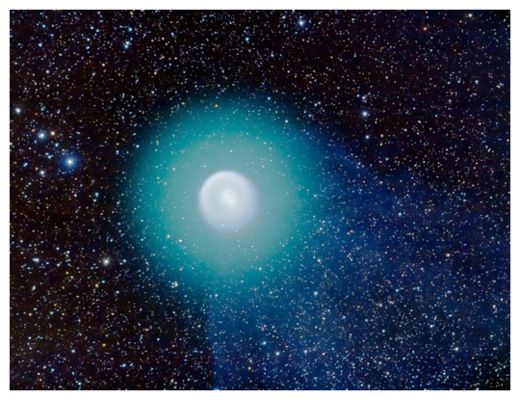
© NASA/ESA/A. Dyer
Comet Holmes as captured by astrophotographer Alan Dyer in Alberta, Canada, on Nov. 1, 2007.
Comet Holmes as captured by astrophotographer Alan Dyer in Alberta, Canada, on Nov. 1, 2007.
The mysterious, spectacular flare of Comet 17P/Holmes has been
observed three times, and it may give warning of an imminent explosion
fueled by carbon monoxide gas when it returns in 2014, say astronomers.
Holmes shocked the world in October 2007 when it suddenly brightened by a factor of 500,000,
going from a humdrum ball of dust to a brilliant orb visible to the
naked eye. The comet spewed 100 million tons of dust into space,
comparable to the amount of ash unleashed by Mount St. Helens, and
briefly swelled to a diameter greater than the sun's.
But despite months of observations from hundreds of telescopes, the cause of Holmes' dramatic explosion remains unknown.
Astronomers initially suggested that a dusty crust may have formed on
the comet's nucleus as it approached the sun, trapping frozen ice
underneath. As it neared the sun, the surface would heat so rapidly that
the ice turned from solid to gas without even melting. Gas would build
up and burst through the crust, sending Holmes' innards flying outward.
Read the rest of the article at Wired.com
Asteroids Ahoy! Jupiter Scar Likely from Rocky Body
A hurtling asteroid about the size of the Titanic caused the
scar that appeared in Jupiter's atmosphere on July 19, 2009, according
to two papers published recently in the journal Icarus.
Data from three infrared telescopes enabled scientists to observe the
warm atmospheric temperatures and unique chemical conditions associated
with the impact debris. By piecing together signatures of the gases and
dark debris produced by the impact shockwaves, an international team of
scientists was able to deduce that the object was more likely a rocky
asteroid than an icy comet. Among the teams were those led by Glenn
Orton, an astronomer at NASA's Jet Propulsion Laboratory, Pasadena,
Calif., and Leigh Fletcher, researcher at Oxford University, U.K., who
started the work while he was a postdoctoral fellow at JPL.

© NASA/IRTF/JPL-Caltech/University of Oxford
These
infrared images obtained from NASA's Infrared Telescope Facility in
Mauna Kea, Hawaii, show particle debris in Jupiter's atmosphere after an
object hurtled into the atmosphere on July 19, 2009.
These
infrared images obtained from NASA's Infrared Telescope Facility in
Mauna Kea, Hawaii, show particle debris in Jupiter's atmosphere after an
object hurtled into the atmosphere on July 19, 2009.
"Both
the fact that the impact itself happened at all and the implication
that it may well have been an asteroid rather than a comet shows us that
the outer solar system is a complex, violent and dynamic place, and
that many surprises may be out there waiting for us," said Orton. "There
is still a lot to sort out in the outer solar system."
The new conclusion is also consistent with evidence from results from
NASA's Hubble Space Telescope indicating the impact debris in 2009 was
heavier or denser than debris from comet Shoemaker-Levy 9, the last
known object to hurl itself into Jupiter's atmosphere in 1994.
Before this collision, scientists had thought that the only
objects that hit Jupiter were icy comets whose unstable orbits took them
close enough to Jupiter to be sucked in by the giant planet's
gravitational attraction. Those comets are known as Jupiter-family
comets. Scientists thought Jupiter had already cleared most other
objects, such as asteroids, from its sphere of influence. Besides
Shoemaker-Levy, scientists know of only two other impacts in the summer
of 2010, which lit up Jupiter's atmosphere.
The July 19, 2009 object likely hit Jupiter between 9 a.m. and 11 a.m.
UTC. Amateur astronomer Anthony Wesley from Australia was the first to
notice the scar on Jupiter, which appeared as a dark spot in visible
wavelengths. The scar appeared at mid-southern latitudes. Wesley tipped
off Orton and colleagues, who immediately used existing observing time
at NASA's Infrared Telescope Facility in Mauna Kea, Hawaii, the
following night and proposed observing time on a host of other
ground-based observatories, including the Gemini North Observatory in
Hawaii, the Gemini South Telescope in Chile, and the European Southern
Observatory's Very Large Telescope in Chile. Data were acquired at
regular intervals during the week following the 2009 collision.

© NASA/JPL-Caltech/IRTF/STScI/ESO/Gemini Observatory/AURA/A. Wesley
These images show eight different looks at the aftermath of a body - probably an asteroid - hitting Jupiter on July 19, 2009.
These images show eight different looks at the aftermath of a body - probably an asteroid - hitting Jupiter on July 19, 2009.
The
data showed that the impact had warmed Jupiter's lower stratosphere by
as much as 3 to 4 Kelvin at about 42 kilometers above its cloudtops.
Although 3 to 4 Kelvin does not sound like a lot, it is a significant
deposition of energy because it is spread over such an enormous area.
Plunging through Jupiter's atmosphere, the object created a channel of
super-heated atmospheric gases and debris. An explosion deep below the
clouds - probably releasing at least around 200 trillion trillion ergs
of energy, or more than 5 gigatons of TNT -- then launched debris
material back along the channel, above the cloud tops, to splash back
down into the atmosphere, creating the aerosol particulates and warm
temperatures observed in the infrared. The blowback dredged up ammonia
gas and other gases from a lower part of the atmosphere known as the
troposphere into a higher part of the atmosphere known as the
stratosphere.
"Comparisons between the 2009 images and the Shoemaker-Levy 9 results
are beginning to show intriguing differences between the kinds of
objects that hit Jupiter," Fletcher said. "The dark debris, the heated
atmosphere and upwelling of ammonia were similar for this impact and
Shoemaker-Levy, but the debris plume in this case didn't reach such high
altitudes, didn't heat the high stratosphere, and contained signatures
for hydrocarbons, silicates and silicas that weren't seen before. The
presence of hydrocarbons, and the absence of carbon monoxide, provide
strong evidence for a water-depleted impactor in 2009."
The detection of silica in this mixture of Jovian atmospheric gases,
processed bits from the impactor and byproducts of high-energy chemical
reactions was significant because abundant silica could only be produced
in the impact itself, by a strong rocky body capable of penetrating
very deeply into the Jovian atmosphere before exploding, but not by a
much weaker comet nucleus. Assuming that the impactor had a rock-like
density of around 2.5 grams per cubic centimeter (160 pounds per cubic
foot), scientists calculated a likely diameter of 200 to 500 meters (700
to 1,600 feet).
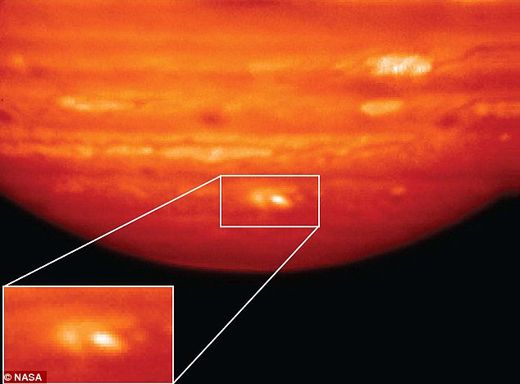
© NASA
Burning
crater: Taken three days after the impact on July 22, 2009, the bright
white and yellow images show the area of collision and indicate hot
temperatures and the presence of hot ammonia upwelling from deep in
Jupiter's atmosphere
Burning
crater: Taken three days after the impact on July 22, 2009, the bright
white and yellow images show the area of collision and indicate hot
temperatures and the presence of hot ammonia upwelling from deep in
Jupiter's atmosphere
Scientists computed the set of possible orbits that would bring an
object into Jupiter in the right range of times and at the right
locations. Then they searched the catalog of known asteroids and comets
to find the kinds of objects in these orbits. An object named 2005 TS100
- which is probably an asteroid but could be an extinct comet - was
one of the closest matches. Although this object was not the actual
impactor, it has a very chaotic orbit and made several very close
approaches to Jupiter in computer models, demonstrating that an asteroid
could have hurtled into Jupiter.
"We weren't expecting to find that an asteroid was the likely culprit in
this impact, but we've now learned Jupiter is getting hit by a
diversity of objects," said Paul Chodas, a scientist at NASA's
Near-Earth Object Program Office at JPL. " Asteroid impacts on Jupiter
were thought to be quite rare compared to impacts from the so-called
'Jupiter-family comets,' but now it seems there may be a significant
population of asteroids in this category."
Scientists are still working to figure out what that frequency at
Jupiter is, but asteroids of this size hit Earth about once every
100,000 years. The next steps in this investigation will be to use
detailed simulations of the impact to refine the size and properties of
the impactor, and to continue to use imaging at infrared, as well as
visible wavelengths, to search for debris from future impacts of this
size or smaller.
JPL is managed for NASA by the California Institute of Technology in Pasadena.
Germany: Bolide Sighting Near Geislingen January 8th
Wed, 26 Jan 2011 18:55 CST
Asteroid Chippings
A report of an effort to find the extra-terrestrial visitor, by members of the German Meteorite Forum.
On
Jan. 8th, 2011, at 17:51h local time, a bolide stroke across the
evening sky in southern Germany. The bolide was witnessed by many, and
captured by at least two cameras in Switzerland and Austria. Also
roaring sounds and thunder were reported. Especially the reports of
sound being heard made (potential) meteorite hunter hearts beat
faster...
One of the two known photographs of the bolide was made in Switzerland
by one of Mark Vornhusen's meteor-camera-network cameras. Being a member
of the German Meteorite Forum, Mark posted his photo on the Forum, and
soon after other reports were shared, including a beautiful second
photograph, made by Hermann Koberger in Fornach (Austria).
As both photographs captured the bolide at angles almost perpendicular
to each other, this yielded a perfect opportunity to determine the
location of the track across the sky, and it's projection on the earth's
surface. The exact location of both cameras was known, and because
stars were visible in both photographs, combined with the know time of
exposure, directions could be determined fairly precise. Track ends in
both photos could be calculated at about the same high above the earth's
surface (28 km). Track beginnings showed a difference. The Swiss photo
seemed to have captured the bolide somewhat earlier in its flight. This
could be explained by the larger distance to the track in the Austrian
photo, and the lower sensitivity of this camera. The Austrian track was
extrapolated to the Swiss photo's high at the beginning.
From the two photographs, Mark Vornhusen calculated the location of the
bolide's start and end point and their highs above the earth's surface.
He also collected wind speed information for different highs, and came
up with a first prediction of a possible fall area. It was situated near
the German city Geislingen an der Steige.
Forum members became excited about the idea to go out, and try to find meteorites that might have reached the ground.
With a calculated bolide end high of 28 km (17.4 miles), there was expected to be little chance of material being found however.
On the other hand, this looked to be an ideal opportunity to meet fellow
Forum members, and have a great time "talking meteorite" with the equal
minded.
A video of the bolide can be found here (2MB) (c) Mark Vornhusen.
Wind data showed that the wind had been blowing almost exactly in the
direction of the track. Many variables were still unknown, and had to
estimated. Fourteen Forum members agreed to meet on Friday evening, the
weekend after the Bolide sighting. Mark produced his final estimate for
the strewn field shown below, and the hunt was on!
The
day of the bolide, the possible fall area had been covered with snow.
Thaw removed the snow the week after, and conditions were ideal for a
hunt. Grass and leaves in the mostly farm land covered area were
flattened by the snow, and possible meteorites could be expected lying
on top of this flattened surface.
When
we arrived at the hotel, we appeared to have booked about the whole
hotel! The bolide appeared to have boosted tourism. Next to our team,
also others were active in the area.
For
instance "team Svend Buhl", a French team and solo hunter Thomas Grau. I
counted people from five different European countries, and from all
over Germany. A local newspaper posted an article about the tourism
boost.
We had planned a first meeting for Friday evening at 22:00h.
In the hotel we had a room for ourselves, that was used for discussions
and planning. The ones who arrived late were having their diner
simultaneously.
Although most Forum members had never met, it was as if we had known each other for years. Great camaraderie!
Forum
member Martin had coordinated the preparations in the days before the
trip. Hanno provided a large detailed map, three teams were formed and
search areas were agreed upon.
The aim for the next day was to search the beginning, the mid and the end of Mark's predicted strewn field.
We had a lot of meteorite talks, laughs, beer, and it was much too late when I finally went to bed...
The
next day, a quick group photo in front of the hotel, and off we went to
the fields. We arrived in farmland with endless meadows.
More pictures of the field trip can be viewed here.
US: 'Boom' Heard Across SE Part of Metro
Thu, 27 Jan 2011 11:35 CST
Koco.com
Oklahoma City - A loud 'boom' was heard by Oklahomans on Thursday
morning, but officials confirmed that it was not an earthquake.
Eyewitness News 5 began reporting a possible earthquake around 10:30
a.m. The United States Geological Survey said no such earthquake had
occurred.
The last earthquake in Oklahoma was at 9:53 a.m. on Jan. 19. It was a magnitude of 2.8, according to the USGS.
Eyewitness News 5 will update this story as more details become available.
Another Fireball in Irish Skies
Fri, 28 Jan 2011 07:10 CST
RTÉ News
A fireball has blazed across Irish skies for the second time in ten days.
Astronomy Ireland says a piece of an asteroid or comet entered the
Earth's atmosphere over Ireland and blew apart between 6am and 7am.
The organisation says it has already received a number of reports of the
event and is appealing to the public to report any sightings here.
'Large fireballs can explode with the power of an atomic bomb when they
burst tens of kilometres above our heads,' said David Moore, Chairman of
Astronomy Ireland.
'Fragments that survive the fall to the ground can fetch a keen
meteorite hunter hundreds - if not thousands - of Euro, if sold'.
Astronomy Ireland says a fireball also appeared in the moonlit sky on 18 January.
Threat of Near-Earth Asteroid Prompts Deflection Theory
A
New York professor has an idea that may help to deflect any asteroid
that is on a head-on collision with Earth. He is testing his idea, which
includes a solar sail, sunlight, and a warmed up asteroid, with the
help of NASA.
Dr. Gregory L. Matloff is an associate professor of physics at New York City College of Technology (City Tech).
He is working with NASA on an idea of heating up an asteroid with the
use of a solar sail (which produces a concentrated stream of sunlight)
so that a jet stream could be created on the asteroid to alter its
course away from Earth.
Earth is always in jeopardy of being hit by an asteroid and other space
objects. Small ones - meteorites - hit Earth all of the time and
still smaller ones - meteors - enter Earth's atmosphere but burn up
before reaching the ground. However, larger ones still out in space -
meteoroids and even larger ones called asteroids -- are of concern to
astronomers because of their potential to do great harm to our planet if
they should collide with us.
Some of them are of greater concern to these asteroid trackers
because they travel close to Earth. They are called Near-Earth Objects
(NEOs) - those meteoroids and asteroids that travel less than 120
million miles (195 million kilometers) from Earth on their orbits about
the Sun.
Thus, they are traveling about 1.3 astronomical units (AU) or less from
Earth. One AU is the average distance that Earth and Sun are apart,
which is around 93 million miles (150 million kilometers).
According to the January 26, 2011 City University of New York (CUNY) article "City Tech Research Team Casts Light on Asteroid Deflection,"
the team headed by Dr. Matloff is working on analysis of what would
happen if, for example, a 25-million-ton NEO, traveling at 30,000 to
40,000 miles per hour, was heading straight toward Earth and it could
somehow be diverted by a concentrated beam of sunlight.
Sound impossible? It's not!
The January 25, 2011 iTWire article "Surprise! NanoSail-D solar sail does its thing!" talks about the NanoSail-D spacecraft, which recently deployed its solar sail out in space.
Such a spacecraft is being tested to help remove space junk from orbit
about Earth. The NanoSail-D has a 100-square-foot (9.2-square-meter)
sail -- made of a thin polymer sheet of reflective material -- that
unfurls. It could be used to add extra atmospheric drag on old
satellites in orbit, so that they de-orbit faster. And, thus, less junk
in space.
However, such a solar sail could also be used to divert asteroids and large meteoroids from a head-on collision with Earth.
Dr. Matloff explains the problem with NEOs: "A collision with an object
of this size traveling at an estimated 30,000 to 40,000 mile per hour
would be catastrophic. He says two options are available: "Either
destroy the object or alter its trajectory."
Matloff suggests the latter: tweak its direction so it goes harmlessly past Earth.
The City Tech article states, "Dr. Matloff, whose research
includes the best means to avert such a disaster, believes that
diverting such objects is the wisest course of action. In 2029 and 2036,
the asteroid Apophis (named after the Egyptian god of darkness and the
void), at least 1,100 feet in diameter, 90 stories tall, and weighing an
estimated 25 million tons, will make two close passes by Earth at a
distance of about 22,600 miles."
Check out some of the research performed by NASA on these possible-but-unlikely collision scenarios between Apophis and Earth at: "Predicting Apophis' Earth Encounters in 2029 and 2036."
Matloff states, "We don't always know this far ahead of time that they're coming, but an Apophis impact is very unlikely."
Such a collision with Apophis (officially: 99942 Apophis) would produce
gigantic force that could be tens of thousands of times more powerful
than an atomic bomb.
If we try to explode such an object before it gets to Earth, the
radioactive debris that result from the explosion could be a danger to
Earth.
Instead, Dr. Matloff suggests that such NEOs could be diverted from their trajectory by heating its surface with a solar sail.
A solar-sail probe could be positioned near to the NEO, and its solar
sail would concentrate the rays of the Sun onto the object (like a
magnifying glass can focus the Sun's rays on a hot summer day) in such a
way that the heat generated inside the asteroid would eventually create
a jet stream.
And, that jet stream would alter the direction of the asteroid, and
force it onto a path around Earth, rather than straight into the planet.
Just like a rocket is powered upward off its launch pad by the force of
its propellants in the opposite direction (Newton #3: equal action and
reaction), such a jet stream would force the NEO onto another slightly
altered course, one away from Earth.
Currently, Dr. Matloff is working with NASA with ways to deflect such NEOs. The City Tech
article states, "The team theorized that a solar collector (SC), which
is a two-sail solar sail configured to perform as a concentrator of
sunlight, could do the trick. Constructed of sheets of reflective metal
less than one-tenth the thickness of a human hair, an SC traveling
alongside an NEO for a year would concentrate the sun's rays on the
asteroid, burn off part of the surface, and create the jet stream."
And, right now they are working on the specifics of such a mission, such
as how much sunlight is needed to produce the desired result.
Matloff explains, "A beam that penetrates too deeply would simply heat
an asteroid, but a beam that penetrates just the right amount -
perhaps about a tenth of a millimeter - would create a steerable jet
and achieve the purpose of deflecting the asteroid."
And, "For the past year, Dr. Matloff and a team of City Tech scientists
have been experimenting with red and green lasers to see how deeply they
penetrate asteroidal rock, using solid and powdered (regolith) samples
from the Allende meteorite that fell in Chihuahua, Mexico in 1969."
Is this unique research? Dr. Matloff says, "To my knowledge this is the
first experimental measurement of the optical transmission of asteroid
samples."
The article also states that the United States and Russia -- their two
space agencies, NASA and Roscosmos, respectively - are studying the
Apophis asteroid because of its close encounter with Earth in 2029 and
2036.
Matloff comments on this rivalry, "At present a debate is underway
between American and Russian space agencies regarding Apophis. The
Russians believe that we should schedule a mission to this object
probably before the first bypass because Earth-produced gravitational
effects during that initial pass could conceivably alter the trajectory
and properties of the object. On the other hand, Americans generally
believe that while an Apophis impact is very unlikely on either pass, we
should conduct experiments on an asteroid that runs no risk of ever
threatening our home planet."
Check out the Wikipedia webpage "99942 Apophis"
for a list of articles describing Apophis and the work being done to
study the possibility of Apophis hitting Earth in 2029 and 2036.
US: Woman Films Object Shooting Across Sky
Susan Stacy knows what a plane looks like when it streaks across the
Gulf of Mexico at sunset. But she has no idea what she captured on video
from her front porch in Terramar Beach on the island's West End last
month and again Friday night.
Watch the video below and tell us what you think? Plane, meteor or UFO?
US: Meteor Sighting Reported Over Cambridge
Mon, 31 Jan 2011 10:47 CST
The Boston Channel
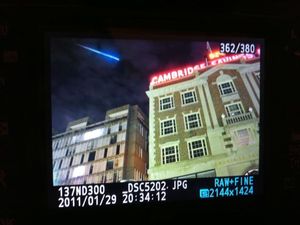
© Brad Kelly / Wicked Local
A Somerville photographer captured a photo of an apparent meteor streaking across the sky over Harvard Square Saturday night.
A Somerville photographer captured a photo of an apparent meteor streaking across the sky over Harvard Square Saturday night.
Cambridge,
Massachusetts -- A Somerville photographer captured a photo of what he
believes was a meteor streaking across the sky over Harvard Square
Saturday night, our news partner Wicked Local/Cambridge reported.
Brad Kelly said he was late for a movie he wanted to see, so he ended up
walking around Harvard Square, snapping photos to pass the time.
At around 8:30 p.m., he said he found himself in front of the Cambridge
Savings Bank building, and that's when he captured the picture.
Massachusetts residents in Worcester, Beverly, Newburyport and
Marblehead also reported seeing what they believe was a meteor.
"It was a bright white fireball, about as big as the tip of your pinkie
at arms length. The red tail turned to green and it dissipated," wrote a
woman on a blog that tracks meteor sightings.
Apocalypse Forever: The Root of Islam Was a Very Dark Year
Human
history is a mosaic of economics, scientific progress, individual
initiative, and random chance. The world goes to war because one man is
assassinated. Kingdoms change hands because someone invented a longer
spear or a faster arrow. But the environment has long been overlooked as
an influence on history. Human interaction with the environment,
instead, has been the domain of anthropologists studying
hunter-gatherers. Yet, rather than our usual supernatural history with
prophetic explanations, history can be explained logically in natural
terms. The environment not only plays a role in our history, but it is
also a crucial role.
Most of us learned in school that the Dark Ages began in the vacuum left
by the Roman Empire, whose fall resulted from over-reaching ambition,
corruption, and human frailty. Comparatively few records remain from
that time, especially from the sixth-century, which is considered both
the low point and the official beginning of the Dark Ages.
It's not until recently that some scholars have begun to think something
very unusual happened around that time, that perhaps the apocalyptic
writings of sixth century historians are pointing to something more
concrete than political and economic hardship. Their most important clue
came not from musty old libraries, but from the forests.
Trees live a very long time, their memories are accurate, and
they hold a grudge forever. Deprive them of good sunlight for a season
and they'll complain about it hundreds of years later. And the trees, it
turns out, have much to complain about.
Andrew Douglass, an astronomer, pioneered the science of
dendrochronology. He was trying to pin down cyclic variations in solar
output in Arizona in the 1920s. Assuming that Arizona received equal
days of sunshine each year, Douglass identified two sources of variation
in the size of annual growth rings in pine trees: yearly rainfall and
ten-yearlong solar cycles. (We now know these as eleven-year sun spot
cycles, but, by chance, Douglass made his observation at a time when the
cycles were shorter.) He began constructing a chronology of Arizona
pine tree rings back to the year 1700. Then he stretched it further
using timbers and other pieces of wood from archeological sites. By
repetition and overlap with older trees, Douglass was able to build a
continuous record to AD 1284.
Trees respond to anomalous growth conditions in different ways,
depending on their region and their species. A cold year, or one that's
poor in rainfall, might yield a noticeably narrow ring, or even a
microscopic one. A year with a hard, early frost after a relatively
normal summer would have rings of normal size, but with damage at the
cellular level. Some trees, which thrive in cold conditions, might have
an unusually wide, robust growth ring in a year thought to be a nearly
total loss by other species of trees. And in a spectacularly bad year,
many trees will skip a ring altogether, and not have a growth ring at
all, even at the microscopic level.
Patterns of good and bad years in trees are distinctive, and unique
sequences, called signature sequences by Andrew Douglass, are what makes
it possible to match ring patterns in different trees. These patterns
of highs and lows hint at what the growing conditions were like for a
particular tree in a particular region.
Although of interest originally to astronomers, dendrochronology became
popular with archeologists. Other trees began giving up their secrets,
always reaching further into the past. The giant sequoia of California,
which can live two thousand years, yielded information on prehistoric
droughts and fires. And in the 1950s, Edmund Schulman began to study the
world's longest-lived tree, the bristlecone pine. Found in the Nevada
mountains, the bristlecone pine is a stunted specimen looking more like a
piece of standing driftwood than a living organism, but it can live
five thousand years! The sum data from living and dead bristlecone pines
provides scientists with an eight-thousand-year-long record of regional
weather conditions.
European scientists had no such longlived trees to work with. Instead,
Germany's Bruno Huber in 1930 embarked on a grueling 30-year mission to
construct an oak chronology. Oaks live only a few hundred years, but
Huber had access to a rich supply of historical buildings made with oak
timbers. Once again, by overlapping the dead timbers with living trees,
and then laying over these even older timbers, a one-thousand-year
record was constructed.
Dendrochronologists chart the ring sizes, then compare the charts,
correlating distinctive patterns. Andrew Douglass was so adept that he
could date a piece of wood without referencing his charts, by eyeballing
the signature sequences. But a chronology constructed with thousands of
trees, such as Huber's oak chronology, can overwhelm even the most
knowledgeable scientist. In the 1960s, computers accelerated the
process, stretching the German oak chronologies back to nine thousand
years ago by running correlation programs on data from thousands of
trees, and checking the similarity of patterns at every possible point
of overlap. Using Huber's manual methods, it would have taken another
two hundred forty years to complete this chronology.
Other scientists, working independently in Ireland and England, were
able to build their own chronologies based on oaks which synchronized
perfectly with the German oaks back to the exact year 5000 BC.
Thus, current tree ring records are replicated at three levels. First,
there is replication between multiple trees at one site. The second
level is replication between sites. And the third level of replication
is between chronologies constructed by different workers. The margin of
error is zero years. This redundancy in the tree records is so complete,
and the record is so accurate, that it has become the standard against
which radiocarbon dates are calibrated.
As a source of environmental information, tree ring chronologies have
also correlated highly with other records. For example, the European oak
master chronology contains a dramatic growth reduction event in AD
1740-1741. This coincides with a temperature reduction recorded in
Manley's Central England temperature record, which extends all the way
back to AD 1659. A hard freeze set in in 1739, precipitating a famine
and the death of three hundred thousand people in Ireland. Observers in
England and Ireland recorded unprecedented cold that winter, with water
freezing in mid-air as it was poured into a glass, and Ireland's Lough
Neagh frozen across its twenty mile surface. The Irish bog oak
chronology independently identified 1739 as an extraordinarily cold
year.
Occasionally environmental conditions are so stupendously bad that it's
noticed by trees all over the world. As these very long, and very broad
master chronologies evolved, certain dates in history began to stand out
as being distinctly unusual. As described in Exodus to Arthur: Catastrophic Encounters with Comets, by Mike Baillie, those dates are: 3195 BC, 2354 BC, 1628 BC, 1159 BC, 207 BC, 44 BC, and 540 AD.
Of these seven dates, 540 AD stands out as the most accessible,
the best documented, and the most severe. The episode had a double
minimum, beginning in 536 AD and plunging further yet to another event
piggybacked on at 540 AD. Until recently, historians had little notion
that this dramatic climatic event had occurred. The accounts left by
contemporary observers were poorly understood and overshadowed by later
historical events. In fact, those later events, it turns out, may have
been caused, directly or indirectly, by the weather of AD 536. The Dark
Ages actually were dark.
The Praetorian Prefect Magnus Aurelius Cassiodorus Senator wrote a
letter documenting the conditions. "All of us are observing, as it were,
a blue coloured sun; we marvel at bodies which cast no mid-day shadow,
and at that strength of intensest heat reaching extreme and dull
tepidity ... So we have had a winter without storms, spring without
mildness, summer without heat ... The seasons have changed by failing to
change; and what used to be achieved by mingled rains cannot be gained
from dryness only."
Another historian, Procopius of Caesarea, a Byzantine, wrote, "And it
came about during this year that a most dread portent took place. For
the sun gave forth its light without brightness, like the moon, during
the whole year, and it seemed exceedingly like the sun in eclipse, for
the beams it shed were not clear nor such as it is accustomed to shed."
John of Ephesus, a cleric and a historian, wrote, "The sun was dark and
its darkness lasted for eighteen months; each day it shone for about
four hours; and still this light was only a feeble shadow ... the fruits
did not ripen and the wine tasted like sour grapes."
In the wake of this inexplicable darkness, crops failed and famine
struck. Out of Africa, a new disease swept across the entire continent
of Eurasia: bubonic plague. It ravaged Europe over the course of the
next century, reducing the population of the Roman empire by a third,
killing four-fifths of the citizens of Constantinople, reaching as far
East as China and as far Northwest as Great Britain. John of Ephesus
documented the plague's progress in AD 541-542 in Constantinople, where
city officials gave up trying to count the dead after two hundred thirty
thousand: "The city stank with corpses as there were neither litters
nor diggers, and corpses were heaped up in the streets ... It might
happen that [a person] went out to market to buy necessities and while
he was standing and talking or counting his change, suddenly the end
would overcome the buyer here and the seller there, the merchandise
remaining in the middle with the payment for it, without there being
either buyer or seller to pick it up."
Taken in the context of hard scientific evidence for a climatic event in
AD 536 (and after), these accounts sound utterly clear and unambiguous.
Three men, in three different locations, are recording environmental
phenomena such as dry fog, darkness, cold, drought, and famine. And the
records are in no way limited to these writers, nor even to these
regions.
The question remains, then, why is it so little known in our own time? A
partial answer lies in looking at these historical writings from a
regional perspective, since history is generally studied one nation,
empire, or continent at a time, rather than in cross section across the
entire planet. Additionally, without a scientific explanation for the
phenomenon, the imagination fails. What could cause eighteen
months of darkness? It's much easier to believe that Cassiodorus
Senator, Procopius, John of Ephesus, and the others were indulging in
hyperbole, and possibly even speaking metaphorically, than to face the
challenge of solving such a mystery, and possibly exposing oneself to
ridicule. It's far easier to cook up and/or except a supernatural story.
Lastly, our society has a certain myopia regarding climate changes.
Human beings are not good at understanding worldwide weather patterns on
a geologic time scale, and tend to assume that the weather we
experience during our lifetimes is the weather that is completely normal
for the planet at all times. And when climate change does occur, we are
only too happy to take the credit for it (or the blame). It is
uncomfortable and uncharacteristic for human beings to accept that
something beyond our control could take away the seasons, the rain, and
the Sun. Thus, even in the face of incontrovertible evidence that
something happened in AD 536, and the fact that we have had this
information in our libraries for the past millennium and a half, we
still don't know about it. We deny it.
Having established that an event definitely did occur in AD 536, it
remains to determine what type of event it was. The first theory,
proposed by Val LaMarche and Tom Harlan, based on the testimony of
California bristlecone pines, was that the periodic temperature minimums
recorded by tree rings were caused by volcanic eruptions. A
sufficiently large volcanic eruption could theoretically inject debris
into the stratosphere, spreading it across the globe. The resulting
"veil," composed of dust, droplets of sulfuric acid, and ice crystals,
could have caused the effects noted by Senator, Procopius, and John of
Ephesus. The magnitude of the eruption would have to be stupendous, much
greater than Krakatoa or Pinatubo or any other eruption recorded in
modern times. The presence of frost rings in the bristlecone pines,
indicating a normal growing season interrupted by a sudden hard frost,
supports this hypothesis.
One of the most reliable sources of information about prehistoric
volcanic eruptions lies in the ice layers of Greenland. Ice forms layers
corresponding to calendar years that can be read in much the same way
as tree rings, by means of cores drilled deep into the ice. Volcanic
eruptions exist in the ice layers as sulfuric acid. Unfortunately, an
ice core chronology is much less accurate than a tree ring chronology,
and not subject to replication in the same way as tree rings.
Candidates for ancient volcanoes sufficient to shut down sunlight
worldwide are scarce. One such was Santorini, a volcano that blew apart a
sizable island in the Aegean. Ice cores showed a significant acid layer
at 1390 +/- 50 BC that was tantalizingly close to the accepted date of
c. 1500 BC for the Santorini eruption given by Egyptologists.
Unfortunately, dendrochronologists had pinned 1628 BC exactly as the
target date for the Santorini eruption. This debate raged for several
years until 1987, when new data showing an acid layer at 1645 +/- 20 BC
was published. However, this new information led not to consensus, but
more debate, as the ice core camp refused to acknowledge that their date
was the same as the dendrochronologists' 1628 BC date and the
Egyptologists refused to consider variations from their accepted
historical chronologies.
However, much of this argument is being challenged by a new theory of
global catastrophe: extraterrestrial impact. The volcano hypothesis was
never watertight. Vulcanologists cannot accurately date their eruptions,
and even if they could, some scientists doubt that a volcano could
cause such persistent global climate changes. And finally, there is no
sulfuric acid layer in the Greenland ice cores for AD 536.
In 1984, Irish dendrochronologist and paleoecologist Mike
Baillie proposed that the climatic event of AD 536 (and by extension,
all six of the others) could have been caused by "an asteroid, a comet,
cometary fragment(s), or cosmic swarms."
An asteroid is a rock in space. They occasionally enter Earth's
atmosphere, leaving a fiery trail behind them, and become "shooting
stars." Comets contain ice, and thus are sometimes called "dirty
snowballs." They are thought to originate from outside the solar system,
and when they approach the warmth of the Sun, the ice melts and forms
an atmosphere, which gives rise to the comet's tail. Asteroids are much
more common than comets.
Baillie backs up his theory with the work of astrophysicists such as
Victor Clube and Duncan Steel. According to them, odd impacts by
extraterrestrial objects happen fairly frequently, and we should have
been hit by a fairly large object, or a swarm of smaller ones, in the
last five thousand years.
Small extraterrestrial impacts occur frequently. NASA classifies
Near-Earth Objects (NEOs) as "small bodies in the solar system
(asteroids and short-period comets) with orbits that regularly bring
them close to the Earth and which, therefore, are capable someday of
striking our planet." Millions exist between 0.1 km and 1 km in
diameter. There are five hundred million between 10 and 100 m. Each year
there is on average one impact with an object up to 6 m in size, giving
rise to a 15-kiloton explosion. The estimated minimum global
catastrophe threshold is 1 km in diameter. One thousand 1-km NEOs exist.
Baillie's proposal has been greeted with skepticism by historians. In Exodus to Arthur,
he writes, "The ideas of catastrophism and environmental determinism
have been so thoroughly marginalized that it is almost impossible to
have an informed conversation on the topic of bombardment from space.
Yet astrophysicists make a very plausible case that the Earth should
have been affected during the last few millennia ... Even more bizarre,
those same dismissive archaeologists and historians, asked if there have
been collapses of civilizations or population movements in recent
millennia, will happily answer in the affirmative. In the great whodunit
of history, astrophysicists have the 'gun' and
archaeologists/historians have the 'corpse,' but no one suspects a
'shooting.'"
This new information demands a new perspective on history. If we accept
that the Earth has been bombarded many times in the history of
civilization, resulting in a worldwide "nuclear" winter, plague, famine,
loss of population, and the collapse of civilizations, two new
questions surface. First, except in the case of 536 AD, none of these
events are directly recorded. What sorts of indirect accounts and oral
histories survive to tell us of these great apocalypses? And second, how
does a global catastrophe shape history?
Answering the first question requires a reexamination of the 1628 BC "Santorini eruption" event. In Exodus to Arthur,
Baillie postulates a link to the biblical Exodus. Many biblical
passages lend themselves to a catastrophic interpretation. The
Israelites followed a "pillar of cloud by day and fire by night," which
could have literally been Santorini as seen from Egypt. However, other
biblical phenomena don't fit as neatly with the volcano theory. Could it
instead have been a cometary impact, or a close pass of a comet,
resulting in earthquakes, volcanic eruptions, and tsunami as secondary
effects? Again, in light of the date discrepancies (biblical scholars
place the Exodus in the thirteenth century BC) it seems outrageous to
suggest that the whole thing happened four centuries earlier and that it
was really caused by a comet. But if one accepts that something
extraordinary happened in 1628 BC, something noticed by trees all over
the world, then it's not such a stretch to think it might have been
recorded in the story of the Exodus. From the point of view of the
Hebrews of the seventeenth century BC, it must have seemed like the
world was actually ending. They had to have remembered it somehow.
In addition to the Exodus story, Baillie has forged a tenuous link
between the 2354 BC event and the biblical Flood. Based on observations
of the atmospheric explosion of a relatively small (about 40 m across)
object above Tunguska in Siberia in 1908, Baillie speculates that a much
larger impact could have caused worldwide inundations and/or tsunami. A
detail too tantalizing not to mention is that Bishop Usher (best known
for calculating the age of the Earth based on the Bible) dated the
biblical Flood to 2349 BC. Usher's chronologies are now disfavored, and
there may never be a way to definitively link the Flood story with a
comet event, but it's fascinating all the same.
Another well-known mythology that bears a catastrophic interpretation is
the story of King Arthur. Although scholars place the historical King
Arthur in the fifth century, the date of his death is given as AD 539.
Furthermore, much of the imagery from the Arthurian legend fits with the
appearance of a comet and subsequent famine and plague--the "Waste
Land" of so much legend. Ireland's St. Patrick stories feature a
wasteland as well. And although St. Patrick is credited with chasing the
snakes out of Ireland, it's worthwhile to consider that there never
were snakes in Ireland, and that snakes and dragons are common images
associated with comets.
Until the sixth century, the Britons had held control of post-Roman
Britain, keeping the Anglo-Saxons isolated and suppressed. In the wake
left by the Roman empire, the Britons maintained the status quo, living
in towns, with elected officials, and carrying on trade with the empire.
After AD 536, the Britons all but disappeared, and were replaced by
Anglo-Saxons. It's a matter of debate whether the Anglo-Saxons killed
all of the Britons, or assimilated them. But a competing theory is that
the bubonic plague that afflicted the Roman empire wiped them out, and
that the Anglo-Saxons enjoyed relative immunity due to their barbaric
lack of trade or other contact with the civilized world.
Elsewhere, or possibly everywhere, the sixth century proved to be a watershed. David Keys, archeologist and author of Catastrophe: An Investigation into the Origins of the Modern World,
explains that the plague originated in East Africa, where it existed in
fleas which lived on the plague-resistant gerbil. When drought (caused
by a dust-laden atmosphere) killed off the larger predators, the gerbil
was free to expand its range, spreading its plague-infested fleas to the
multimammate mouse, who gave them to the ratlike Arvicanthus, who gave
them to Rattus rattus, a worldly, sophisticated rodent who visited all
of the popular ports of call, carrying the plague fleas with it.
Meanwhile, on the steppes of Asia, which would not be visited by plague
until much later, the climate event of AD 536 caused a political
upheaval. Because of the drought, the horse-based economy of the warlike
Avars foundered, and their vassals, the cattle-herding Turks, overthrew
them. Evicted from their home on the steppes, the Avars loaded up their
tents and marched off, looking for greener pastures. They ended up in
Hungary, and in cahoots with the Slavs, began to chip away at the
borders of the Roman empire.
And in Yemen, in the 540s, a dam broke. By 550 AD, the great Marib Dam,
an engineering marvel of the ancient world, was a complete loss and
thousands of people migrated to another oasis on the Arabian peninsula,
Medina. The Arab tribes, weakened by famine, begin to rouse themselves
and think of conquest. In 610 AD, a new leader unified them--Muhammad.
Although all of the interesting historical changes happened in the
seventh century--the Roman war with Persia, the rise of Islam, rebellion
and civil war in the Roman empire, and the advance of the Slavs driven
by the Avars--all can be legitimately traced to the environmental
catastrophe of 536 AD.
These effects in history's most recent, best documented global
catastrophe have implications for all of human history. There is a
theory in evolutionary biology called punctuated equilibrium which
explains how a species could exist quite stably in the fossil record,
and then suddenly be replaced by another. First proposed by Niles
Eldredge and Steven Jay Gould, the controversial theory has come to gain
wide acceptance. Evolution, it states, is not a slow, gradual,
continuous process, but an uneven one. Long periods of little or no
change are punctuated by periods of rapid, dramatic change. The fast
changes are most likely triggered by extinction events, with new species
expanding to fill the vacuum. The most famous example of this process
is the extinction of the dinosaurs (caused by an asteroid) and the
subsequent rise of mammals.
If evolution on Earth can be punctuated by encounters with large
comets or asteroids, could human history be punctuated by smaller ones?
In each of the examples of tree ring events, new levels of political
organization and new religions arose in the wake of the disaster. Could
much of our prehistory be similarly driven by the trauma of
near-destruction? The development of agriculture? The migration across
the Bering land bridge? Could a comet be the missing element in the
demise of the Neanderthals?
A larger and even more pressing question is what does this mean for the
future? Some experts, among them David Keys, continue to argue for the
volcano theory, postulating a gigantic eruption in 535 AD near Sumatra.
According to Keys, another mega-eruption could be imminent, originating
from any of a number of seething monster calderas, primarily at
Yellowstone, Long Valley (California), Naples, or Papua New Guinea.
Advocates of the comet theory have a similar message, though less
specific. There is no way to predict when the next object will strike
the Earth. NASA and the US Air Force have initiated programs to search
for and track near-earth objects. NASA's Spaceguard
program aims to find 90% of NEOs larger than 1 km (global catastrophe
threshold) within the decade. None of the currently identified NEOs
poses an impact risk to the Earth. However, it is estimated that less
than half of the larger ones are identified, so a major impact could
occur any time without warning.
An impact (or an eruption) on the scale of the AD 536 event would likely
cause a similar or greater level of worldwide chaos. Our politicians
are no more immune to ouster by an angry and capricious populace than
the Romans; and with our substantially larger world population we are,
if anything, even more vulnerable to drought and crop failure. Bubonic
plague still resides in isolated reservoirs, waiting for a chance to
gallop across the globe.
An even greater concern is a much larger extraterrestrial impact, of the
class that destroyed the dinosaurs. It is unlikely that humanity could
survive contact with some of the larger NEOs, and even unlikely that we
would defend ourselves even if we had advance notice of such a
catastrophe. Colonization of other planets is one option for keeping the
species alive, but the one we'll most likely choose, it seems, is no
different than in ancient times, when people responded to disaster by
aspiring to more "righteous" behavior to avoid angering the deities,
which is to say that at this time there is no practical, scientific
solution to this problem.
"Our life is but a new form of the way men have lived from the beginning." --Henry Ward Beecher
kafirakbar@hotmail.com
The Sky Is Falling ... More Than We Thought
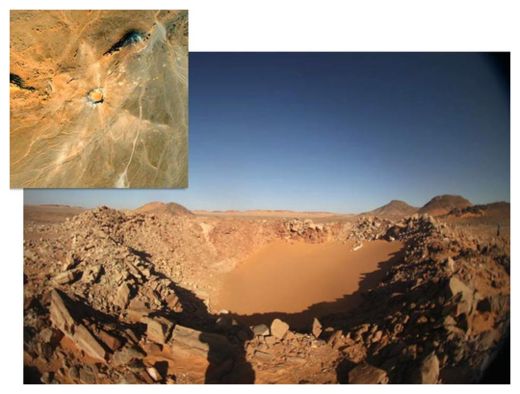
© Museo Nazionale dell'Antartide Università di Siena;(inset) Digital Globe and Telespazio/ESA
Impact!
A field expedition to the 45-meter-wide Kamil crater in Egypt (seen
from space, inset) provides evidence that a substantial fraction of
multiton iron meteorites may survive their fiery plunge through Earth's
atmosphere intact.
Impact!
A field expedition to the 45-meter-wide Kamil crater in Egypt (seen
from space, inset) provides evidence that a substantial fraction of
multiton iron meteorites may survive their fiery plunge through Earth's
atmosphere intact.
Sometime in the past 5000 years, a small iron meteorite slammed into
the southwest corner of Egypt, punching a 45-meter-wide crater into the
rock and sand. A new study suggests that small meteorites like this may
survive their plunge through Earth's atmosphere intact much more often
than previously suspected. And that means these objects could pose a greater danger than once believed.
Although small impact craters are common features on the moon and other
airless bodies in our solar system, they're rare on Earth: Only 15 of
our planet's 176 or so known craters measure less than 300 meters
across. But that rarity doesn't stem from a lack of objects whizzing
through our cosmic neighbourhood. Instead, two other factors are at
play. Many small objects break apart as they plummet through the
atmosphere, either disintegrating entirely or surviving to leave
multiple craters. Also, the craters blasted by those objects that do
reach the ground are quickly masked by erosion or other geological
processes not present on other worlds. But the Egyptian impact is
causing scientists to rethink their notions of how often iron meteorites
fall to Earth in one piece.
The so-called Kamil crater, named for the nearest mountain, was
discovered in autumn 2008 during a low-altitude aerial survey conducted
for Google Earth. A field expedition to the site in February 2009
recovered more than 5000 fragments of nickel-rich iron that together
weighed more than 1.7 metric tons - a sure sign that the meter-deep
crater had been blasted by an iron meteorite. In next month's issue of Geology,
Massimo D'Orazio, a geochemist at the University of Pisa in Italy, and
his colleagues estimate that at impact the meteorite weighed about 9.1
metric tons, which suggests that the object weighed between 20 and 40
metric tons before it entered the atmosphere.
Previous studies of Earth's small craters indicate that objects
weighing less than 3000 metric tons typically break apart to form
multiple craters on impact. As of a decade ago, only three of the 12
iron meteorites in that class had survived their fiery fall to make a
single crater. But the Kamil finding, along with a little-studied crater
in Alberta, Canada, that was also formed by the impact of a small iron
meteorite, boosts the proportion of such objects that struck Earth
intact from one-fourth to more than one-third.
The apparent rise in survival rates may be due simply to having a larger
sample size that better represents the objects slamming into the
planet, says Philip Bland, a planetary scientist at Imperial College
London. "The more of these craters we find, the better our statistical
model of meteorite survival can be," he notes.
Whether an object survives its plunge through the atmosphere depends on
its material properties and its history, Bland adds. Objects that have
suffered repeated collisions in space may be highly fractured and
readily break up during their plunge to Earth, whereas those made of a
relatively intact mass of fine-grained iron would have a better chance
of landing in one piece.
As is often portrayed in movies such as Armageddon, an
extraterrestrial object that strikes Earth in one piece does more damage
than one that lands in several smaller fragments. Thus, the new
findings suggest that earthlings may face somewhat more danger from
meteorites than previously recognized.
'Cometa Aster': Once a myth, now an object of study
The
comet, which moves in an elliptical orbit around the Sun, will at
rendezvous be some 675 million kilometres from the Sun, near the point
in its orbit farthest from the Sun. The meeting point was not chosen at
random: at this point the comet is still barely active, it is still in
fact a frozen lump of ice and interplanetary dust, in all probability
the matter from which our solar system emerged four and a half billion
years ago. Rosetta's job is to find out more about these strange bodies
that travel through our solar system. As it moves on, the comet will
begin to change. As it approaches the Sun, it will - like all comets -
become active: in the warmth of the Sun's rays, the ices evaporate,
tearing small dust particles from the surface. This produces the comet
head (the coma) and tail during solar flyby skims several metres of
matter off the comet's surface. In the case of a small comet like
Churyumov-Gerasimenko, the shrinkage is a good 1% each time round." As
it flies past the Sun every 6.6 years it can look forward to a short
future, especially on a cosmic timescale.
Comets - a mystical view
Visible cometary phenomena have fascinated human beings from time
immemorial - and frightened them too. Even today mystical explanations
prevail among some of the Earth's peoples. The Andaman islanders, a
primitive people living in the Gulf of Bengal, see comets as burning
torches hurled into the air by forest spirits - the more easily to
detect humans foolish enough to stay out at night. For some Australian
aborigines, comets are flaming sticks ridden by mighty shamans.
Efforts to provide a scientific explanation of the 'cometa aster'
('hairy star') phenomenon stretch back to ancient times. A widely held
view was that comets were in some way connected with processes at work
in the atmosphere. In Meteorologica, Aristotle (384-322 BC) described
how inflammable gases escape from clefts in rocks, collect in the upper
layers of the sub-lunar world ('world under the Moon') and ignite. Rapid
release of such gases produced a shooting star; when let out slowly,
they gave rise to a comet. That was Aristotle's best shot - and he was
well aware of his limited insight into the question. As he himself
acknowledged: "As we have no demonstrable basis for assertions about
comets, I have to settle for an interpretation that does not conflict
with established truths." Admittedly such truths were thin on the ground
at the time.
Comets - something of a disaster
As the centuries unfolded, what could be called the opposite view - that
the comets were responsible for intense heat spells - also gained a
considerable audience, though there was just as little truth in it. The
natural philosophers went one further. They said comets lead to heat,
heat to storms and storms to natural disasters. Pliny the Elder for
example (born circa 23 AD) listed twelve cometary phenomena according to
their external appearances. And he assigned one natural disaster to
each class.
The Christian Middle Ages no longer saw cometary phenomena as the blind
raging of an even blinder nature, preferring to interpret them as signs
from God. Theologians such as Saint Hildegard of Bingen (1098-1179) and
Albert Magnus (1200-1280) cited holy scripture. The Book of Jeremiah for
example (1:11,12), in which God caused a fearsome "rod of an almond
tree" to appear in the sky, a symbol of the prophet's empowerment. Or
again Luke 21:11: "And great earthquakes shall be in divers places, and
famines, and pestilences; and fearful sights and great signs shall there
be from heaven."
In 1066, Halley's Comet appeared to many as a harbinger of the Norman
conquest of Britain, so vividly portrayed in the Bayeux tapestry, with
its scenes from the Battle of Hastings.
The decisive step towards overturning the view that comets are
atmospheric phenomena was taken in 1577 by Danish astronomer, Tycho
Brahe. For two and a half months he observed from his observatory in
Uranienburg the progress of a comet across the heavens. Relying on the
phenomenon of the daily parallax - an apparent "shuddering" motion of
heavenly bodies in fact attributable to the observer's position on the
revolving Earth - he was able to establish that the comet had to be
located beyond the lunar orbit.
Halley discovers an elliptical orbit
The scientific description of comets took another major step forward in
1705 thanks to the work of the British astronomer and physicist, Edmond
Halley, a friend and patron of Isaac Newton. Investigating recorded
comet measurements, he observed that the orbits of a number of bright
comets were very similar: his own calculation of the orbit of a comet
observed in 1682 coincided with the data recorded by Johannes Kepler in
1607 and by Apianus in 1531. He concluded that various comet
observations were attributable to one and the same comet.
Halley was proved right when in December 1758, the comet whose return he
had predicted, thenceforth named after him, did indeed make a repeat
appearance. This confirmed his theory that apparently parabolic comet
orbits were in fact "simply" sections of one enormous elliptical orbit.
Since then observations recorded in China in 240 BC have been identified
as relating to a sighting of Halley's comet, the oldest known document
dealing with this phenomenon.
What was described in the Bible as a sign from God was seen by Fred
Hoyle, the British astrophysicist, as a possible explanation for the
great hiatal breaks in history. He took the view that such extraordinary
developments as the extinction of the mammoth were attributable to
strikes by comet fragments. His views incorporated the theory advanced
by British astronomers Victor Clube and Bill Napier in 1982 that a giant
comet was trapped by our solar system 15000 years ago. With the return
of that comet every 1600 years, the accompanying debris - so the
argument goes - prompted some of the world's great turning points. This
might also be an explanation for such legends as the Flood.
A lump of icy sludge
So what does the actual nucleus of a comet look like? One answer was
supplied by the Giotto space probe in a mission masterminded by ESA. The
probe was named after the major Italian painter Giotto di Bondone, who,
in the early 14th century, portrayed a comet in his fresco in the
Scrovegni Chapel in Padua. On 14 March 1986, the probe succeeded in
taking 100-metre-resolution pictures of the nucleus of Halley's Comet
from only 600 kilometres away. In the words of Uwe Keller: "The mission
forced us to revisit our long-standing image of a comet nucleus as a
'dirty snowball'. The pictures showed that it was more like a lump of
icy sludge. The solid part of the nucleus is much larger than the icy
part."
Bur hardly had Giotto trained its electronic eye on the heavenly body
than the photo opportunity was already over; a dust particle measuring
about a millimetre hit the probe. As the velocity differential between
probe and comet was at that point 68.4 km per second, the force of the
involuntary encounter was enough to put paid to any further snapshots.
All the same, despite the damage to the camera, it proved possible to go
on with the mission. Following two periods of "hibernation", Giotto
achieved a successful flyby of the Grigg-Skjellerup comet on 10 July
1992.
Rosetta should now bring us entirely new knowledge about comet nuclei.
It will orbit the comet and deposit a small lander probe on its surface.
So for the first time in history a comet travelling sunwards will be
investigated from close quarters.
***
For further information on Rosetta go here.
For more on ESA Science missions go here.
Comment: Astrophysicist James McCanney has, for
several decades now, been attempting to inform (and warn) anyone who
will listen about the true nature of our solar system and the way in
which the planets and the sun (and any stray bodies that enter our solar
system) interact with each other. Basically, McCanney makes the case
for an 'electrical' interaction between the planets, with the sun as a
massive electrical 'storehouse' that can be 'discharged' by new
celestial bodies entering the solar system. To put it even more
basically: large cometary bodies that do 'fly-bys' of the earth can,
depending on the alignment of the earth, sun, the 'new-comer' and any
number of the other planets, charge our ionosphere and cause serious
'electrical' disruption of the earth environment, including an ultimate
reversal of the earth's magnetic pole.
For a more detailed analysis of McCanney's theories see the following two articles:
Comet Elenin is Coming!
Pole Shift? Look to the Skies!

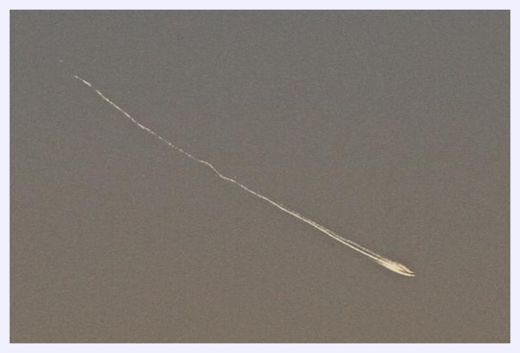
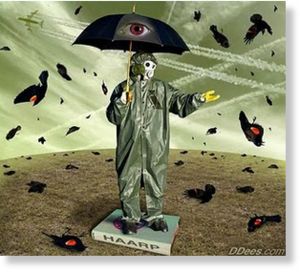




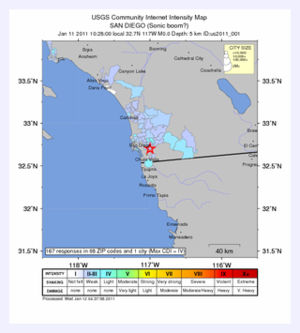
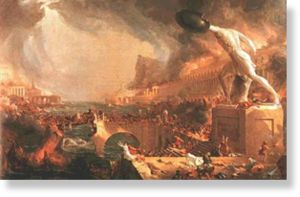
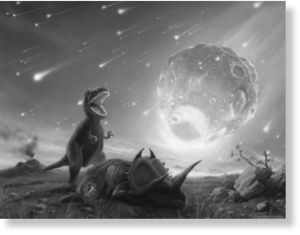
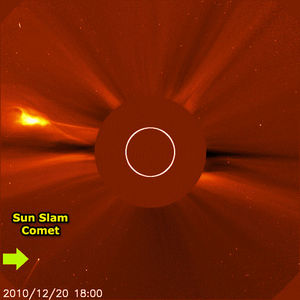
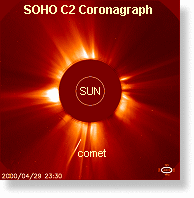
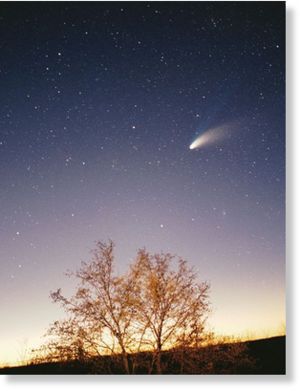
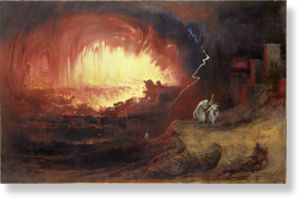
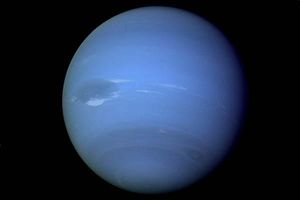
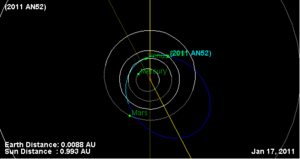
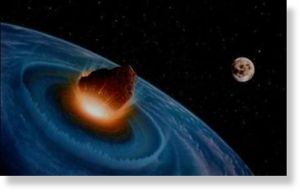
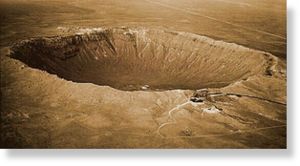
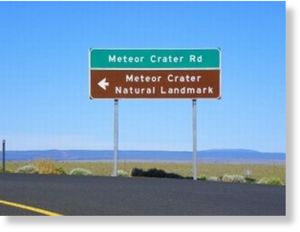
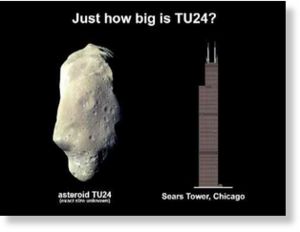
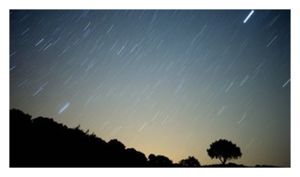

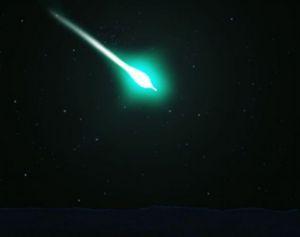
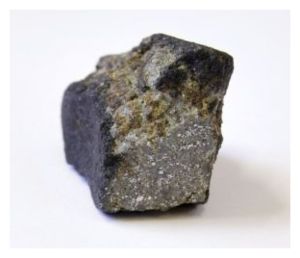
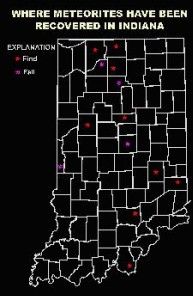
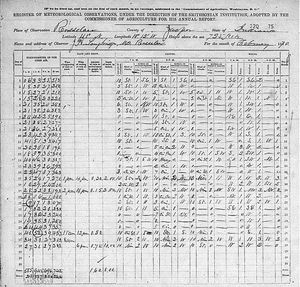
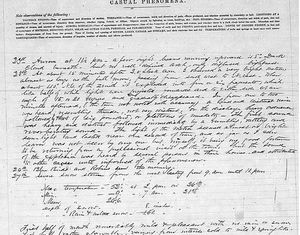
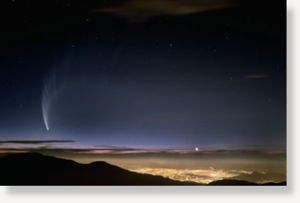

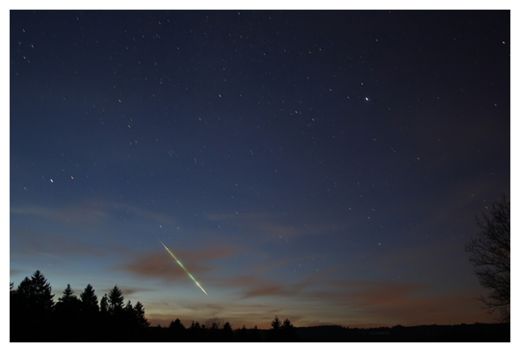
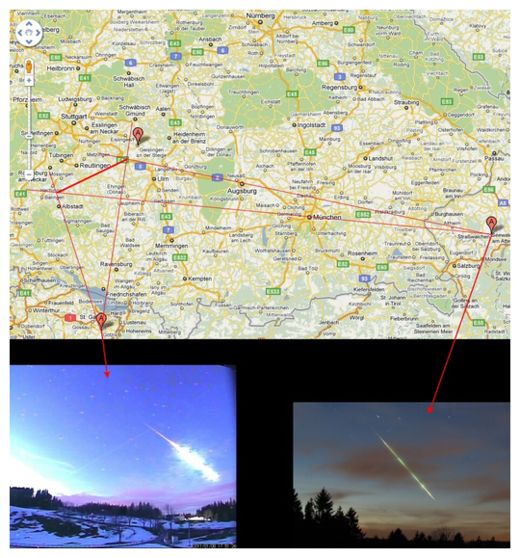
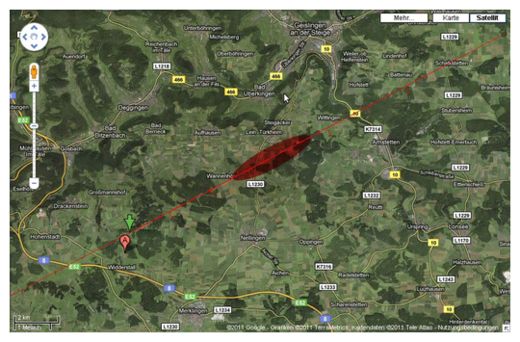


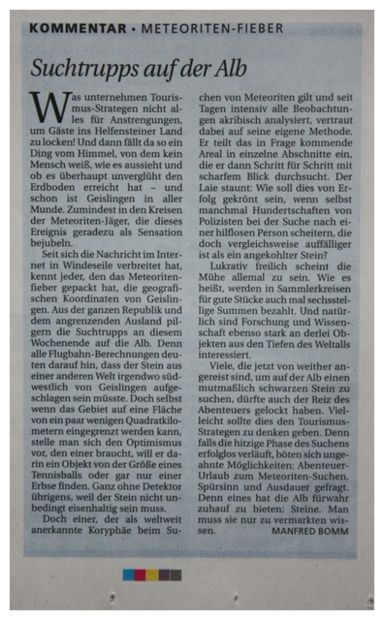

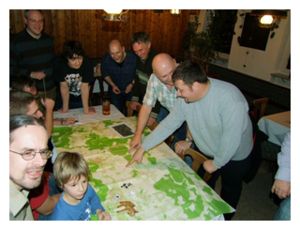

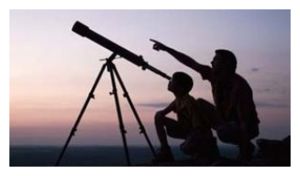
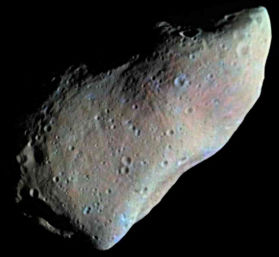
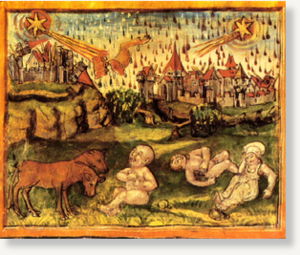

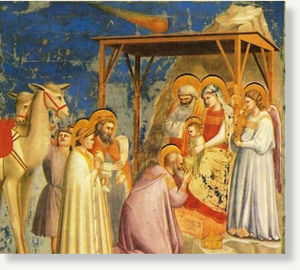
2 comments:
Around 8:50 pm in northeast mississippi I saw an object falling from the sky..it was a white streak then turned into what looked like a fireball..and lite up the sky..anyone know what this was?
Hi Joseph,
It was a meteorite, all right. Take a look here: http://www.clarionledger.com/article/20110113/NEWS/101130344/Scientists-Bright-flash-of-light-in-sky-likely-a-meteor
And here is a video: http://www.sott.net/articles/show/221492-US-Possible-Meteor-Sighting-in-Arkansas
Post a Comment